This Gallery of the Museum will be a repository of unusual musical instruments not exhibited elsewhere. I have long had an interest in musical instruments, but when I started researching this page I was taken aback by how many instruments there are or were that I had never even heard of.
There are several specialised musical Galleries already in the Museum. These are:
The Pianola (player piano).
Mechanical Stringed Instruments. Meet the American Automatic Banjo Company Ltd.
Multineck guitars. Up to a maximum of twelve necks...
...but do not be fooled by the Follyphone.
In this gallery you will often encounter the term contrabass. The term 'contrabass' is relative, usually denoting a very low-pitched instrument of its type rather than one with a particular range of notes. It is usually an octave below bass register instruments.
THE LOWEST NOTES
A good number of the instruments in this gallery are unusual because they produce lower notes than normal instruments. Here is a guide; the notes are named by the Scientific Pitch Notation, (SPN) where the standard 440 Hz tuning pitch is called A4. The lower frequency limit of human hearing is usually taken as 20 Hz.
| Bass Tuba | F1 | 43.6 Hz
|
| Standard bass guitar bottom string | E1 | 41.2 Hz
|
| Bowed double-bass | E1 | 41.2 Hz
|
| Contrabass Tuba 16-foot | C1 | 32.7 Hz
|
| 5-string bass guitar bottom string | B0 | 30.8 Hz
|
| Lowest piano note | A0 | 27.5 Hz
|
| Subcontrabass Tuba | F0 | 21.8 Hz
|
| Bowed octobass 32-foot | C0 | 16.3 Hz
|
| 32-foot organ stop | C0 | 16.3 Hz
|
| 64-foot organ stop | C-1 | 8.2 Hz
|
There are only two organs in the world with a 64-foot stop; these are in the Sydney Town Hall, Australia, and the Boardwalk Hall in Atlantic City, USA.

BRASS

THE PEDAL-OPERATED TUBA
 |
| Left: The pedal-operated tuba: 1880
This is C W J Johnson with his pedal-operated tuba. (or some sort of horn, anyway) Charles Wallace Jacob Johnson (1833-1903) was a miner, photographer, musician, and dance teacher, born in Maryland, USA, on 3rd August 1833, the son of George M. and Matilda Johnson. He came to California and was on the North Fork of the Feather River in 1857 and in Grass Valley in 1863. He went to Nevada in 1863 where he worked as a one-man-band and taught dance and returned to San Francisco in 1868. He opened a photo studio in Monterey when the Hotel del Monte opened in June of 1880, he opened a gallery first on Alvarado street in Monterey (he moved his gallery to the hotel itself in 1887). Johnson was a prolific photographer, leaving a rich photographic record of life in the Monterey Bay region.
It's not entirely clear, but there seem to be three valves on the tuba but only two pedals are visible.
|

THE DOUBLE-BELL-EUPHONIUM
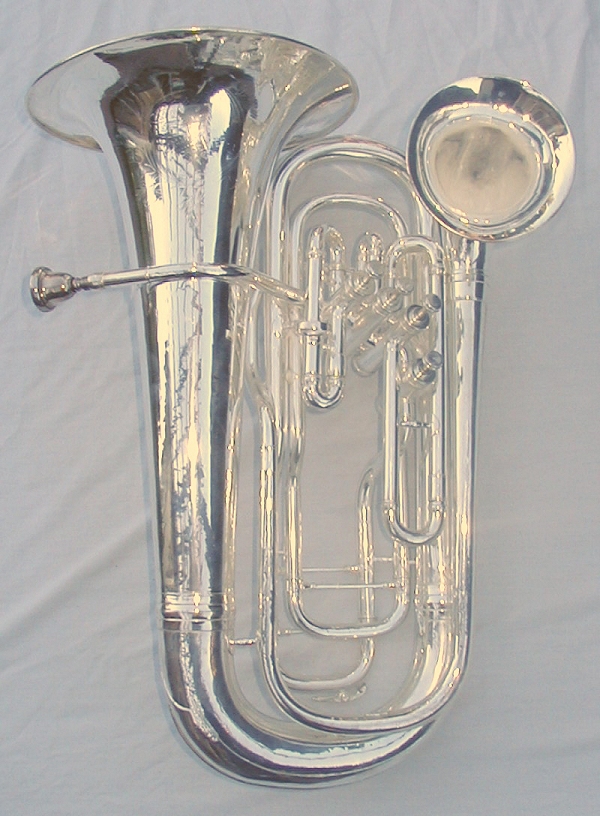 |
| Left: Conn Double-Bell Euphonium: 1880
This is a Double-Bell euphonium made by Conn, well-known specialists in brass instruments. Conn have a very comprehensive Wikipedia page.
It is a development of the standard euphonium, production beginning at Conn in 1880. The main bell gives the mellow tone of a standard euphonium, while the smaller forward-facing bell has a brighter tone, similar to a valve trombone or a baritone horn. The last valve fitted to the horn (the fourth or the fifth, depending on the model) is used to switch the sound from the main bell to the small bell. Both bells cannot play at the same time; usually each bell has its own tuning slide loop, so that the two bells can be matched. It is a rather heavy instrument.
This is not a brilliant image, but the three main piston valves can be seen below and to the right of the smaller bell. Just below them is the fourth valve for selecting which horn is in use.
Double-belled instruments are sometimes described as Duplex.
The Double-Bell euphonium has a Wikipedia page.
|

ANOTHER DOUBLE-BELL-EUPHONIUM
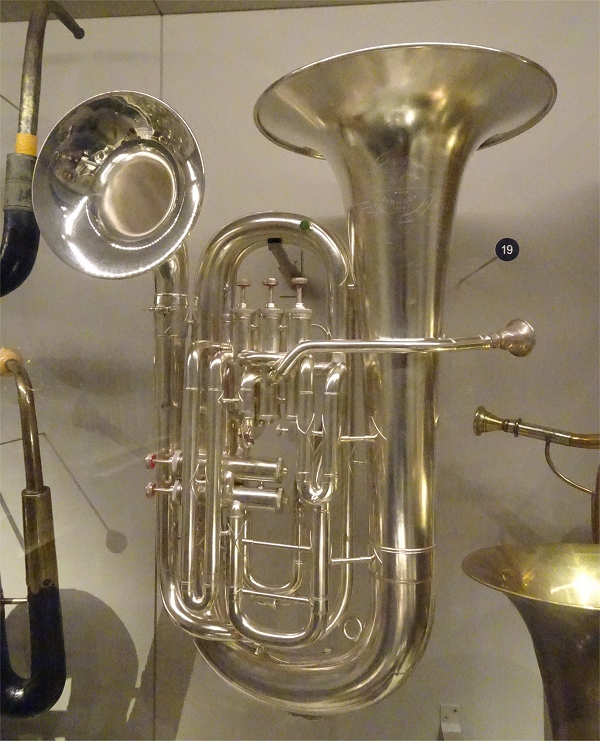 |
| Left: Conn Double-Bell Euphonium: 1927
This is a Double-Bell euphonium in B-flat made by Buescher of Elkhart, Indiana, around 1927. There is only one mouthpiece and only one bell can be used at a time. There are a total of five valves.
Source: Instrument in St Cecilia's Music Museum, Edinburgh. Author's photograph: 15th Aug 2024.
According to the museum; "The larger bell produces a sound like a euphonium, while the smaller sounds like a trombone."
|

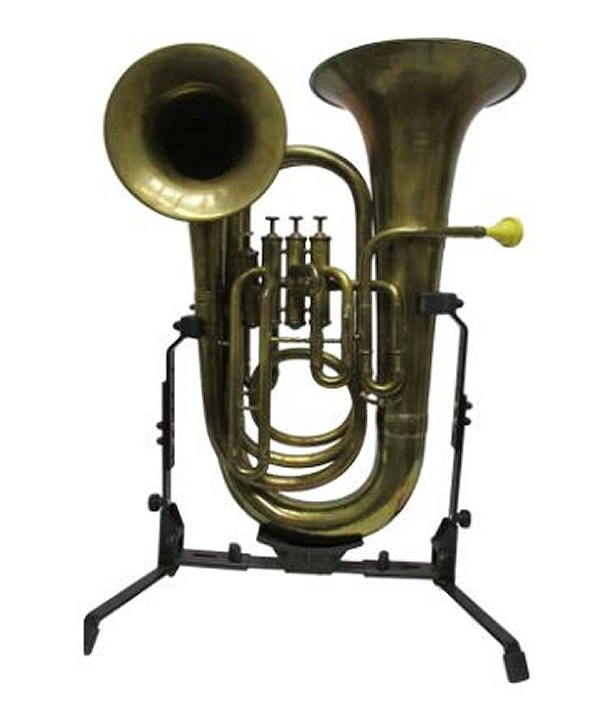 |
| Left: J W Pepper Double-Bell Euphonium on stand: 1900
This picture was found on a website with the glorious name of
The Tuba Exchange, where I discovered there is such a thing as a Compensating Euphonium; there is an explanation of that intriguing phrase here.
J W Pepper only made instruments for some thirty years, and nowadays seem to deal only in sheet music.
|

THE BELLOPHONE
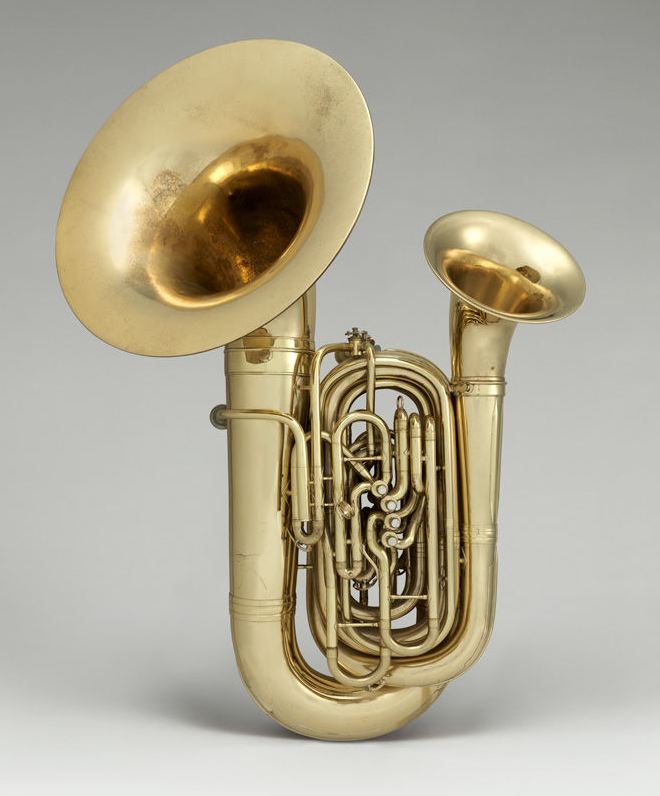 |
| Left: Bellophone in BB-flat: 1930
This engaging piece of complicated brass plumbing is a Bellophone.
"This singular instrument was made to the specifications of the distinguished performer and teacher William Bell, who set modern standards for tuba playing in America." Surely no man was better-named; clearly nominative determinism was at work. It was made by H N White Co, who are now King Musical Instruments.
Players would sometimes need to switch between bass tubas and tenor tubas or baritones in a piece, and this combined the two instruments. Four Périnet valves are shared, and a separate rotary valve directs air to the tuba or baritone part of the instrument.
There was a second mouthpiece so two people can play the instrument simultaneously; I would like to see a video of that, but I have failed to find a video of the Bellophone being played at all. One mouthpiece appears beside the tube on the left, but it is not clear where a second mouthpiece would plug in.
It should not be confused with the Bellowphone, though that too is a multi-belled 'instrument'. It royally screws up searches for 'Bellophone'.
The Bellophone is in the Met Museum in New York.
|
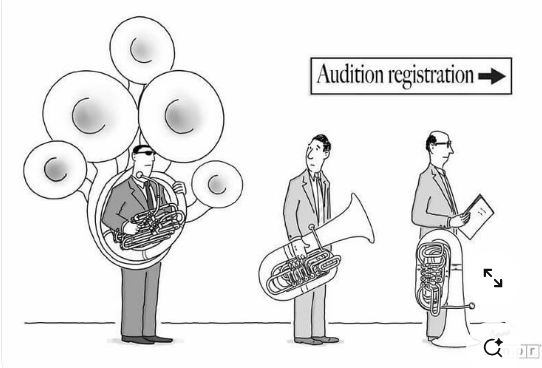 |
| Left: Taking it to more bells
This cartoon takes it to five bells, in fact, sprouting out of what appears to be a Sousaphone.
The date and source of the cartoon are unknown.
|

THE CONTRABASS TUBA
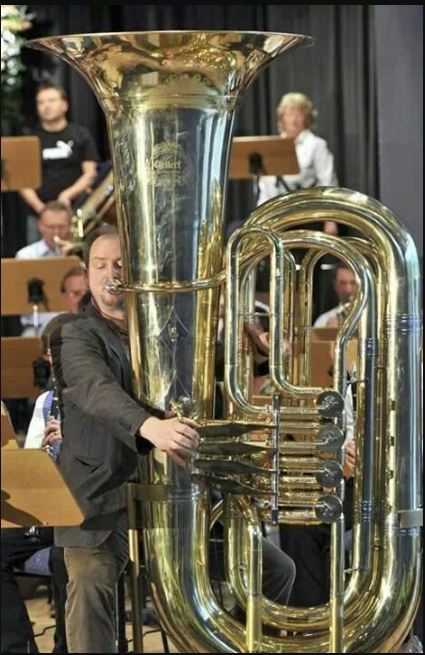 |
| Left: Contrabass Tuba: 15 May 2012
Joerg Wachsmuth of the Dresden Philharmonic gets to grips with 'Flight of the Bumblebee' on what is claimed to be the world's biggest playable tuba, with the Symphony Orchestra of Markneukirchen in Saxony, Germany. This Contrabass Tuba is 2 metres tall and weighs about 50 kg. The bell is 1 metre in diameter, about twice as big as a normal tuba. The tuba sits in a cradle, and the player sits on a high stool next to it.
The 'Flight of the Bumblebee' notoriously has a lot of very fast notes and hardly seems adapted to the contrabass tuba. The Museum Staff have now found a video of the 'Flight of the Bumblebee', here though not on the same occasion as Joerg Wachsmuth is wearing lederhosen. It was also discovered that players of conventional tubas do seem to be drawn to the piece, perhaps as a challenge. That site also has a brilliant video of a 7-tuba pile-up when a marching band gets it wrong.
It is probably no coincidence that Markneukirchen has a Music Museum; it has a Giant Violin, the largest playable in the world, as recorded in the Guinness World Records for 2012. It appears that this Contrabass Tuba normally lives in the museum; it is known as the riesentuba. (giant tuba)
There is no Wikipedia page for the Contrabass Tuba alone, but there is a useful section on it in the Tuba page of Wikipedia.
There is however a Wikipedia page for the Subcontrabass Tuba.
|
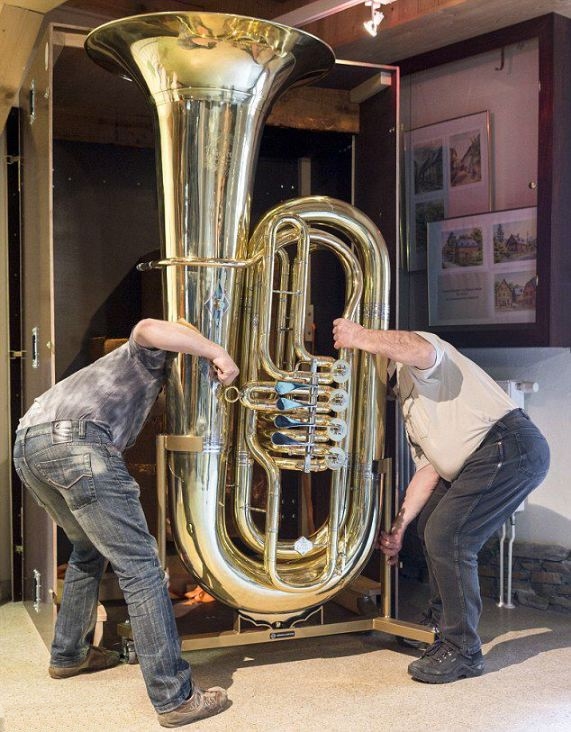 |
| Left: Contrabass Tuba: 2012
Here's the same contrabass tuba in its cradle being put in its transport case. Is it not magnificent?
"Left hand down a bit, Friedrich."
|
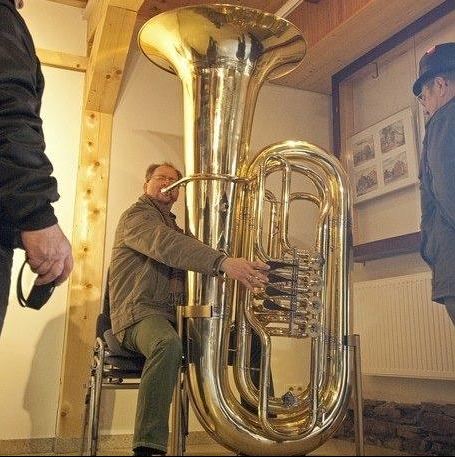 |
| Left: Contrabass Tuba: 2012
The same tuba again, presumably in the Music Museum.
It appears the player is about to be arrested by the Tuba Police.
Note he is sitting on three piled-up chairs to reach the mouthpiece.
|
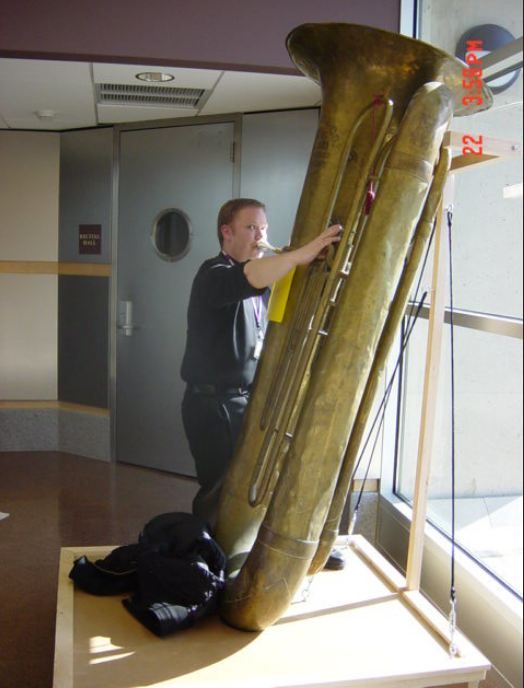 |
| Left: Contrabass Tuba: 2003
This image claims to be of a Subcontrabass Tuba being played at NeRTEC 2003, Amherst, Mass, which is the Northeast Regional Tuba Euphonium Conference.
I am not convinced. Judging by the size I think it is a mere Contrabass Tuba; compare the pictures just above.
Could use a polish.
|
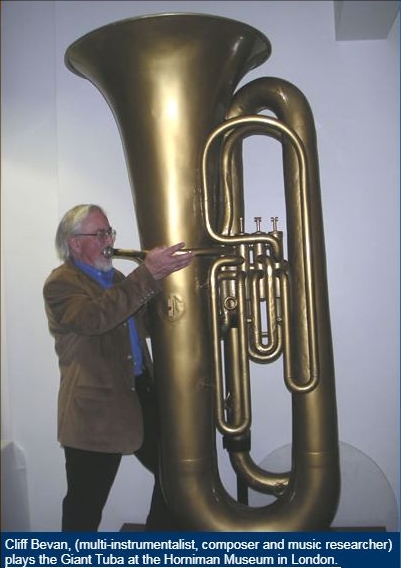 |
| Left: Contrabass not-really-a-Tuba: 2003
The Giant Tuba, was made in the early 20th century by Besson of London. The lowest playable note is Bb three octaves below middle C, which is Bb0 in SPN = 29.14 Hz.
It is effectively an open valve instrument, as the valves do not move, and so it is actually a giant bugle and not a tuba at all. It has over 34 feet of tubing, weighs 112 pounds, and is nearly 8 feet tall.
This giant tuba was built for advertising rather than serious playing. It was originally fitted to the wall of the Besson & Co factory in 198 Euston Road as a shop sign, where it was a music business landmark for much of the 20th century, until 1948. It is now in the Horniman Museum in London.
There is more info here.
|

THE SUBCONTRABASS TUBA
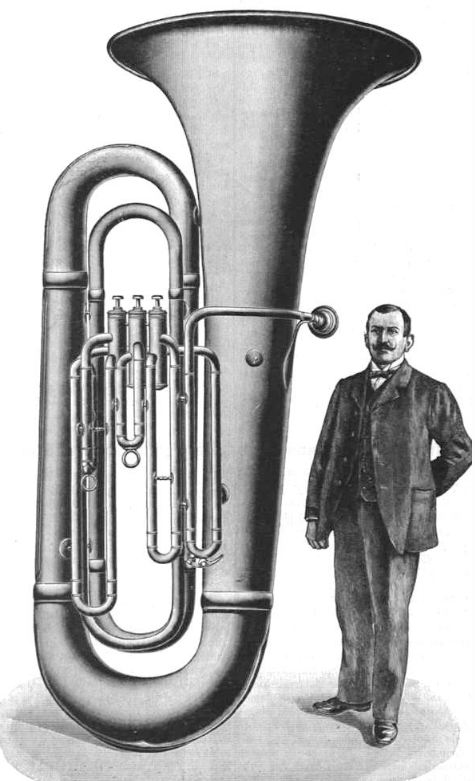 |
| Left: Subcontrabass Tuba: 1911
The Subcontrabass Tuba is a rather specialised taste. It plays an octave or more below a modern contrabass tuba; most are pitched in 36-foot Bb, or Bb-1 in SPN. Only a very small number of these instruments were made, and there appear to be only two playable examples in the world. The first was built by Adolphe Sax, who will be met many times in this gallery; it was a bourdon saxhorn in 52' Eb (which I think translates to Eb-1 in SPN) apparently built around 1862, and exhibited at the Paris Exposition Universelle of 1867.
There seems to be something iffy about the scale of this picture; the mouthpiece looks as though it would cover half the face of the man. Also the water-key looks huge and the piston valves do not seem to be in scale with the man's hand. I have a dark suspicion that this is a picture of a mere Contrabass Tuba (or even a normal tuba) that has been enlarged. The Reader is Warned.
There is a Wikipedia page for the Subcontrabass Tuba.
|
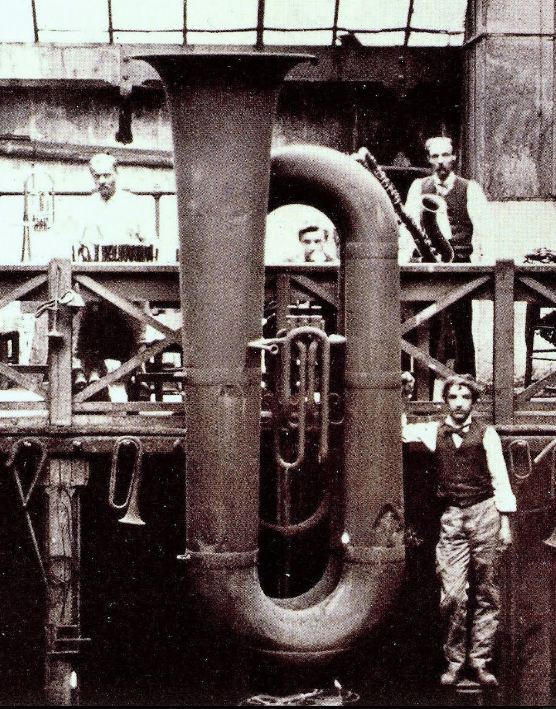 |
| Left: The First Subcontrabass Tuba by Sax: 1862
This really is Sax's bourdon saxhorn, in what is apparently his workshop in Rue de Dunkerque, Paris. If we assume that the man on the right is about 5'6", (people were shorter then) the tuba is about 11 feet tall, or 3.3 metres, significantly larger than the 2 metres of the Contrabass Tuba just above. The length of tubing is 17 metres. Note that it does not resemble the doubtful illustration just above.
The bourdon saxhorn was last heard of in 1877, when it was sold at auction after Sax declared bankruptcy for the third time in his life. It sold for 410 francs to an unknown buyer. It then disappeared, which is odd because it's a big sort of thing to lose.
There is much more information here.
|

BRASS DISPLAY IN PRAGUE MUSEUM
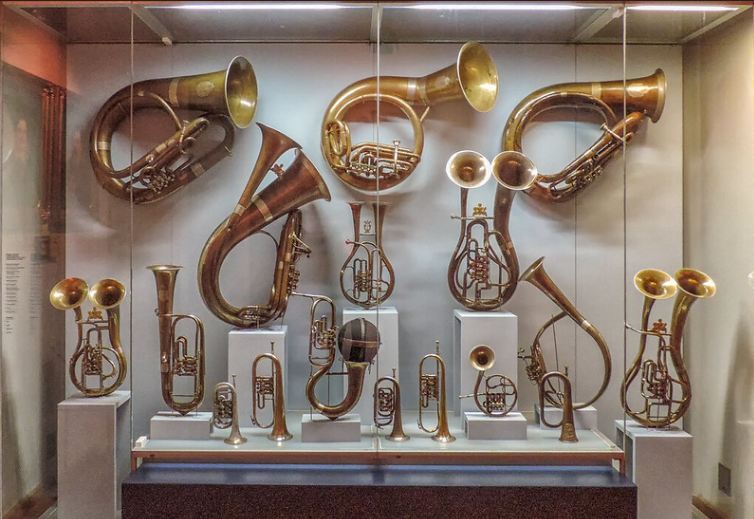 |
| Left: Display of brass in the Czech Museum of Music, Prague:
There are five double-belled instruments in this display in the Czech Museum of Music, Prague. There is a very peculiar single-bell item just left of centre which seems to have a football resting on its bell. It may be some sort of mute.
|

DOUBLE-BELL HELICON
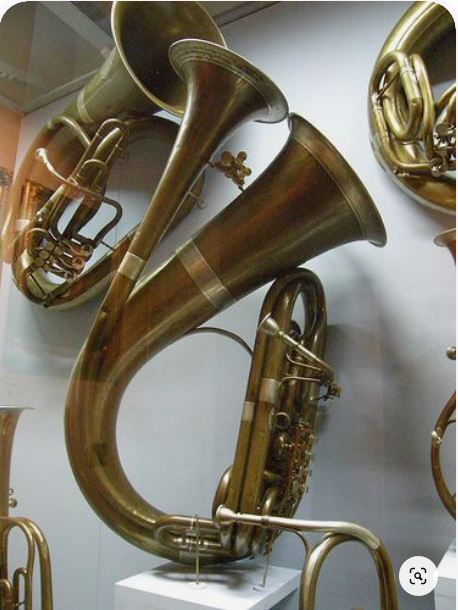 |
| Left: Double-bell Helicon: date unknown
This is a close-up of one of the items in the display above. It is a double-belled Helicon. Apparently Czech versions are called Sediphones, named after their inventor, Josef Sediva, and they were popular in Russian marching bands. Sediva gave a collection of instruments to the Czech Museum of Music, and that is probably what is shown in the display above.
Sediva also invented a deveopment of the helicon called the Herkulesophone.
The Sousaphone was developed from the Helicon.
The Helicon has a Wikipedia page, but double-bell versions are not mentioned.
|
FIVE-VALVE SCHEDIPHON (EUPHONIUM/TROMBONE)
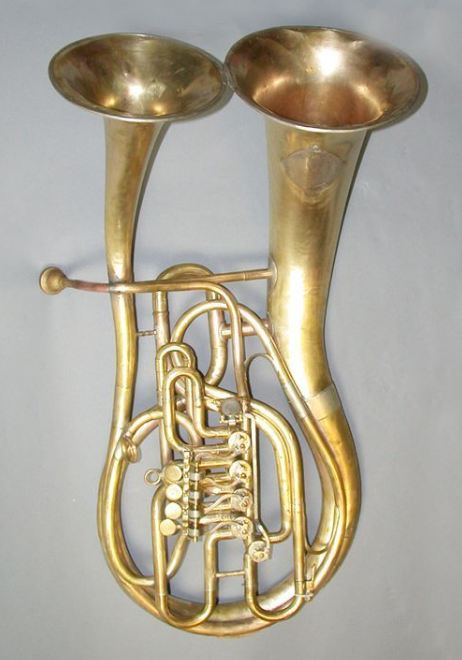 |
| Left: Schediphon with five valves: 1901
This is a Schediphon, invented by Josef Josefovich Schediwa, (1853-1915) of Odessa, Ukraine; we have met him before (spelled slightly differently) as the inventor of the Double-bell Helicon just above. This example was made by Bohland-Fuchs. The Schediphon had two bores of equal length, but differing diameter, apparently giving either a trombone (brighter) or euphonium (softer) timbre. Four of the rotary valves can be seen in the middle of the instrument; above and below these can be seen two interlinked rotary valves that presumably did the bore-swopping.
The Schediphon was patented in 1901, and a subsequent patent (8733) taken out in 1902. It was a development of an 1885 design of the same shape called a Duetton or Lyrophone; searching for the Lyrophone has proved very frustrating, due to the omnipresence of the Lyrophone record company.
There is more info here, and here.
|
 |
| Left: Schediphon with four valves: 1901
Another example, but this only has three rotary valves in the centre. There are still two interlinked rotary valves above and below these.
|
 |
| Left: The band of the 8th Don cossacks: 1905
The image quality here is pretty terrible, but it shows four Schediphons being brandished, and Sediva himself in the centre.
|
FIVE-VALVE TUBA
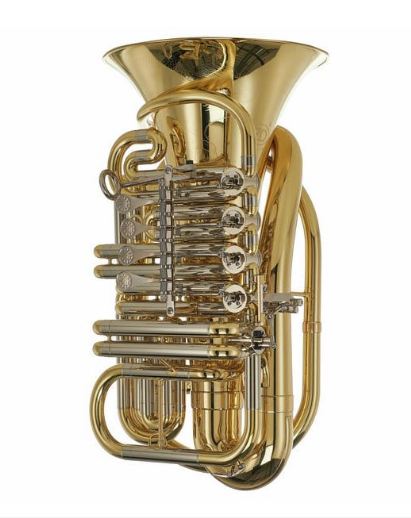 |
| Left: C-tuba with five valves: Now
This is a ZTU-C850L C-Tuba with five rotary valves; an unusually large number; the pipework almost obscures the main bore. C describes the key the instrument is built in; there are also Bb, F and Eb tubas. The bell diameter of this one is 310 mm.
You can buy one at Thomann for a modest £2,866. They also sell alphorns.
|

SEVEN-BELL TRUMPET
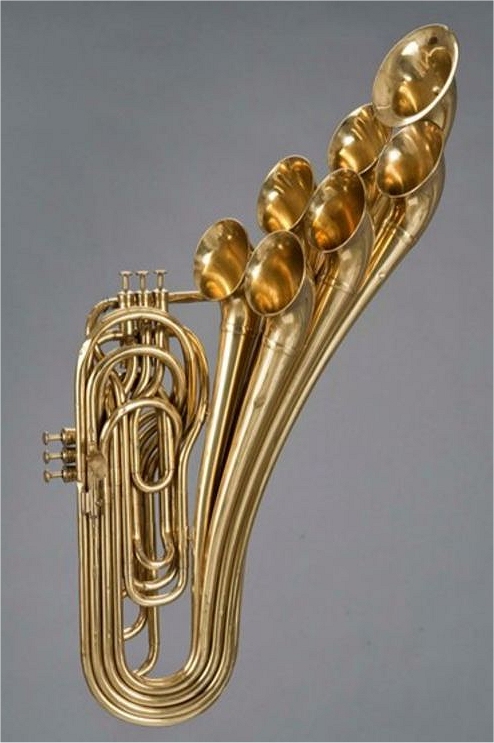 |
| Left: Trumpet with seven bells: 1900?
If you think two bells are too many, prepare yourself for seven. Another invention of Adolphe Sax, this trumpet has separate pipework and bell for each note, to improve the accuracy of the tuning.
This instrument is in the Musical Instruments Museum (MIM) in Brussels.
|
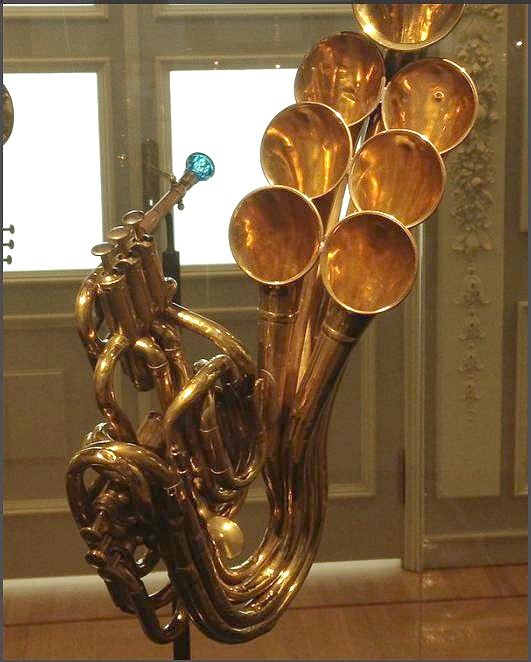 |
| Left: Trumpet with seven bells: 1900
I don't think this is the same instrument as the one above, as some of the pipework looks different. But it is unquestionably a seven-belled trumpet.
In an unknown museum.
|
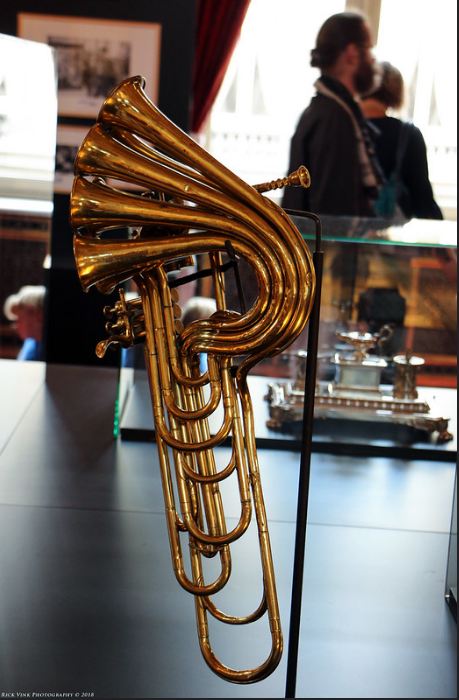 |
| Left: Trumpet with seven bells: 19??
This seven-belled trumpet, clearly a different design, is in the Royal Palace of Brussels, which suggests Mr Sax may have been involved.
|

THIRTEEN-BELL TRUMPET
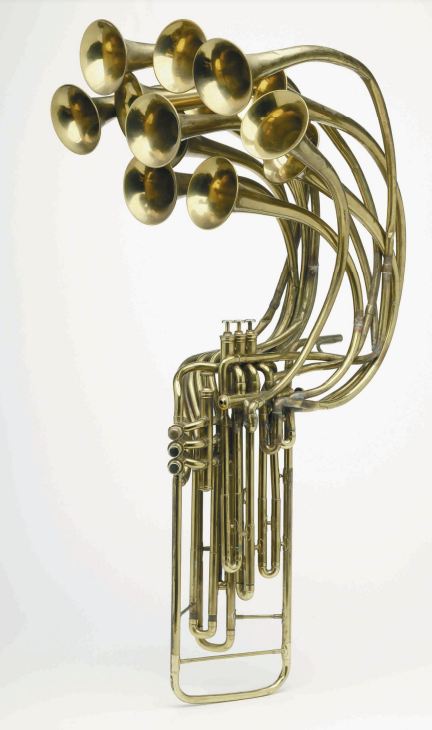 |
| Left: Trumpet with thirteen bells: 1900
You feel seven bells on a Trumpet are excessive? If so, I hope you're braced for the thirteen-bell eight-valve Trumpet. This 4ft-C trumpet is unsigned but was probably made by Adolphe Sax or his son. The mouthpiece goes on the pipe to the right of the upper set of valves.
The idea is that each note has wholly separate pipework, to give improved tuning and intonation. Presumably the valves switch paths on some sort of binary basis.
An obvious disadvantage is the considerable extra weight. It is not entirely clear how you hold it.
This specimen is in the Henri Selmer collection, in Paris. according to them it has eight valves, though only seven appear to be visible in the picture.
|
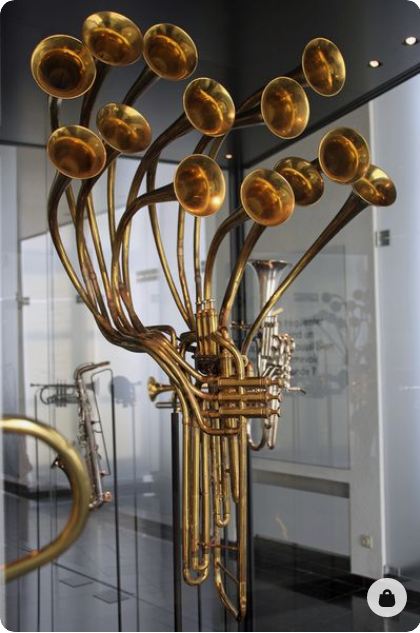 |
| Left: Trumpet with thirteen bells: 1900
It appears there are at least two of these beauties in existence.
This one is in the Museum of Musical Instruments in Brussels, Belgium.
|
THE GANSCHHORN
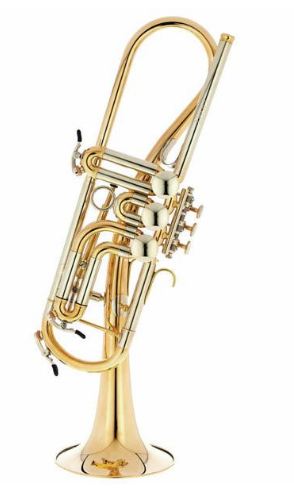 |
| Left: Ganschhorn with three rotary valves: 2012
This is not a trumpet that has been sat on, it is a ganschhorn, which is essentially a trumpet modified to use rotary valves. The tube leading to the bell is bent to make room for them. No mouthpiece is fitted in the photo.
Apparently 'Gansch' is German for 'Goose', and this may be something to do with the shape. But further research indicates that actually it was designed by a Thomas Gansch. Mr Goose?
The ganschhorn was only invented in 2012. There is more info here, and you can hear a ganschorn on YouTube.
|
PICCOLO TRUMPET
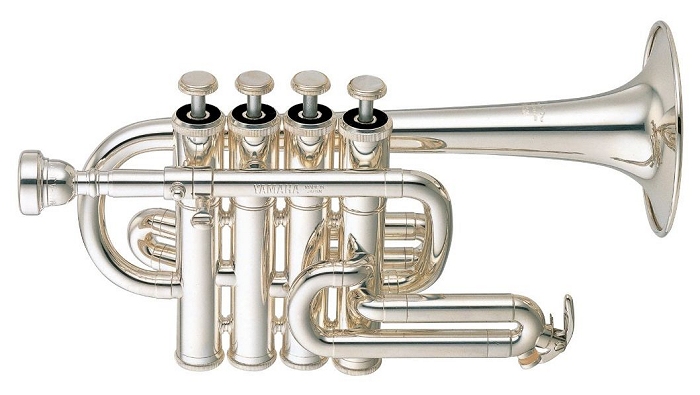 |
| Left: Piccolo Trumpet by Yamaha with four piston valves: now
The Piccolo Trumpet is the smallest member of the trumpet family. The tubing in a Bb piccolo trumpet is half the length of that in a standard Bb trumpet, and so it is pitched one octave higher. Note the unusual position of the water-key, which at present I can't explain.
The most famous use of the piccolo trumpet is in the bridge section of the Beatles song Penny Lane, beginning at about 1:06.
The Piccolo Trumpet has a Wikipedia page.
|
TRUMPET WITH FOUR ROTARY VALVES
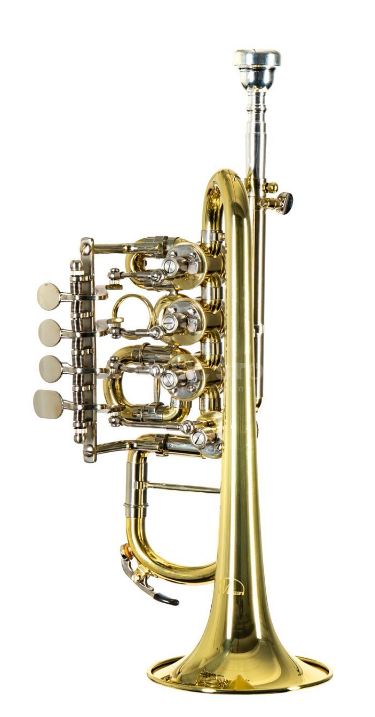 |
| Left: Trumpet with four rotary valves: 2012
This trumpet has rotary valves but is not a Ganschhorn. It is billed as "a cheap High Bb-Trumpet"The advert here says it is "with cylinder valves" which from the look of it means rotary valves. It costs £371.00, which doesn't sound much for a quite complicated device.
|
THE SAXHORN
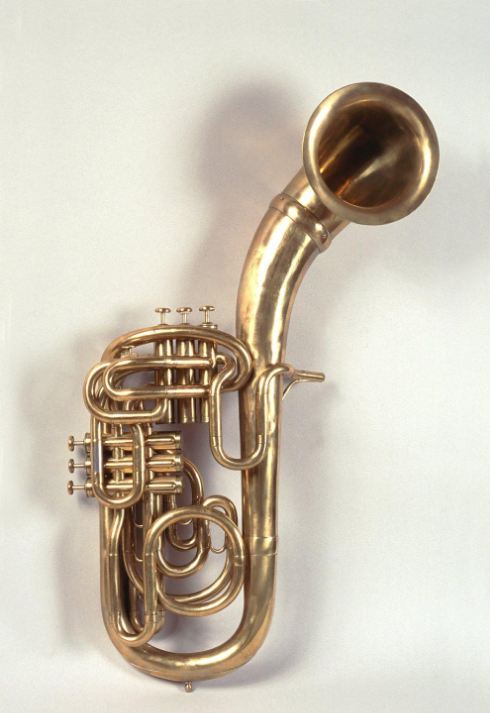 |
| Left: Bass Saxhorn (Saxhorn-basse): 1870
This rather unsettling instrument always reminds me of some aquatic predator sticking its head out of its lair, but it is actually a Saxhorn-basse or Bass Saxhorn. No mouthpiece is fitted in the photo; it goes on the tube to the right of the instrument. It was developed by the famous Adolphe Sax, best known as the inventor of the saxophone. Sax made a wide range of instruments using this system, including saxhorns, trombones, trumpets, cornets and horns. Saxhorns like this appeared in the Banda, or stage band of the Paris Opéra that Sax formed and directed from 1847 to 1892.
The six valves are `independent' valves, used singly to give seven different tube lengths, thus avoiding problems of tuning and intonation when valves are used in combinations. This was one of Sax's innovations. The fingering was therefore quite different from that of conventional brass instruments, and players had to adapt to this. The extra tubing also made the instrument heavier. The bell can be rotated to face in any direction, a pavillon tournant in French; this was patented by Sax in 1859.
This specimen is in the key of C; it is in the University of Edinburgh Musical Instrument Museum, at St Cecilia's Hall.
|
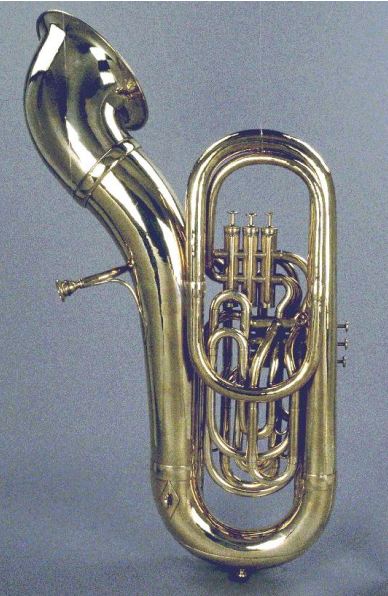 |
| Left: Contrabass Saxhorn: 1864
This is a contrabass Saxhorn, with rotating bell, made by Adolphe Sax in 1864.
Specimen in Musée de la Musique in Paris. I have been there, and it is a very good museum.
|
THE SUDROPHONE
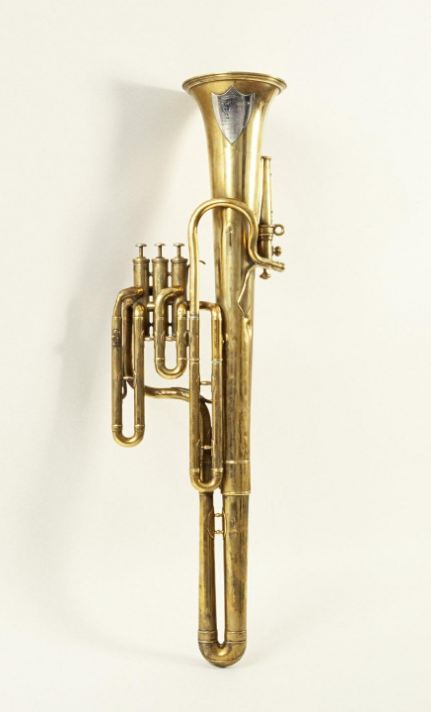 |
| Left: Sudrophone: 1892
Now it's not every day you come across a Sudrophone; it's more than a bit odd. The sudrophone is a brass instrument with a conical bore and three or four piston valves, invented by French instrument maker François Sudre. (1844-1912) He invented a family of Sudrophones running from soprano to contrabass. The concept was patented by Sudre in 1892. (#219518)
The really odd feature is the cylinder, called the mirliton attached to the bell, which is a sort of kazoo-like thing with a silk membrane which creates a nasal or buzzing effect; Sudre intended this to produce a timbre resembling a cello or a bassoon. The membrane connects with the inside of the bell via a rectangular opening that can be opened and closed by the player; (which was probably just as well) when it was closed you got the usual saxhorn sound.
The Sudrophone has a Wikipedia page. You can hear some good jazz Sudrophone on YouTube; you can see a cylinder fixed to the bell, this is the mirliton; as far as I can tell it is not used in the performance.
You can hear a bass sudrophone on Facebook. The mirliton is switched on about half-way through. I'm not convinced it was a major advance in musical technology. The Sudrophone never became popular, and one reason given is that the membrane in the mirliton became wet after a lot of playing, and stopped working.
This specimen is in the University of Edinburgh Musical Instrument Museum, at St Cecilia's Hall.
|
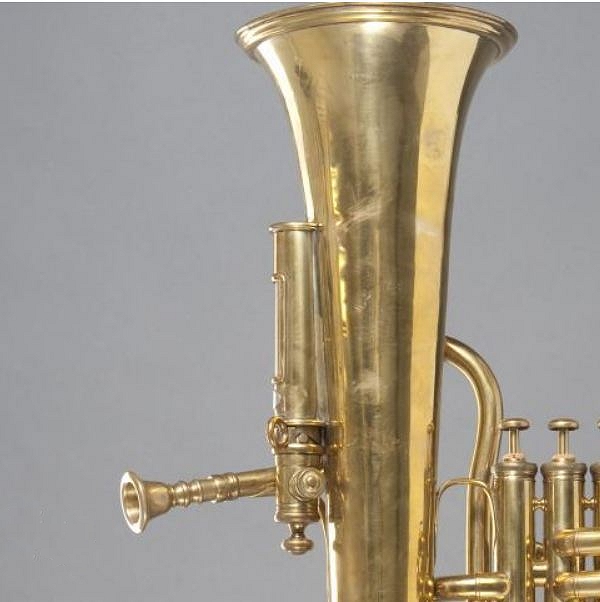 |
| Left: Baritone Sudrophone: 1892
Close-up of the mirliton on a baritone Sudrophone. The swivelling ring that controls it can be just seen above and to the right of the mouthpiece.
The word mirliton is derived from tall hats worn by hussars etc. See Wikipedia. The name was presumably inspired by the fact that the mirliton on the instrument was a vertical cylinder.
I have so far failed to find a picture of a Contrabass Sudrophone. Can anyone help?
|
THE CLAVICOR
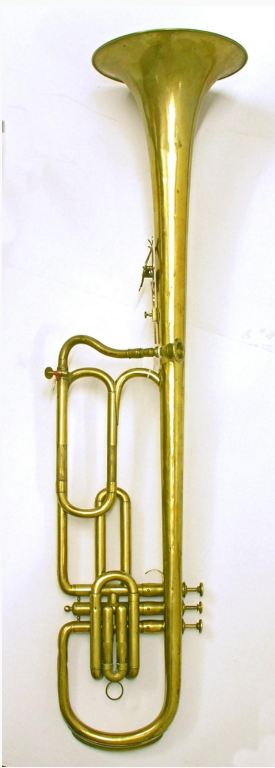 |
| Left: A Clavicor: 1837
The clavicor was invented by H. Danays in Paris in 1837; it was intended to advantageously replace the alto ophicleide. The original design employed three piston valves, later replaced on Köhler's 'Patent Lever Clavicor' with Shaw disc valves. Shaw's valve was meant to address the perceived problem of sharp angles in the tubing; today this is not considered to be a significant issue. Clavicors were made in the keys of C and Eb. It is not currently clear what advantage the original instrument was supposed to have over others.
Not to be confused with the clavichord, which is a stringed keyboard instrument, nor the Clavinet, which is an amplified clavichord.
The clavicor has a Wikipedia page, but it tells you very little.
This specimen is in the University of Edinburgh Musical Instrument Museum, at St Cecilia's Hall. Nominal pitch Eb. Made by Piatet et Benoit.
|
CONTRABASS TROMBONE
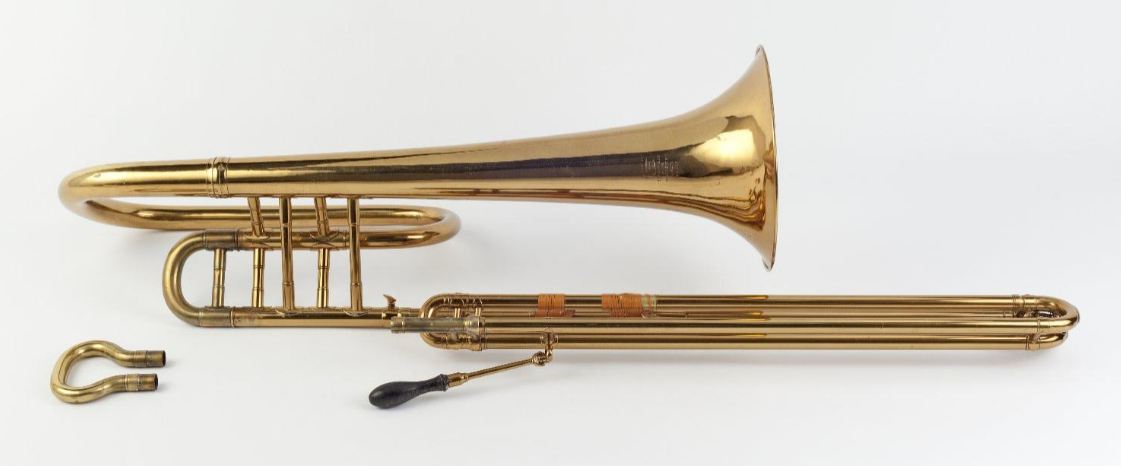 |
|
Above: Contrabass trombone: date unknown
This is a Contrabass Trombone in 16-ft C, Nominal pitch: 16-ft C. Here the bore has a double telescopic section, controlled by a handle, to deal with the increasing pipe lengths as you go contrabass. No mouthpiece is fitted. Note optional crook for changing the key of the instrument.
Specimen in the University of Edinburgh Musical Instrument Museum, at St Cecilia's Hall.
There is more info at contrabass.com.
|
TENOR VALVE-TROMBONE
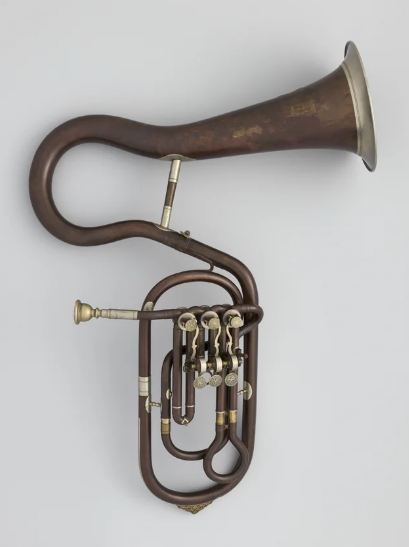 |
| Left: Tenor valve-trombone: date unknown
This item is described as a tenor valve-trombone in Bb. Apparently a brass instrument can be called a trombone even if there is no slide.
It is not clear how you hold it; the upper part looks too high to rest on your shoulder.
By Pietro Borsari (Italy) in 1870. Needs a polish. Badly.
|
THE JAZZOPHON
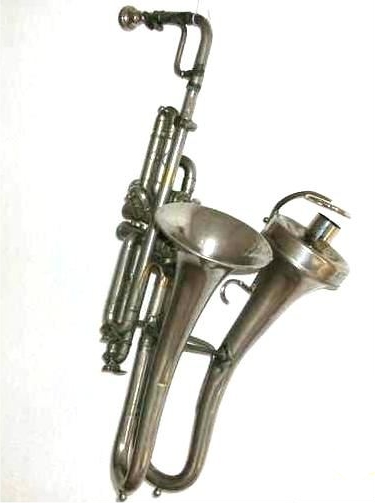 |
| Left: The Jazzophon: 1926
The Jazzophon/Jazzophone was an attempt to make a trumpet-based equivalent to the saxophone. Saxophones were, and are, relatively expensive because of the large amount of complicated keywork, but a trumpet only has (usually) three valves. (I bought my tenor saxophone a few years back for £400, which I think a good price, though I would not claim it is the best tenor sax in the world) The Jazzophon is played with a trumpet mouthpiece, and it was claimed any trumpeter could play it easily.
The key point (apart from the sax-like shape) is the two bells. The Jazzophon has an extra fourth valve mounted underneath. When depressed it switches between the two bells, one of which has a built-in wah-wah mute. The Jazzophon was invented by Richard Oskar Heber (1872-1938) in Germany; the first adverts for it appeared in 1926.
There is a really excellent web page on the Jazzophon here. It also covers the Normaphon, a saxophone shaped trumpet with only one bell, also invented by Richard Oskar Heber. The Normaphon is not blessed with a Wikipedia page, but there is more information on it in Brasspedia, where is also a positive cornucopia (ha!) of odd brass instruments, many of them with double bells.
The Jazzophon has a Wikipedia page, but they spell it Jazzophone.
|
THE NORMAPHON
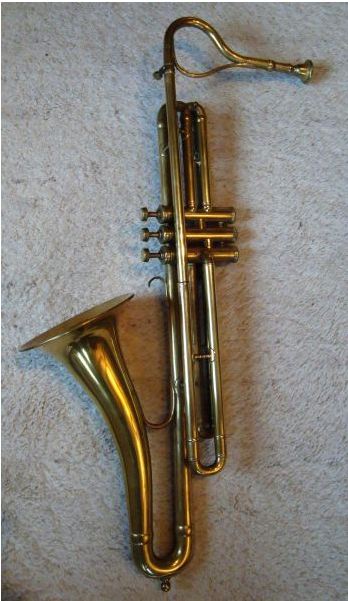 |
| Left: The Normaphone: 1924
The Normaphon/Normaphone was invented by Richard Oskar Heber, like the Jazzophon. (1872-1938). It was a single-bell version of the Jazzophon. It has been stated that approximately 100 Normaphons were built from 1924/25 to 1930, but serial numbers range from 0104 to 0441, suggesting several hundred were produced. They were built in soprano, alto and tenor sizes. It did not catch on.
There is an excellent page on the Normaphon in Brasspedia.
|
THE BALLAD HORN
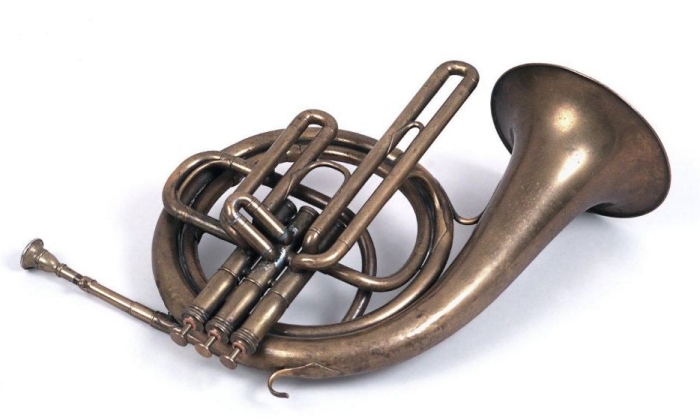 |
| Left: Ballad Horn in nominal pitch C: 1870
The Ballad Horn was invented by Henry Distin around 1870 and was aimed at amateur players; since it was in the key of C it allowed them to play the top line of song or piano music without transposing. It demonstrates the popularity of brass instruments for amateur musicians during the 19th century. It was called the Ballad Horn, because much of what was played on it would be ballads.
The Ballad Horn does not have a Wikipedia page. Shameful.
|
THE VOCAL HORN
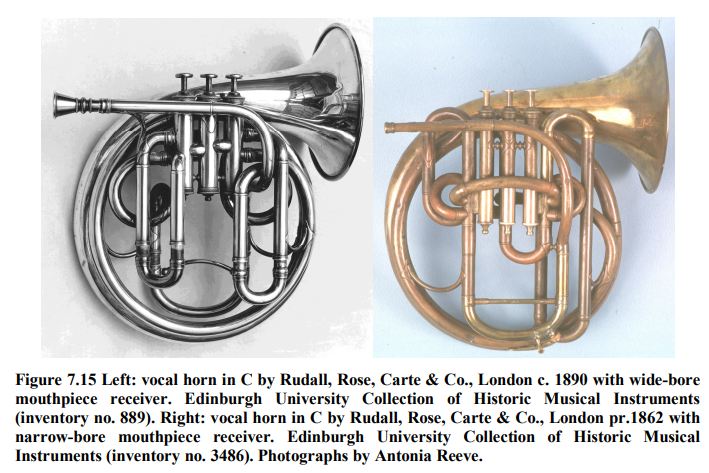 |
| Left: Vocal Horn in nominal pitch C: 1862
The Vocal horn was nothing to do with making an instrument that sounded like the human voice. Like the Ballad Horn above (which it preceded) the idea was to make an instrument that was easy to play and was in the key of C; therefore like the Ballad Horn, there was a great deal of music available without transposing.
The first vocal horns were made by Rudall, Rose, Carte & Co in Great Britain, probably in 1862. The firm was absorbed by Boosey & Hawkes in the 1940s.
The Vocal Horn does not have a Wikipedia page.
|
THE CORNOPHONE
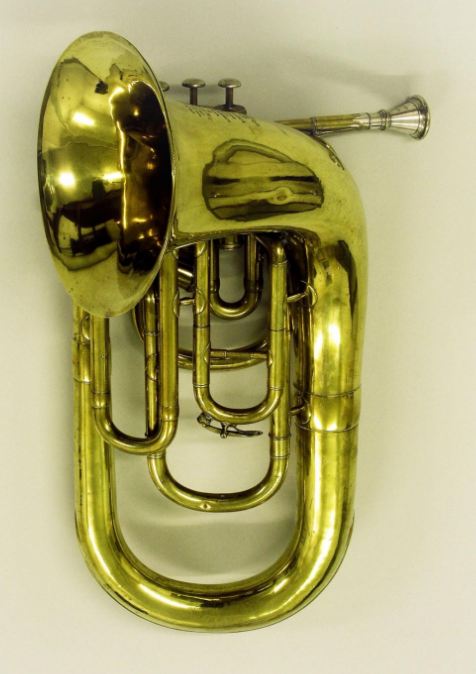 |
| Left: Tenor Cornophone: 1880
The Cornophone was invented by the instrument manufacturer Fontaine Besson (of both in Paris and London) around 1880, in an attempt to create a unified family of brass horns. It is resembles the saxhorn but uses a narrow mouthpiece more like a French horn mouthpiece. As you can see from the relative size of the mouthpiece, the tenor version is quite a small instrument.
The Cornophone also does not have a Wikipedia page, but there is more info here.
|
THE ANTONIOPHONE
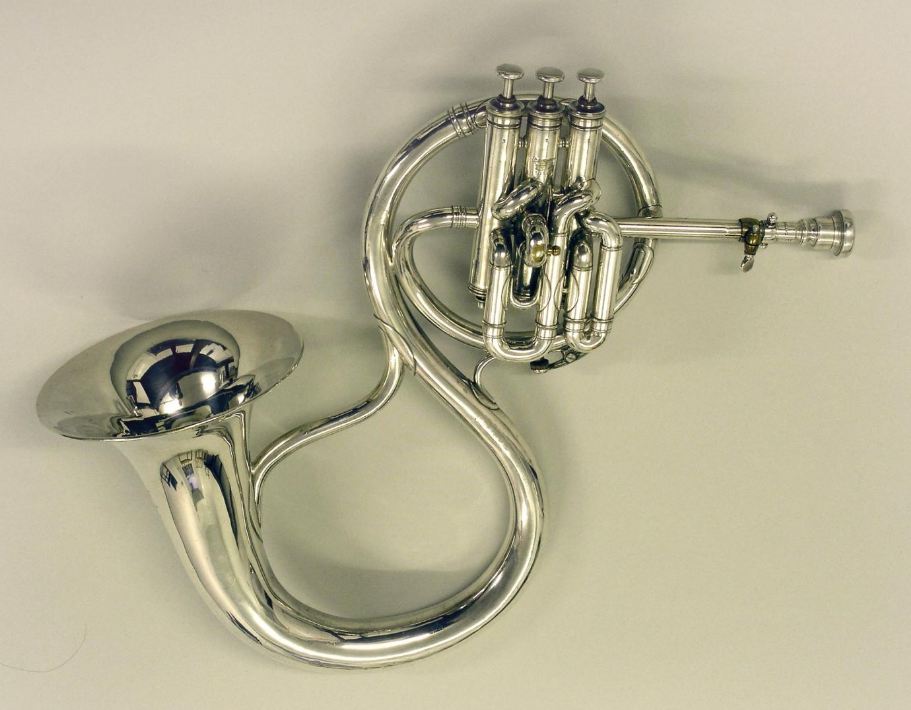 |
| Left: Alto Bb Antoniophone: 1889
The Antoniophone looks rather like a French Horn that someone has tried to unwind, but given up on the job. The bell faces forward and upwards, rather like a saxophone. Its invention is credited to Antoine Courtois, after whom they were named. This example was made by Boosey & Co in 1889.
A review of a concert that took place in Shoreditch, London, in 1872 (in aid of the funds of the Post Office
Orphan Home) reported that Alfred Phasey played a solo "on a new instrument termed antoniophone" that "excited considerable curiosity". The reporter describes the instrument as being "of the same pitch as the Euphonium, but possessing the tone of the Trombone".
The Antoniophone also does not have a Wikipedia page.
|
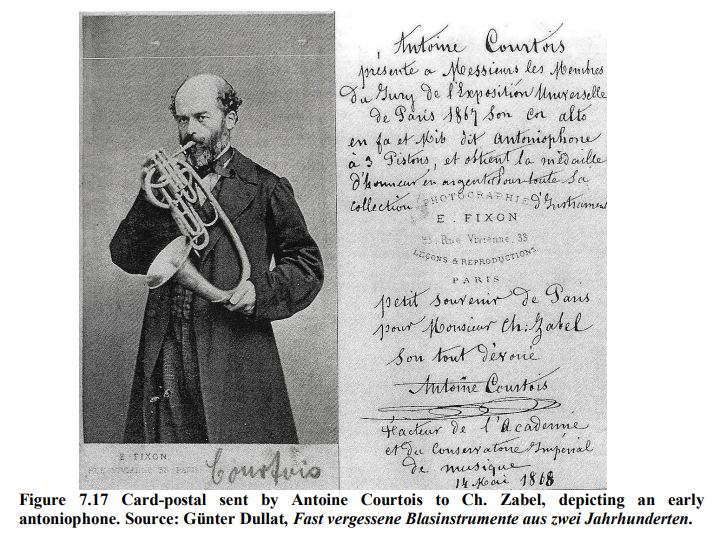 |
| Left: Antoine Courtois with Antoniophone: 1867
The date in the text is 1867.
|
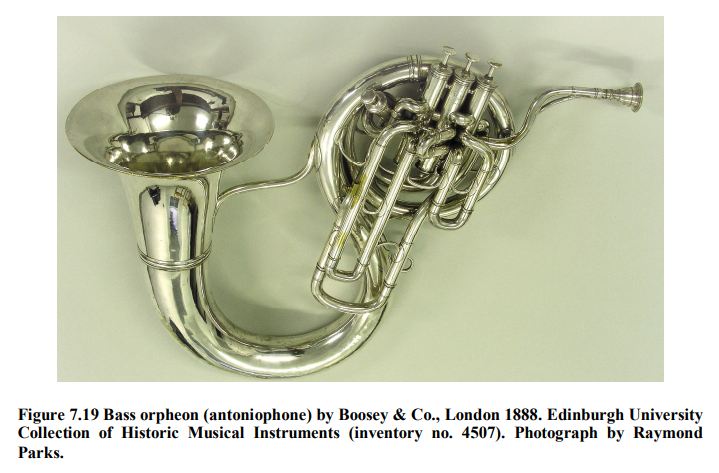 |
| Left: Bass Antoniophone: 1888
|
THE COMPRESSED HUNTING-HORN
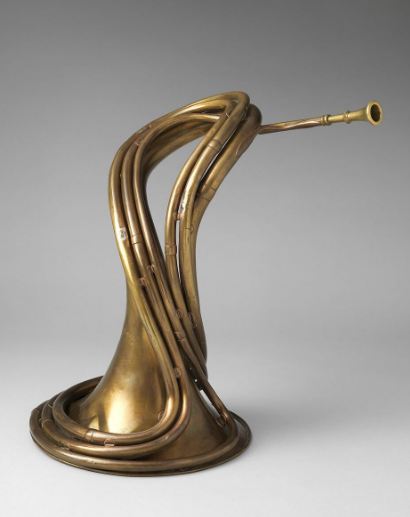 |
| Left: Compressed Hunting-Horn: circa 1862
This is described as a 'Cornet-trompe in D' by the The Met Fifth Avenue museum, who have it. The tubing has been routed to make the horn more compact and easier to carry while hunting on horseback. It is attributed to Alphonse (Antoine) Sax.
On view at The Met Fifth Avenue in Gallery 680.
|
THE OMNITONIC HORN
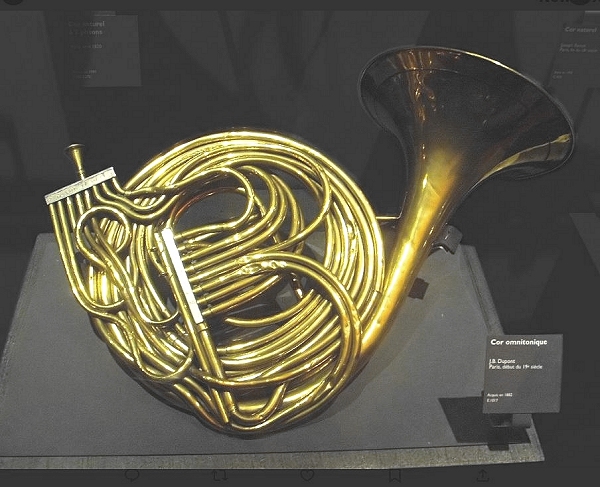 |
| Left: Omnitonic Horn by J B dupont: 1815
The Omnitonic Horn was invented to allow a horn to be tuned into every key without the use of separate crooks, by means of a long sliding multi-position valve. The first omnitonic horn was constructed around 1815 by J B Dupont of Paris, France. Note that the usual valves of a trumpet are not fitted.
As you can see, this involved a lot of brass tubing. The straight pipe at centre-left appears to be the sliding valve that selects one of the lengths of tubing. The brass box near the mouthpiece at upper left is just an 8-way splitter leading to the lengths of tubing. I think.
There is more information here.
There is no Wikipedia page for the Omnitonic Horn (shame!) but there is some info in Wikipedia Commons.
|
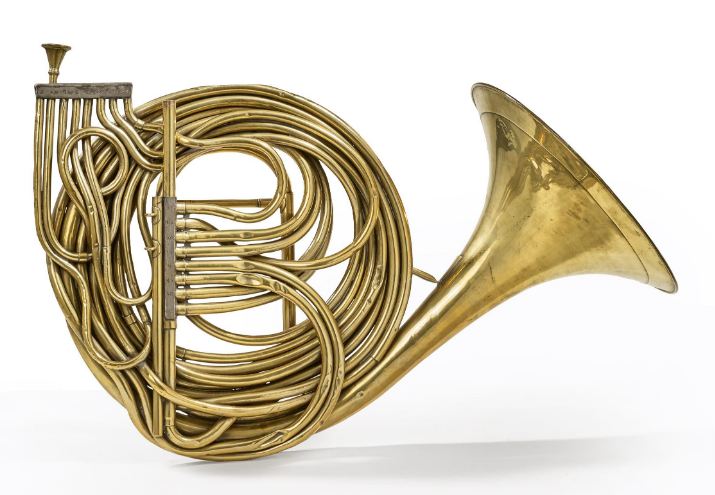 |
| Left: Omnitonic Horn by unknown maker: 18??
Another picture of the same instrument, this time with mouthpiece attached.
|
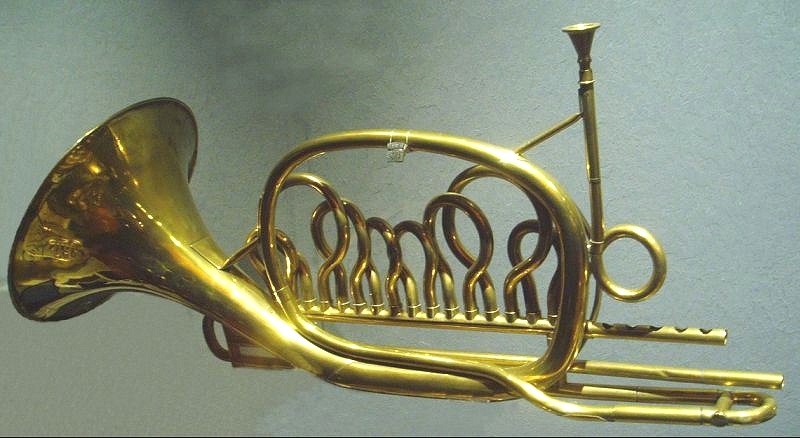 |
| Left: Omnitonic Horn by unknown maker: 18??
Here the sliding valve is under the array of crooks in the centre.
Mouthpiece missing at far left.
|
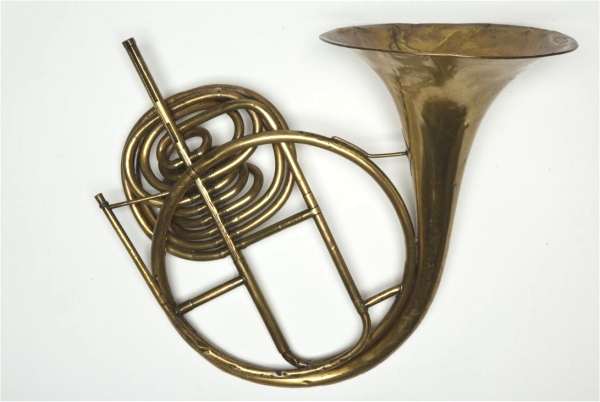 |
| Left: Omnitonic Horn by unknown maker: 18??
A different method of coiling the various pipes.
Mouthpiece missing.
|
THE CADUCEUS-POCKET-CORNET
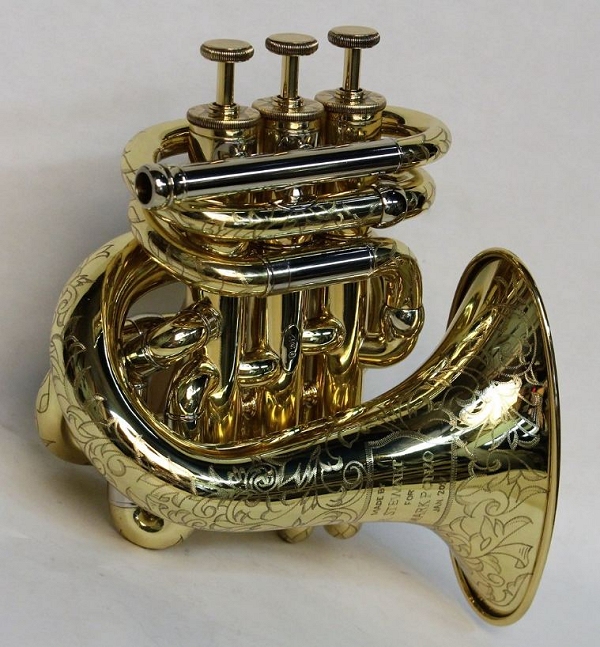 |
| Left: The Caduceus Pocket Cornet: Now
This is a Caduceus Pocket Cornet made by Rob Scott. The instrument was invented by Adalbert Riedl around 1900. Riedl was also much invoved with Echo Cornets.
A Caduceus is the winged staff carried by the Greek god Hermes that has two snakes coiled round it; the reference is to the way the pipework coils twice around the three valves.
There is more info here.
|
THE ECHO CORNET
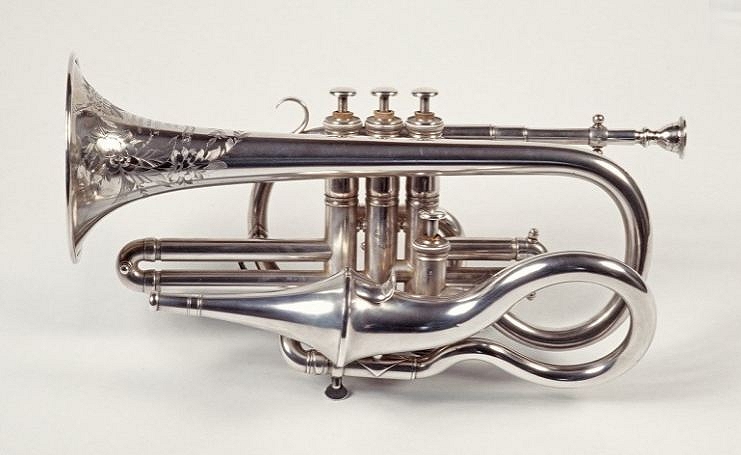 |
| Left: The Echo Cornet: 1883
The Echo Cornet has two bells, one normal bell and a second one which constituted a sort of mute. A fourth valve (below and to the right of the main three valves) switched from normal to muted, so if you played a note on the normal bell and then repeated it on the muted bell, the second note would be fainter and of different quality, giving the effect of a single echo. The muted bell is in the form of a double cone, with a small hole at the left end.
This Echo Cornet is in the nominal Pitch of C, made by F Besson circa 1883. Specimen in the University of Edinburgh Musical Instrument Museum, at St Cecilia's Hall. There is more info here.
One of the most famous cornet solos for the Echo Cornet is 'Alpine Echoes' written by Basil Windsor.
There doesn't seem to be such an instrument as an Echo Trumpet, though there is an organ-stop of that name. There is also an organ stop called the Echo Cornet.
|
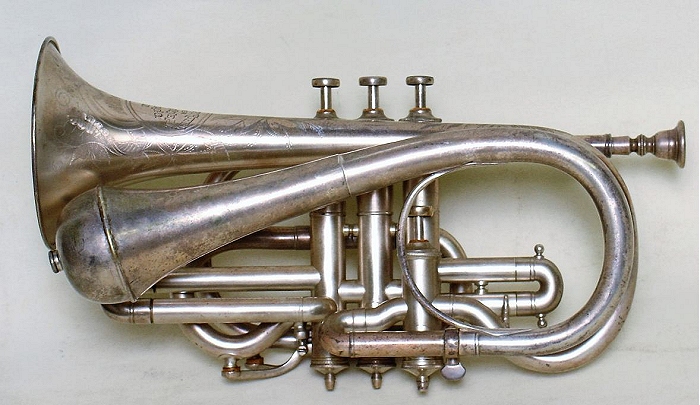 |
| Left: The Riedel Echo Cornet: 1883
This alternative type of Echo Cornet was introduced by Adalbert Riedl; the mute bell terminates in a hemisphere rather than a cone; a sliding tube was inserted in the aperture so the tone-quality could be altered. Reidel was born in Bohemia in 1854 and emigrated to the USA in 1879. He was listed in the 1900 Chicago census as an instrument maker.
|
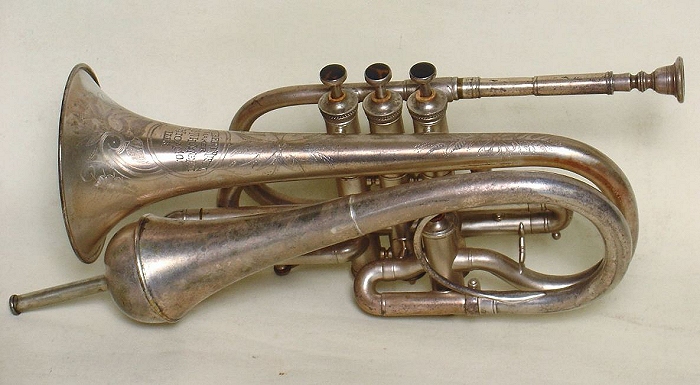 |
| Left: The Riedel Echo Cornet: 1883
Here the sliding tube in the mute bell is extended.
|
THE FLUGEL-CORNET
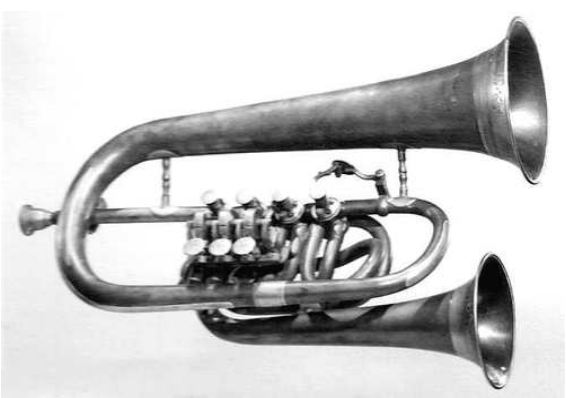 |
| Left: The Pelitti Flugel-Cornet: 1893
This two-belled instrument is a combination of a Flugelhorn and a Cornet, made in 1890 by the Italian instrument maker and inventor Guiseppe Pelitti in Milan, Italy.
A four valve switched between the small bell, (for an open, bright, brilliant tone like that of cornet), and the larger bell which gave a dark, smooth sound.
It is in the collection of the Metropolitan Museum of Art, New York.
|
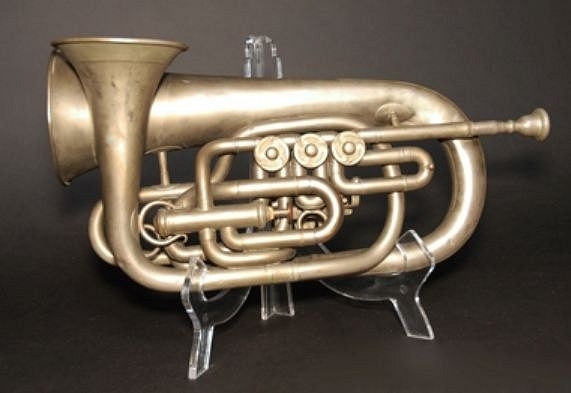 |
| Left: The Rancilio Flugel-Cornet: 1919
Another two-belled Flugel-Cornet made around 1919 by the Italian Dante Rancilio in Milan, Italy.
It is in the collection of the Metropolitan Museum of Art, New York.
|
BAYLEY'S AMERICAN CORNET
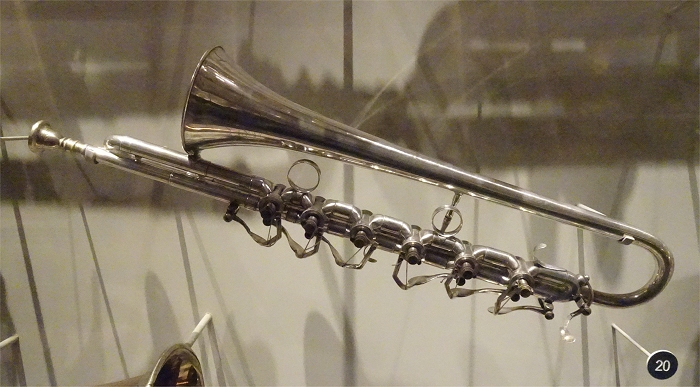 |
| Left: Bayley's American Cornet: 1861
This is an experimental six-valve cornet made by Richardson of Boston USA around 1861. It is in the keys of in C and B. (not quite sure how that works, probably something to do with having six valves rather than three) Unlike conventional cornets, the player used one valve at a time rather than combinations. The valves are Allen rotary valves.
The instrument was endorsed by the English cornet virtuoso John Bayley Senior, but he was not the designer. The instrument was never popular.
Why it would be a good idea to have the horn facing back towards the player has not yet been determined; it would appear to be exactly the wrong direction, and possibly hard on the player's ears. No need for a foldback system here.
Source: Instrument in St Cecilia's Music Museum, Edinburgh. Author's photograph: 15th Aug 2024
|
 |
| Left: Bayley's American Cornet: 1861
The fingering of the cornet is the same as Adolphe Sax's independent valves: the shortest tube length (4-ft C) is obtained by operating the first valve, the next shortest (4½-ft B) is obtained by operating the second valve, and so on. The longest tube length (6-ft F?) is obtained with no valves operated.
Source: Instrument in St Cecilia's Music Museum, Edinburgh. Author's photograph: 15th Aug 2024
There is more info here.
|
THE CIMBASSO
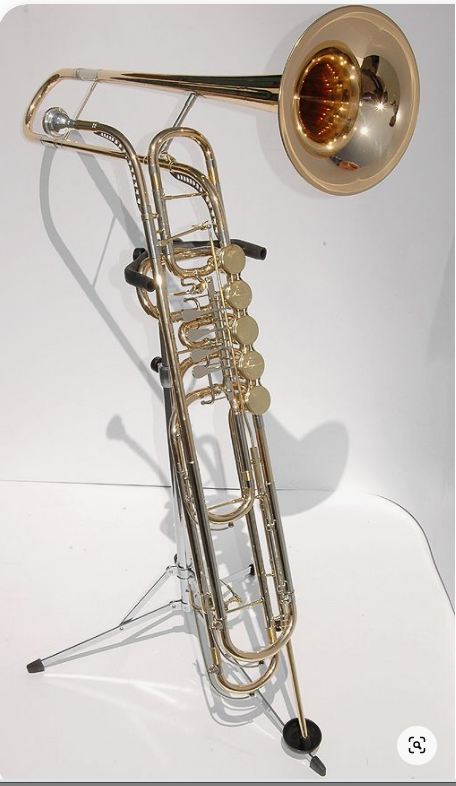 |
| Left: The Cimbasso: Now
This is a Cimbasso, a sort of hybrid between a Trombone and a Tuba. It provides an instrument with the bass range of a Tuba or Contrabass Trombone, but with more of the tonal quality of a Trombone, as its bore is mostly cylindrical. The Cimbasso has a forward-facing bell and is valve operated, usually with 4 to 6 valves, which makes it more agile than a Contrabass Trombone with its heavy slide. This one has 5 valves.
Cimbasso is the popular name for Contrabass Valve-Trombones, most often with vertical valve sections. There is also a Cimbassino, a diminutive Cimbasso; more info here.
In case it's not obvious, the name indicates a diminutive Cimbasso, the popular name for Contrabass Valve Trombones, most often with vertical valve sections.
I do like the two curved perforated girders towards the top of the instrument.
The Cimbasso is not obsolete; it has been increasingly been used in film and video game soundtracks to get an ominous low brass sound.
The Cimbasso has a good Wikipedia page.
There is more info here; there is a YouTube of the sound of the Cimbasso at the bottom of the page.
|
THE FLUBA
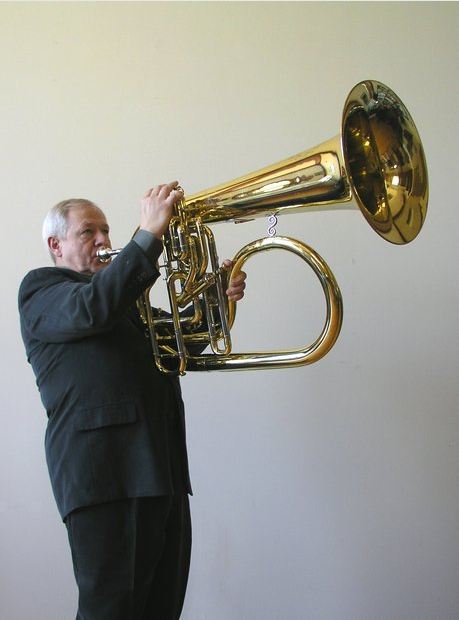 |
| Left: The Fluba: now
The Fluba is what you might expect- a hybrid instrument that is partly Flugelhorn and partly Tuba, invented by Jim Self, who is no relation. Essentially it's a Tuba-sized Flugelhorn.
It looks far from balanced, and a difficult thing to hold up.
|
THE CONTRABASS BUGLE
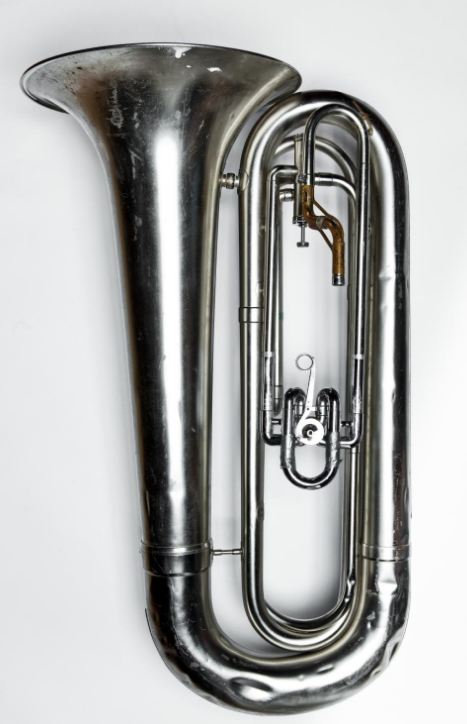 |
| Left: The Contrabass Bugle: about 1970
The Contrabass Bugle is a sort of tuba. It is essentially a marching band instrument, and is carried on the shoulder.
This version is in 21-foot G, which I think is G0 in SPN. It was made by F E Olds & Son around 1970.
It is made of matt-chrome plated brass, with the bell section detachable. It has two valves; 1st valve is a rotary type, (the lower one) and the 2nd valve a Périnet type. The mouthpiece is missing.
The Contrabass Bugle has a Wikipedia page.
Source: University of Edinburgh musical instrument collection
|
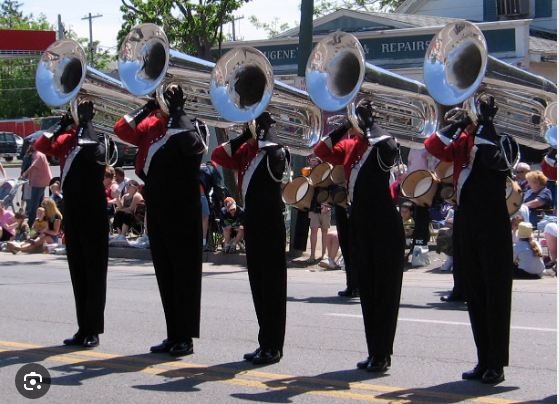 |
| Left: Carrying the Contrabass Bugle
This how you carry your Contrabass Bugle.
|
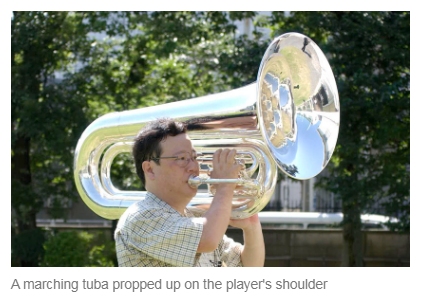 |
| Left: Carrying the Contrabass Bugle
Another view of how to carry your Contrabass Bugle. I assume there's some sort of pad between the bugle and the shoulder.
'Marching tuba' is an alternative name.
|

THE PHONOGRAPHIC CORNET
 |
| Left: The Phonographic Cornet: date unknown
One of the odder instruments in this collection is the Phonographic Cornet, a sort of pianola-roll operated harmonica. (I am assuming it was free reed instrument)
Is that some sort of odd mouthpiece or an exceptionally luxuriant moustache?
Google yielded nothing, with the results dominated by Hagerman Audio Labs Cornet MM Phono Preamp.
Source: the book Clockwork Music by Arthur Ord-Hulme. Pub: George Allen & Unwin, 1973
|

SCULPTURE
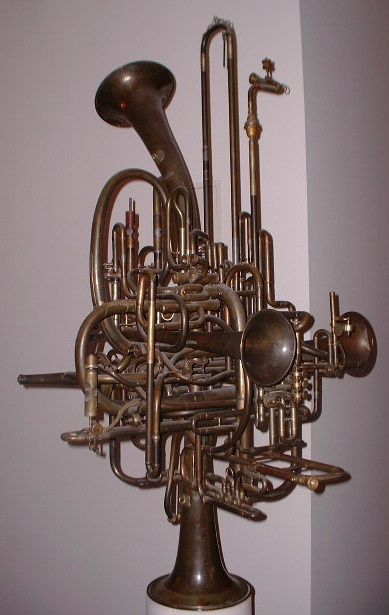 |
| Left: Sculpture made of brass instrument parts: date unknown
No, it's not a musical instrument, though after perusing this gallery for a while you might well think it is. It is a sculpture in the Grand National Hotel in Lucerne, Switzerland, made up of random brass instrument parts. I count at least three bells, not counting the one acting as a stand.
Needs a good polish.
|

WOODWIND
THE COUESNOPHONE
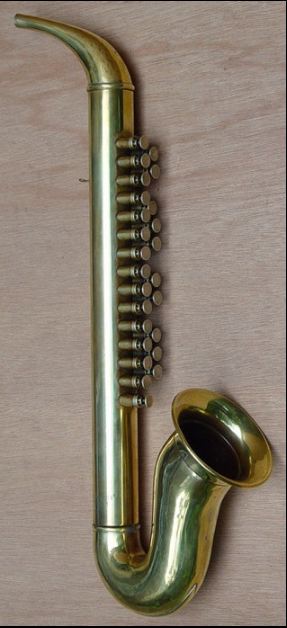 |
| Left: Couesnophone by unknown maker: 1924
The Couesnophone (pronounced 'queenophone') was invented and patented by the French instrument maker Couesnon in 1924. It was more commonly called the "goofus", perhaps because it was easier to say, or more likely because a 'queenophone' doesn't sound like a very manly instrument.
Couesnon described it as a saxophone jouet (toy saxophone) suggesting it was not intended as a serious musical instrument. Nontheless it was made popular in the 1920s by Adrian Rollini, who even recorded in a band named after the instrument.
The Couesnophone is a free-reed polyphonic instrument in a saxophone shape, with valves arranged like the keys on a piano. It is very similar in principle to a Melodica. I have one. (A Melodica, not a Couesnophone) If anyone thinks the Melodica is not cool, I have seen Donald Fagen play one, and I'm not going to argue about what's cool with him.
The Couesnophone has a Wikipedia page.
You can hear a Couesnophone on YouTube; the solo starts at 1:48. To be honest it doesn't sound very impressive; rather thin and reedy, with a definite hint of Melodica about it.
|

THE HARMONI-COR
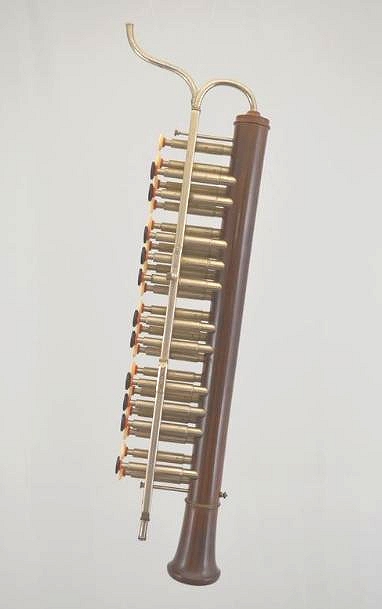 |
| Left: Harmoni-Cor Julain: 1924
This Strange Device is a Harmoni-Cor, essentially another forerunner of the Melodica.
The Harmoni-Cor was invented by Louis Julien Jaulin.and patented by him on 31st December 1861. It was supposed to be an easy-to-play substitute for the oboe and cor anglais.
The Cylindrical body is of mahogany. The brass cylinders hold the free reeds, and are arranged as a keyboard, (Just like a Melodica) with the activating push-buttons being made of ivory and ebony. It covers two and a quarter octaves. (28 notes from B to D) The player blows in one end or the other of the narrow tube (which is apparently made of lead, which doesn't sound very healthy) allowing two different playing positions, with the horn pointing up or down. Ingenious.
The total length of the instrument without the lead pipe is 540 mm.
You can hear an Harmonicor being played on YouTube. It sounds quite pleasant, and yes, very much like a Melodica.
|
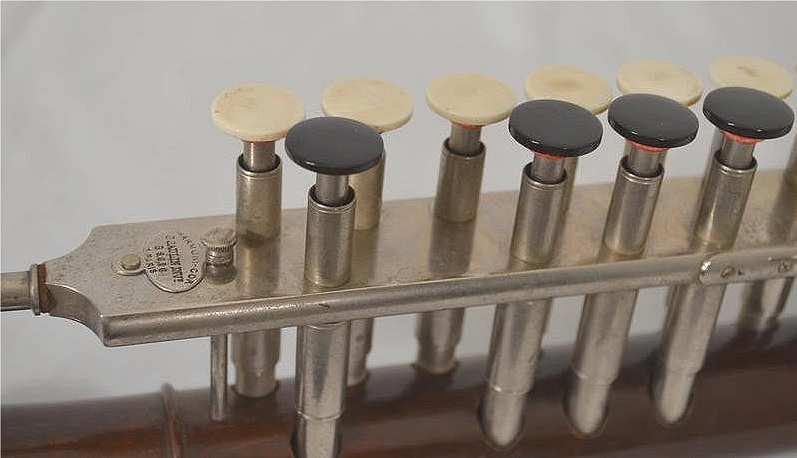 |
| Left: Harmoni-Cor Julain: 1924
Here is a close-up of the 'keyboard' of the Harmoni-Cor above. The flat metal box distributes the air to the piston-valves. Note the metal pillar connecting the box to the wooden body of the instrument.
The riveted nameplate on the left of the distribution box reads:
HARMON-COR; L JAULIN INV; 1861; PARIS.
|
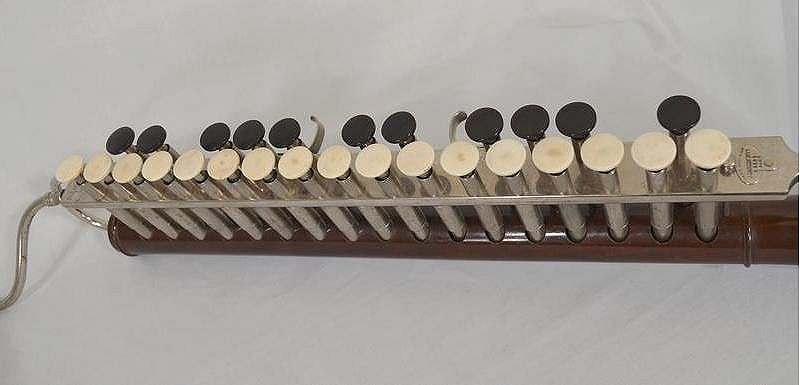 |
| Left: Harmoni-Cor Julain: 1924
At the middle of the Harmoni-Cor and on the side away from us are two curved metal hooks pointing in opposite directions. These are presumably thumb rests; there are two because this Harmoni-Cor could be played either way up.
|
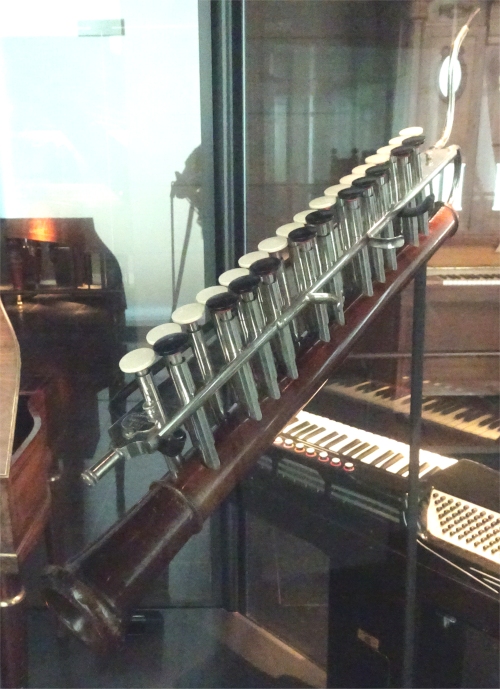 |
| Left: Harmoni-Cor Julain: 1924
This is a Harmonicor displayed at the Musical Instruments Museum in Brussels, Belgium; it is attributed to Julien Julain. (1861-1900)
It is probably this instrument in the pictures above.
|
 |
| Left: Harmoni-Cor Julain: 1924
This is a different example of the Harmoni-Cor; the flat air distribution box appears to be much closer to the wooden body, and this may be because the support pillars are missing. Note that it is held together with some string. There is only one pipe for blowing it.
Some of the keys are missing. So is the riveted nameplate. The fix hole for one of the pillars is visible to the right on top of the air box.
|
 |
| Left: Harmoni-Cor Julain: 1924
This is another different example of the Harmoni-Cor; this one has a single pipe for blowing.
There is an inscription stamped both on the bell and on the metalwork: RIVIERE & HAWKES/28 LEICESTER SQr/LONDON
This instrument is in The Horniman Museum in London.
|
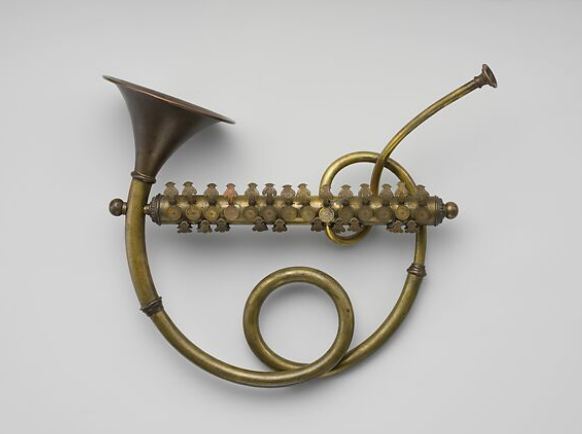 |
| Left: Harmoni-Cor?
According to the Met Museum of Art in New York, this is also a Harmonicor, though it bears little resemblance to the Harmonicors shown above.
The central cylinder has twenty-four keys, under which twin reeds respond to pressure and suction. There is a long tube between the reed cylinder and the horn.
This instrument is in The Met Museum in New York.
|
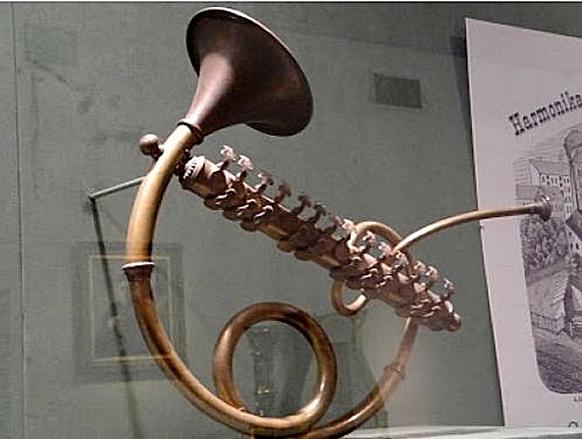 |
| Left: Harmoni-Cor?
Here is the instrument displayed in the Met Museum of Art in New York. They say the instrument had forerunners in the shape of the Psallmelodicon and the Symphonion. The former seems to have been some sort of blow-accordian. (see below) The Symphonion appears to have actually been a musical box, and I'm having doubts about the info provided by the Met...
|
THE PSALLMELODICON
 |
| Left: A Psallmelodicon: 1828
The Psallmelodicon (or Psallmelodikon) was a free-reed instrument and an early forerunner of the Melodica. According to some authorities it was invented by J. Weinrich & H. König of Heiligenstadt in 1828, but see the section on the Clariophone just below.
This Psallmelodicon has a flame-maple body, 6 fingerholes plus 2 thumbholes bushed with ivory, and 25 German-silver saltspoon keys. The curved levers visible from the side are keys and not thumb-rests. The reeds were of German silver which resists corrosion. The mouthpiece was of ivory.
There is some more info on the Psallmelodicon and related instruments here.
|
THE CLARIOPHONE
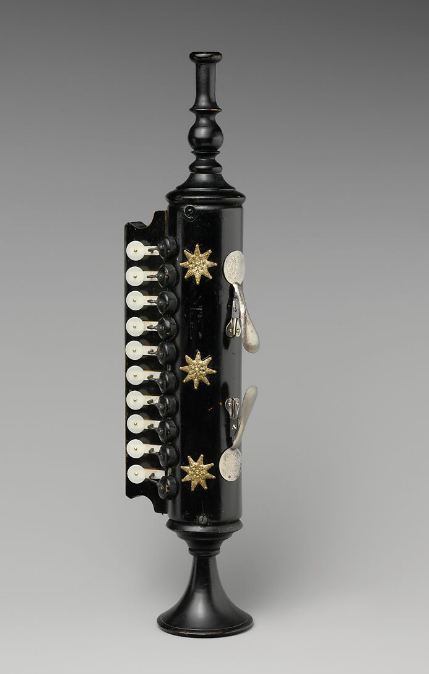 |
| Left: Clariophone: 1828
The Clariophone was another forerunner of the Melodica. Here is the instrument displayed in the Met Museum of Art in New York. They describe it as a late version of the Psallmelodicon, and say it was invented in 1828 by Johannes Weinrich, a poet and shoemaker living in Heiligenstadt, Germany, but this contradicts the information on the Psallmelodicon just above. He is said to have attempted to make the Psallmelodicon an orchestral instrument by giving it the chromatic range of the Oboe.
It is not yet determined if this instrument gives different notes on sucking and blowing. A Melodica responds to blowing only.
There is also a kind of music box called a Clariophon. Its media is most unusual: a lead sheet with raised dimples to activate the notes. The interchangeable sheets are wrapped around a wooden barrel for playing.
|
BLOW-ACCORDIANS
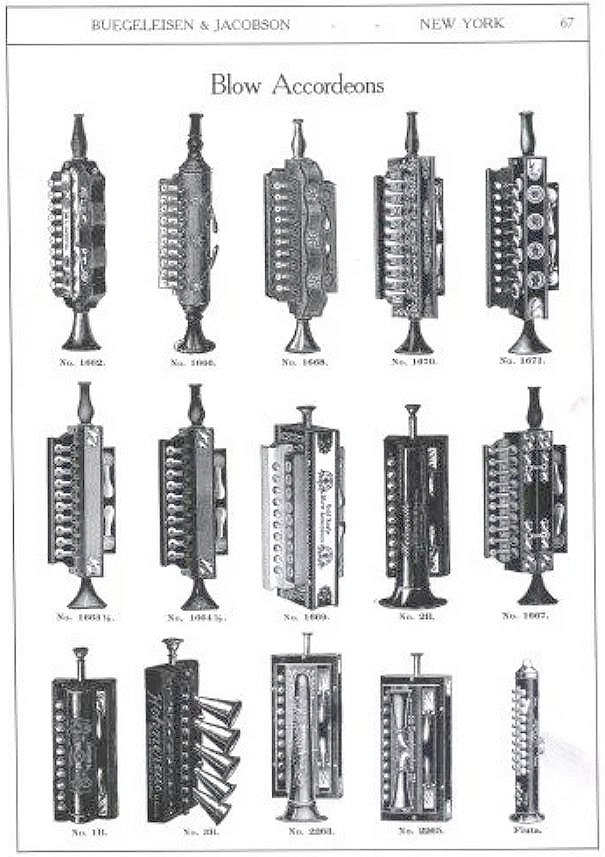 |
| Left: Blow-Accordians in a catalogue
The Clariophone (just above) is sometimes described as a 'blow accordian'. It quickly became clear to the Museum Staff that this term covered a lot of instruments, from harmonicas to push-pull accordians with an added mouthpiece for blowing. At left is page 67 from a catalogue issued by Buegeleisen & Jacobson, well-known musical instrument distributors in New York. (Founded 1901) The date of the catalogue is currently unknown.
In the bottom row the instrument second from left has five small horns. The third from the left (middle) instrument has one big horn, and the one to the right of that has two amall horns. At extreme right is a much narrower model that looks quite like a modern Melodica.
Most of these instruments have two big keys on the opposite side of the body to the main keyboard. I have encountered a statement that these are for the tonic and dominant notes of the instrument scale, but I am not sure if that makes sense. Can anyone help?
|
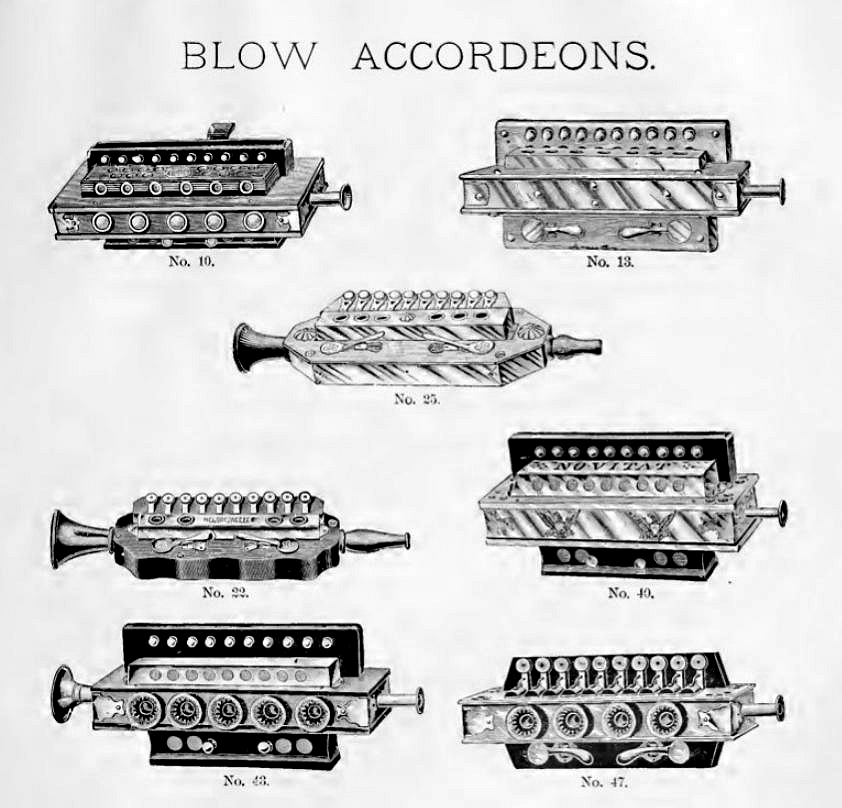 |
| Left: Blow-Accordians in a catalogue
Once again, most of these blow accordians have two big keys in addition to the main keyboard.
The two instruments at the bottom also have round features of unknown function.
|
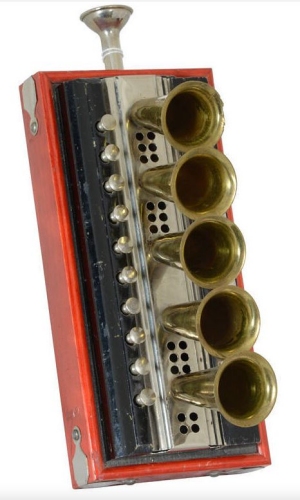 |
| Left: Hohnerette 3B Blow-Accordian: 1910
Here we focus on one instrument, a German Hohnerette 3B with 10 right-hand buttons and two left-hand thumb keys. It has a cup mouthpiece and five brass horns.
The Hohner company was and is based in Trossingen, Germany.
The length of the wooden base is 21.5 cm.
|
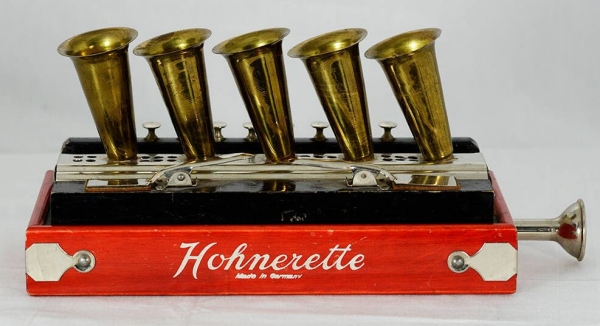 |
| Left: Hohnerette 3B Blow-Accordian: 1910
Here the two left-hand thumb keys can be seen on the top surface.
|
THE MARTIN HORN
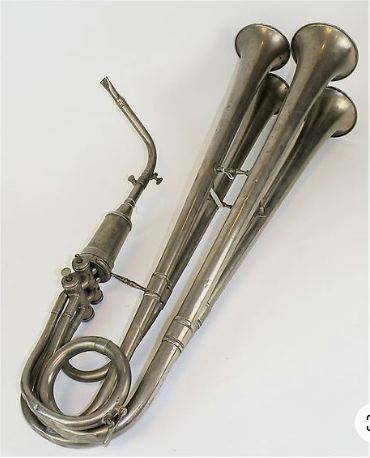 |
| Left: A Bass Martin Horn: 1907
There seems to be an endless procession if instruments I had never heard of. This unlikely-looking four-belled machine is a Martin Horn, valved with free reeds. Each bell gives only one note. There are two valves which select the note, presumably on a binary basis, routing air to the correct reed. There are many versions, some with only four notes, and some are chromatic with 16 notes.
The Martin horn was introduced by Max B Martin. The Martin company originally produced railway signalling horns, then a 4-tone car horn. Adding valves produced a basic musical instrument. Production began in 1907. It was popularised as a band instrument in the 1920s by the German communist party. The Martin Horn is still played by bands in Germany today, and the Martin company still exists, making signalling trumpets and signalling horns for railways etc, and apparently still making musical horns; see here. A Martin Alt Schalmei 16-tone chromatic horn will set you back 1,860 Euros. I've ordered a dozen.
In German they are called Schalmei. (Shawms)
There is some more info here, and a very fine collection of Martin horn pictures here.
|
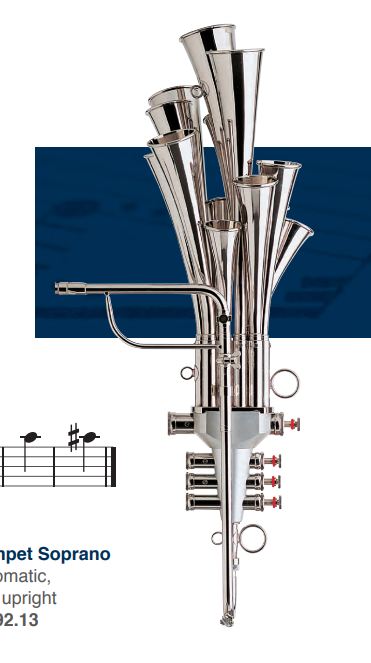 |
| Left: A Soprano Martin Horn: now
This is a contemporary Soprano Martin Horn which has 4 valves to select between 16 chromatic notes. The range is G4 to Bb5 in Scientific Pitch Notation. (SPN)
Note the right-angled blowing tube with a reinforcing rod. Presumably you put your thumbs through the two large rings when holding the instrument. The two small rings are for a neck-strap. The height of the instrument is 64 cm, so its weight is significant.
There is some more info here.
|
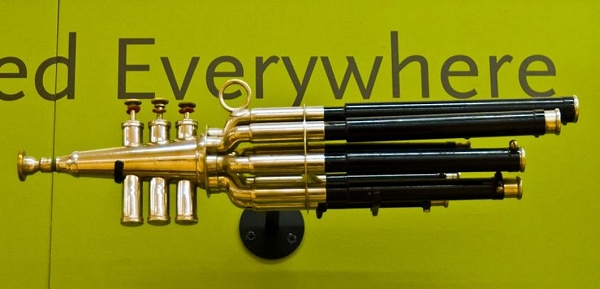 |
| Left: Unknown multipipe horn: 19??
This image was Found On The Web, and no information has so far been uncovered. An image search reveals nothing. Can anyone identify it?
This looks like some sort of variation on the Martin horn, though with cylindrical pipes rather than horns. Only six pipes are visible, but I strongly supect there are eight, selected on a binary basis by the three valves.
The brass inserts at the ends of the pipes (on the right) may be for tuning.
|
EXHAUST WHISTLES
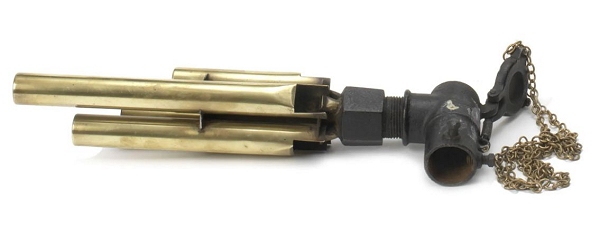 |
| Left: A Fulton Aermore 4-tone exhaust whistle: 1912
An exhaust whistle uses the exhaust gases of a car to power small organ pipes. This Fulton Aermore exhaust whistle has four notes, presumably tuned to a suitably abrasive chord. Looking at the length of the pipes, I think it might be a Seventh chord, but this is pretty much guesswork. Apparently Amtrak horns are tuned to B major 6th: (D#,F#,G#,B,D#). Perhaps a Sixth chord is more arresting than a Seventh.
The chain controls a shut-off valve; presumably pulling it diverted part of the exhaust gases through the pipes. Quite how you connected it to an existing exhaust system is not at present clear.
The Fulton Aermore exhaust whistle was patented in 1912. This example recently sold at auction for about £820.
|
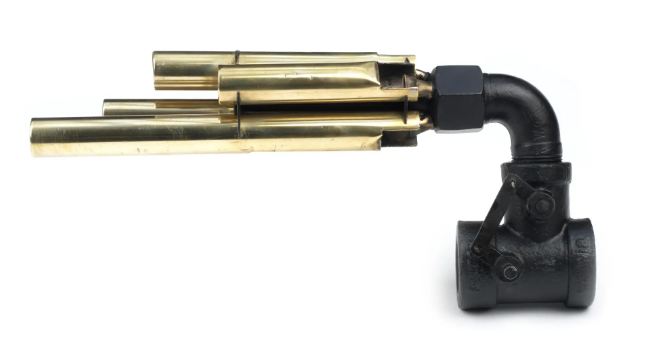 |
| Left: A Fulton Aermore 4-tone exhaust whistle: 1912
This one also has polished brass pipes, and a black-painted cast iron exhaust fitting with valve lever. The assembly is 36cm long overall, so quite a serious piece of kit.
The relative length of the pipes seems to be same as the image above, probably tuned for the same chord.
There is a lot of information on exhaust whistles here.
There is more info here and also here.
|
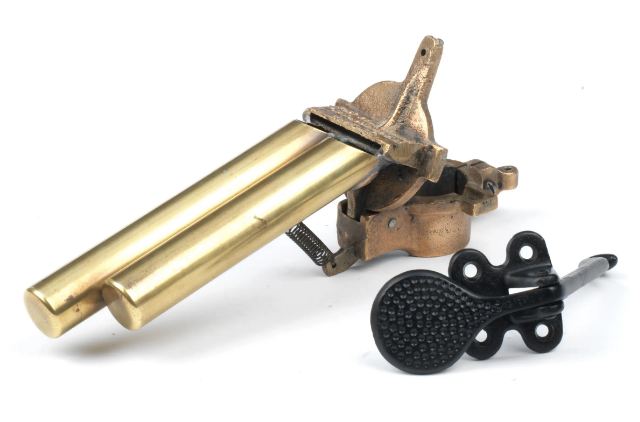 |
| Left: A 2-tone exhaust whistle by Troy of New York: 19??
This whistle has brass pipes with a cast bronze sprung hinged mechanism. The round black thing is a separate floor mounting foot-operated control pedal; thinking about it I suppose that's a double tautology.
You can still buy exhaust whistles though they are no longer used for alerting the unwary pedestrian. Instead the idea is to make a whistling noise so that people will think your car has a turbocharger when it hasn't. Pathetic; utterly Pathetic. A cheap variatio on this is the Whistle Tip.
|
THE SARRUSOPHONE
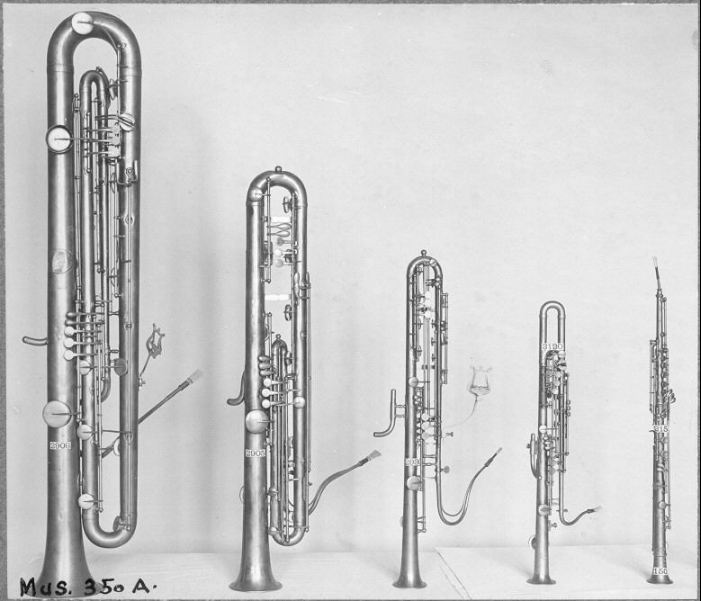 |
| Left: A collection of Sarrusophones: 1856
The Sarrusophones are a family of metal double reed conical bore woodwind instruments patented and first manufactured by French instrument maker Pierre-Louis Gautrot in 1856.
From the left are bass, baritone, tenor, alto, and soprano Sarrusophones. The music card holders give some idea of the scale.
Collection in the Metropolitan Museum of Art, New York
|
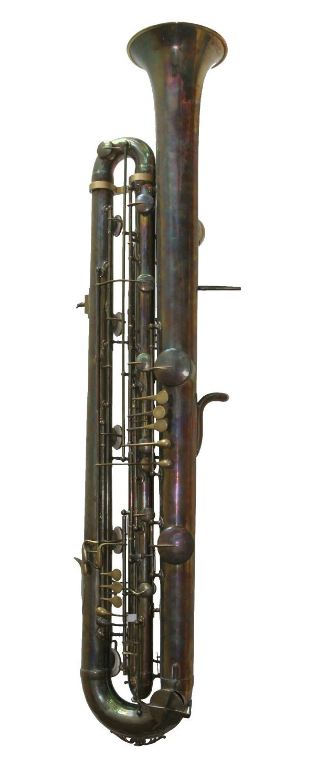 |
| Left: A contrabass Sarrusophone: 1856
This is a contrabass Sarrusophone that looks like it could do with a good polish. The sarrusophone was primarily intended to give more volume than bassoons and oboes in marching bands; however this contrabass does not look like a practical marching instrument.
Gautrot named the sarrusophone after French bandmaster Pierre-Auguste Sarrus, (1813-1876) but it is not currently clear how much Sarrus contributed the invention of the Sarrusophone.
The Soprano Sarrusophone has a Wikipedia page.
The Alto Sarrusophone has a Wikipedia page.
The Tenor Sarrusophone has a Wikipedia page.
The Baritone Sarrusophone has a Wikipedia page. It is sometimes colloquially known as the combat bassoon, though it is not entirely clear how you would use it as a weapon. Perhaps you could stuff the bell with gunpowder and shrapnel and use it as a blunderbuss. Certainly I think it's worth a try.
The Bass Sarrusophone has a Wikipedia page.
The Contrabass Sarrusophone has a Wikipedia page.
There is a mass of information on Sarrusophones at contrabass.com.
You can hear a Soprano Sarrusophone on YouTube.
|
SAXOPHONES
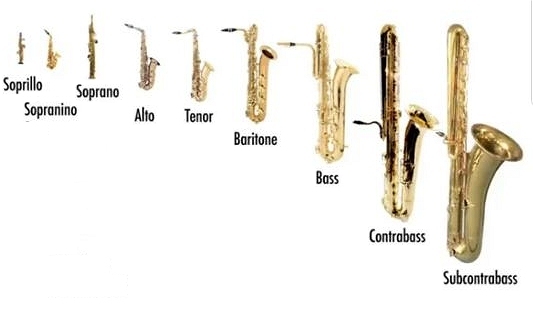 |
| Left: The Saxophone family: Now
The Saxophone was invented by Belgian instrument maker Adolphe Sax in the early 1840s, being patented on 28 June 1846. The saxophones are shown here to scale. (I think) They are all 'conventional' saxophones, apart from the extremes in size. There were many less common variations, a recent invention being the Aulochrome.
The Saxophone unsurprisingly has a comprehensive Wikipedia page.
Source: US Navy
|
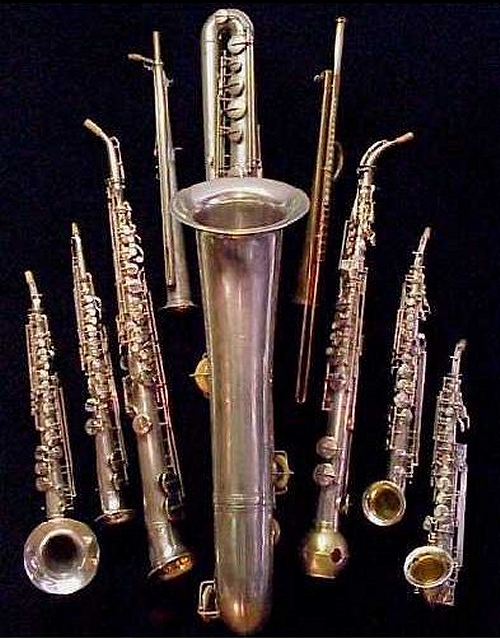 |
| Left: The Saxophone family extended
Here we have a rather more diverse collection of saxophones. The big one in the centre is a Bass Saxophone. Also shown are instruments from Sopranino to Bass including straight versions of the Alto and Tenor Saxophones.
You can also see two Slide Saxophones, (immediately to the left and the right of the Bass Saxophone) and also a Saxello, (extreme left, I think) and a Stritch. (a straight Alto, second left from the Bass Saxophone) At present it is not wholly clear which instrument is which.
There is a Conn-o-Sax (easily spotted by its spherical bell with two holes in) second right from the Bass Saxophone; the bulbous bell is similar to that of a Cor Anglais or Bass Oboe.
|
THE SOPRILLO SAXOPHONE
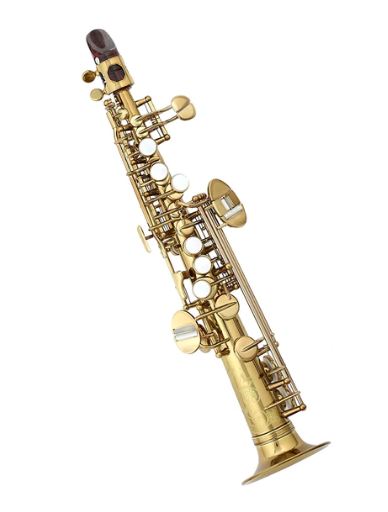 |
| Left: Soprillo Saxophone: Now
This is the smallest saxophone made; it is manufactured only by Benedikt Eppelsheim in Germany. Its written range is Bb3-Eb6, sounding Ab4 (415.3 Hz) to Db7 (2217 Hz) which is an octave above the Bb Soprano Saxophone. It is said to be "...a little tricky to play" and I'll bet it is. A snip at £5239 each.
The Soprillo Saxophone is so small that is necessary to make the octave key part of the mouthpiece.
There is more info here.
|
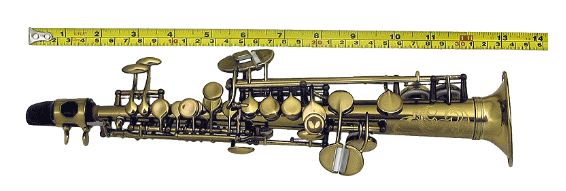 |
| Left: Soprillo Saxophone: Now
Demonstrating the small size of the Soprillo Saxophone, clocking in at a fraction over 13 inches.
|
THE SOPRANINO SAXOPHONE
 |
| Left: Sopranino Saxophone: Now
The Sopranino Saxophone sounds one octave above the Alto Saxophone. Due to the short bore length they are usually made straight, as shown here, like the Soprillo and Soprano Saxophones. Some are built in the same shape as an Alto Sax, but this has the disadvantage that it looks rather like a toy saxophone.
There is more info here.
|
THE BASS SAXOPHONE
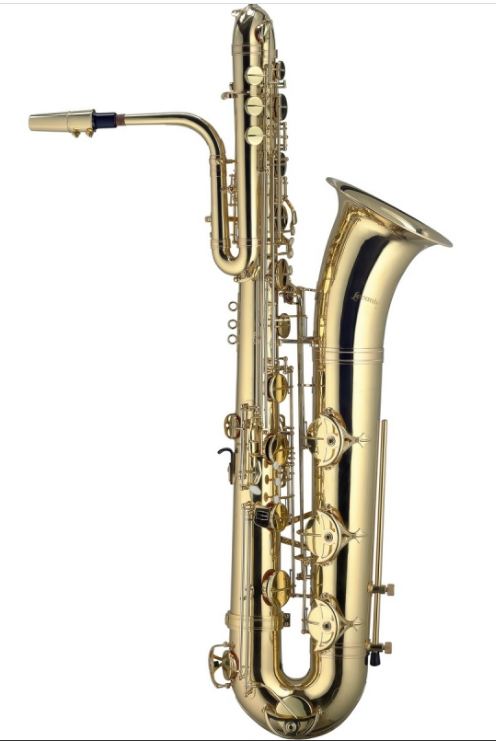 |
| Left: Bass Saxophone: Now
Saxophones are made in many sizes, ranging from Soprillo to Subcontrabass. The common sizes are Soprano, Alto, Tenor, and (less commonly) Baritone. The Bass Saxophone is rarely encountered, but here it is, looking rather like a Baritone sax on steroids. This one is in B. It boasts a Flat H key, an Auxiliary key A, and a High F key.
From the bell the bore goes down, up all the way, down again, and up again to reach the mouthpiece. This is similar to a baritone sax but the bore sections are naturally longer. The rod to the right of the bell is an adjustable floor support.
One of these is yours for only 10,012 Euros, from Drum-Factory.de. It weighs 8.6 kg. It comes with a case on wheels...
|
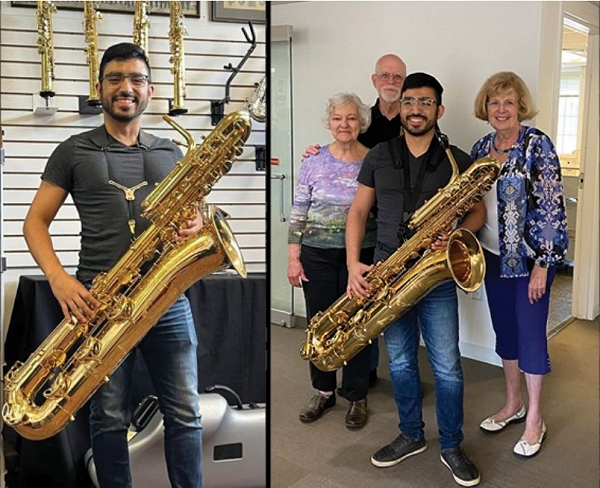 |
| Left: Bass Saxophone: 2023
This gives you a feel for the size of a Bass Saxophone. It is feasible, if not comfortable, to sling it from your neck.
There is more info on this particular machine here.
|
THE CONTRABASS SAXOPHONE
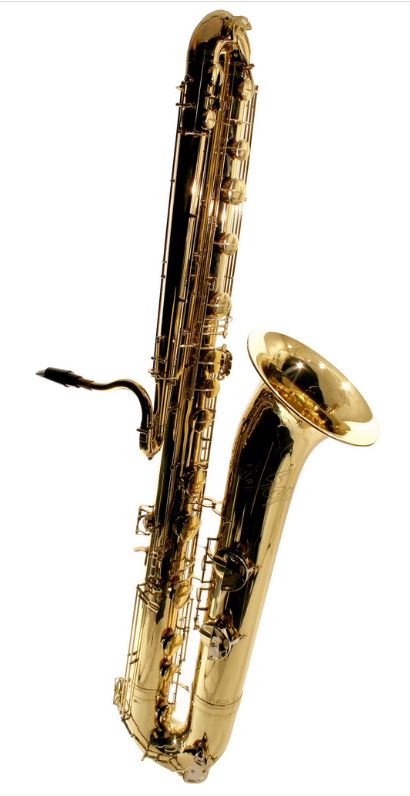 |
| Left: Contrabass Saxophone: date?
The Contrabass Saxophone is a hefty instrument standing about 2 metres high and weighing about 20 kilograms, which in the EU is set as the maximum load to be lifted by one person. Nevertheless, it was carried in marching bands in the early 20th century.
It is pitched in Eb one octave below the Baritone Saxophone, requiring twice the length of tubing and bore width.
You can hear a Contrabass Eb Saxophone played by Marcel Helland on YouTube.
|
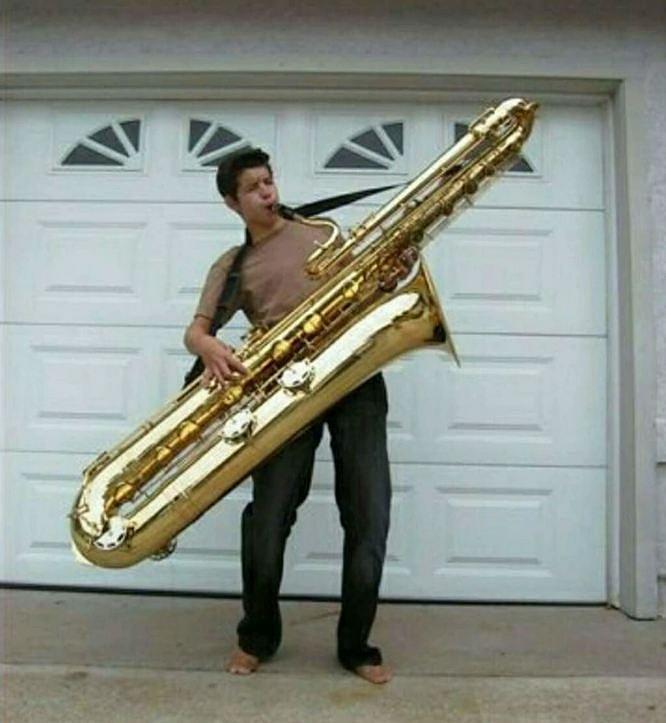 |
| Left: Contrabass Saxophone: date?
Here's a Contrabass Saxophone with player to give scale; it is a formidable instrument. Images like this lead one to suspect Photoshop, but I think this is real.
There is more information here.
The Contrabass Saxophone has a Wikipedia page.
You can hear an Eb Contrabass Saxophone on YouTube, starting at 8:31.
|
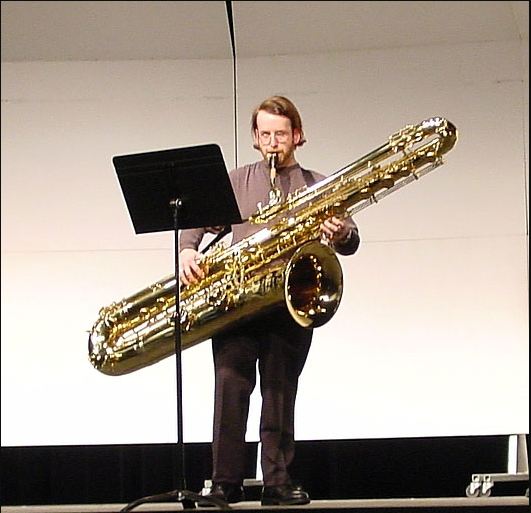 |
| Left: Contrabass Saxophone: date?
Yes, you really can sling a Contrabass Saxophone around your neck, though whether the result looks dignified is doubtful.
|
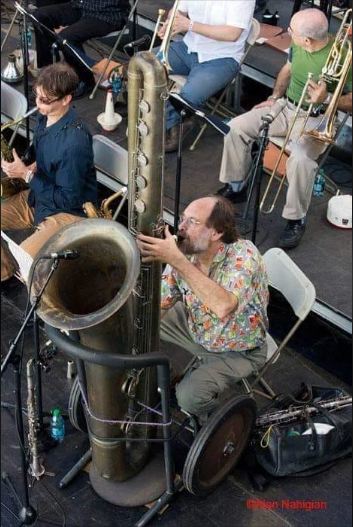 |
| Left: Contrabass Saxophone: 2022
This is probably a better way, though you could argue it is also a bit undignified.
Here multi-instrumentalist Scott Robinson is playing his Contrabass Saxophone in the Maria Schneider Orchestra at the Newport Jazz Festival. The year is believed to be 2022.
Note the Contrabass Saxophone is lashed to a wheeled trolley.
A microphone is placed over the bell; it is perhaps surprising it needed amplifying.
There is what is probably a Soprano Saxophone to the left of the Contrabass Saxophone.
|
THE SUBCONTRABASS SAXOPHONE
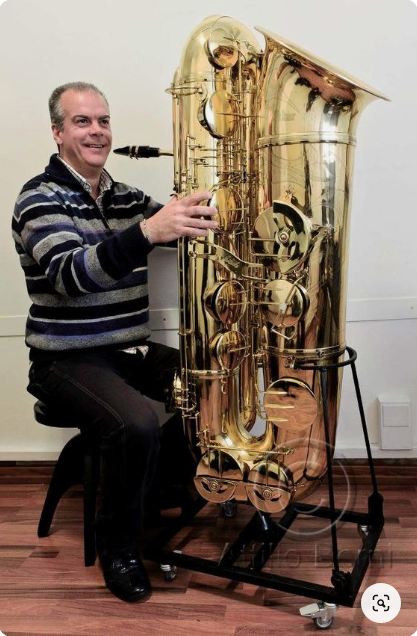 |
| Left: Subcontrabass Saxophone: date?
At present it appears that there is only one Subcontrabass Saxophone in the world, and here it is. Like the Contrabass Tuba, it sits in a special frame to be played. In fact, it probably never leaves it. You wouldn't want to hang it round your neck.
That is not Nigel Farage.
There is more information here.
You can hear the Subcontrabass Saxophone as part of a Big Band on YouTube, played by Attilio Berni. In the second half he switches to what appears to be a tiny Soprillo Saxophone, then goes back to the Subcontrabass. Impressive!
|
 |
| Left: Subcontrabass Saxophone: date?
Another view of the Subcontrabass Saxophone, with a Soprano Sax (the smallest in common use) to the right for comparison purposes.
|
THE CONTRABASS TUBAX
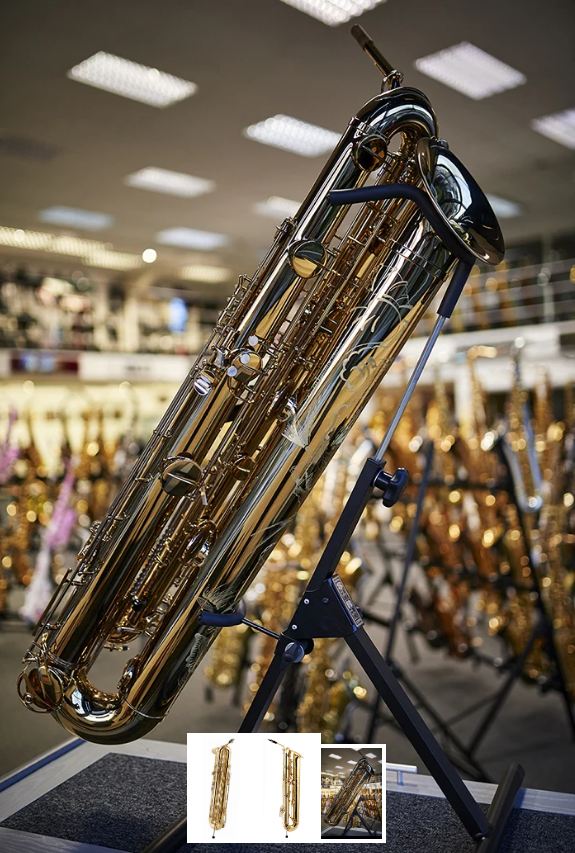 |
| Left: The Contrabass Tubax: 1999
As you have seen from the pictures just above, a Contrabass Saxophone is an unwieldy piece of machinery. This was addressed by Benedikt Eppelsheim in Germany, who produced the Tubax, a combination of Tuba and Sax. The Tubax bore is folded four times rather than the three of the Contrabass Saxophone, making it more compact.
The Tubax has a Wikipedia page.
|
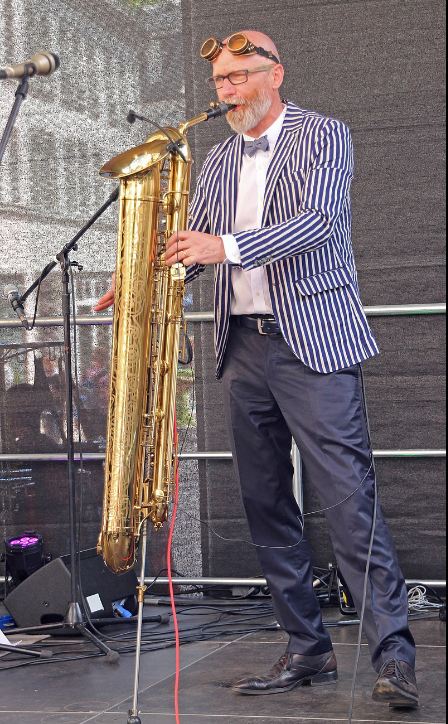 |
| Left: The Contrabass Tubax: 1999
Oliver Saar plays a Eb Contrabass Tubax at Jazztage Idar-Oberstein in 2017.
You can hear a Contrabass Tubax on YouTube.
You can buy one for £24,939. Run, don't walk, to your music shop.
|
THE SUBCONTRABASS TUBAX
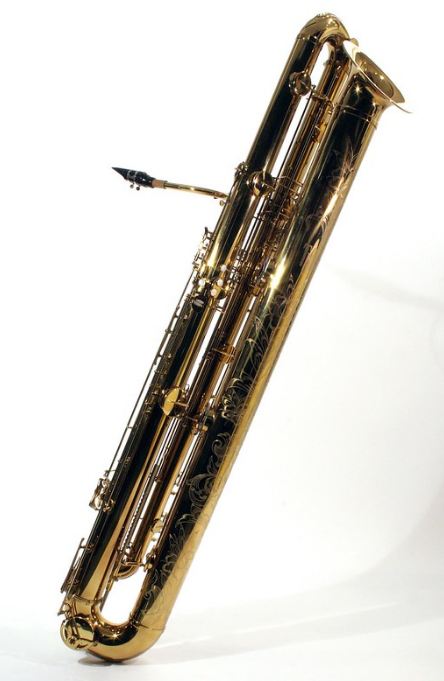 |
| Left: The Subcontrabass Tubax: now
The Subcontrabass Saxophone is even more awkward to deal with than the Contrabass Saxophone, so Benedikt Eppelsheim rose to the challenge with the Bb Subcontrabass Tubax, which sounds an octave below the Bass Saxophone.
You can hear a Subcontrabass Tubax on YouTube.
You can buy one for £30,139.
There is more info on the Eppelsheim website.
You can see and hear an Eb Contrabass Tubax, a Contrabass Saxophone, and a Bb Contrabass Tubax, with some nice images, here on YouTube.
|
THE CONN-O-SAX
 |
| Left: The Conn-o-Sax: 1928
The Conn-O-Sax was a radical F Alto Saxophone made for a short time by American instrument manufacturer Conn in 1928. It combined elements of the Saxophone, the Cor Anglas, and the Heckelphone. The fingering was the same as a normal Saxophone. Given the enormous popularity of the Saxophone in the years 1915 to 1925, Conn hoped it would sell as a novelty instrument; they were wrong, it failed in the market place and had disappeared from Conn's catalogues by 1930. Only 25 Conn-O-Sax's now exist.
A notable feature of the Conn-O-Sax is the presence of two circular holes on the sides of the spherical bell. They may provide some subtle acoustic property, but I suspect not. I have heard it said that only the lowest notes sound anything like a Cor Anglais, and that's no doubt to do with the spherical bell.
You can hear a Conn-O-Sax on YouTube. Sounds pretty much like a normal Saxophone to me.
|
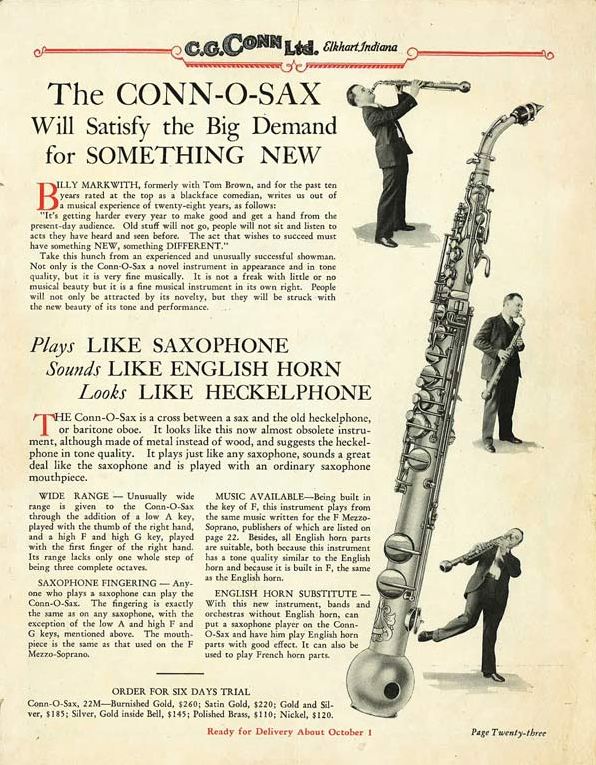 |
| Left: The Conn-o-Sax: 1928
In this advert Conn are leaning heavily into the novelty factor of the Conn-O-Sax. Unfortunately it didn't work. There wasn't a Big Demand to satisfy.
Ad for the Conn-O-Sax in Musical Truth, published by C G Conn, 1928.
|
THE SAXELLO
 |
| Left: Soprano Saxello: 1925
The H N White Company, (manufacturers of King Band Instruments) introduced the Saxello in the early 1920's. It had a curved neck, a straight body tube and a bell tipped up at 90 degrees. Other Saxellos had the bell at a lesser angle, as shown here.
The picture shows a contemporary Rampone & Cazzani R1 Jazz Saxello, which will set you back £6,299.00.
To quote one player: "Every Saxello I've played had a bad scale (meaning, poor intonation)." Nevertheless, they command high prices in the collectors market.
The Saxello does not have a Wikipedia page.
You can hear a Saxello on YouTube. Sounds alright to me.
|
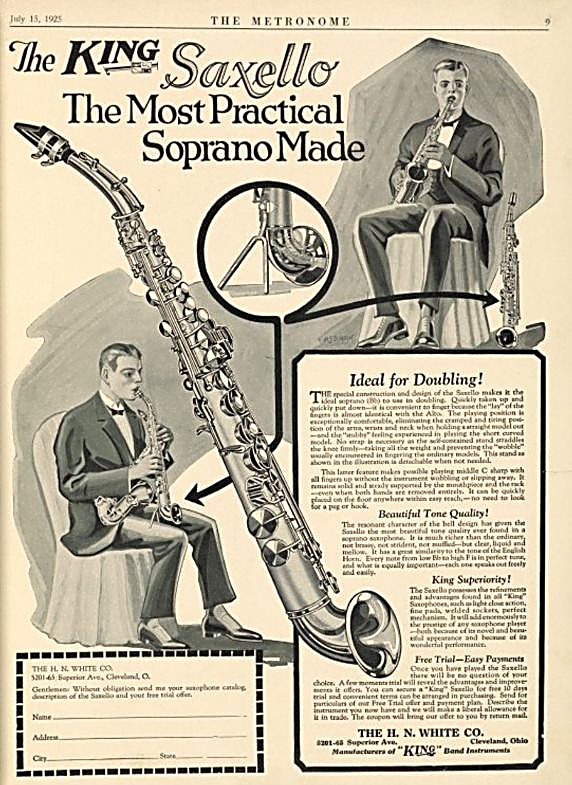 |
| Left: Saxello advert: 1925
With any odd instrument there is a question as to what issue it was supposed to address. Here the ease of swopping instruments when 'doubling' gets top billing. 'Doubling' is when a playe swops instruments during a piece. It extols the comfortable playing position, and the built-in rest that stands on the player's thigh.
The allegedly superior tone of the instrument (see above for one contrary opinion) only gets second billing.
If you zoom into the picture the small text should be readable.
Source: Metronome was an independent music magazine published from January 1885 to December 1961.
|
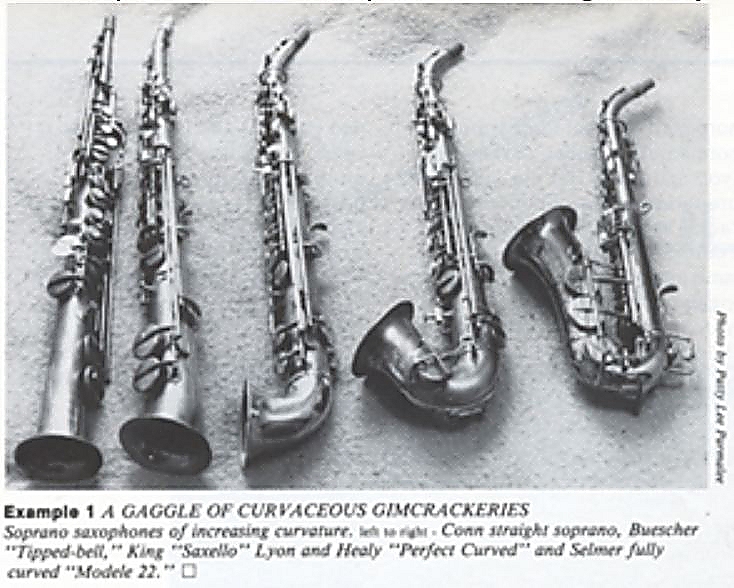 |
| Left: Variations on bell angle in soprano saxophones: 1925
The King Saxello is the middle instrument.
Source: Unknown
|
THE STRITCH
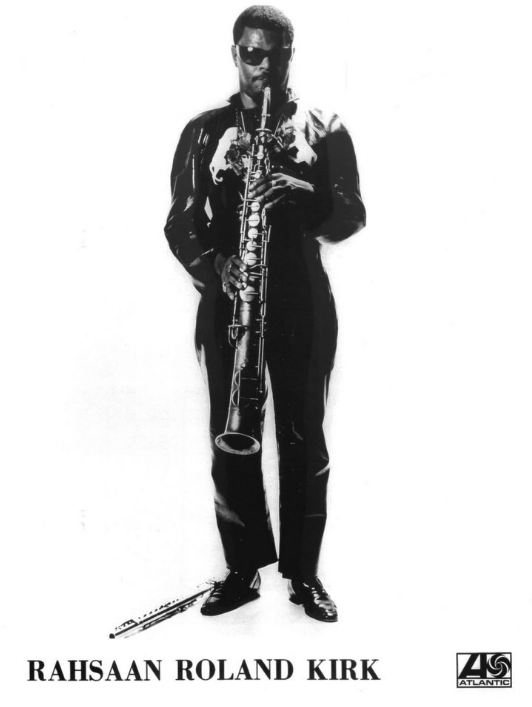 |
| Left: The Stritch: 1927
The jazz musician Rahsaan Roland Kirk, noted for playing two (or more) saxophones at once, called his straight Buescher Alto Saxophone a "Stritch" for reasons unknown, and the name has persisted. He called his Saxello a "Manzello".
The Stritch does not have its own Wikipedia page, but is briefly mentioned on the Wikipedia Saxophone page.
You can hear Roland Kirk's actual Stritch played on YouTube.
|
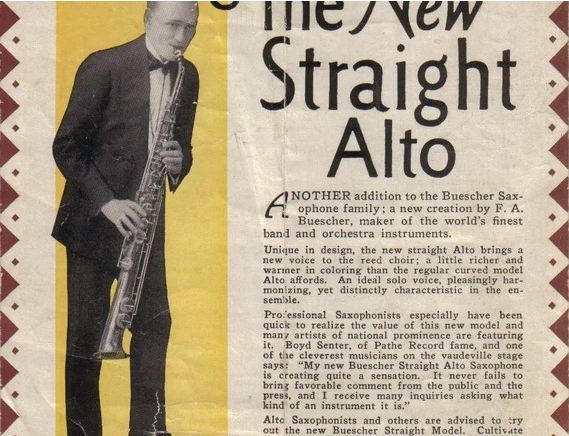 |
| Left: The Stritch: 1927
Promoting the Straight Buescher Alto Saxophone.
It was not called a Stritch at this point.
|
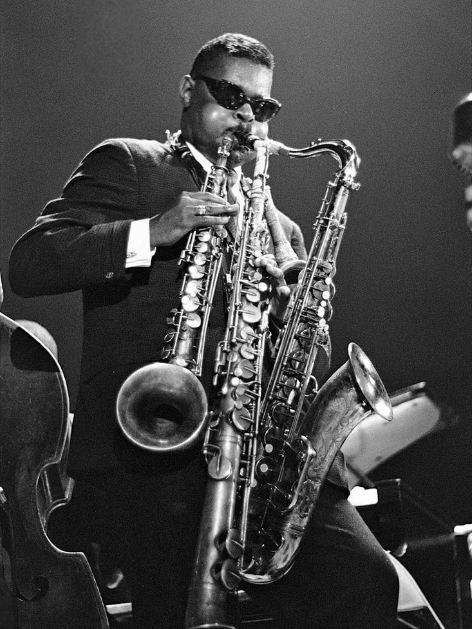 |
| Left: The Stritch: 1927
Rahsaan Roland Kirk demonstrates what it truly means to be a multi-instrumentalist. The Stritch is in the middle, and I think that's the Saxello on the left. Looks like a standard Tenor Sax to the right.
You can hear Roland Kirk's actual Stritch played on YouTube.
|
THE SLIDE SAXOPHONE
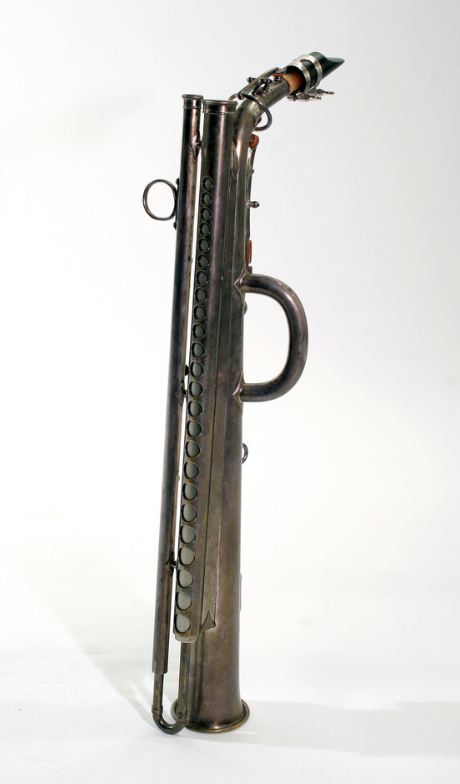 |
| Left: The Slide Saxophone: 19??
A Slide Saxophone uses a trombone-type telescoping feature in the bore to give an infinitely variable frequency of note. There were four or five different makes of Slide Saxophone, but by far the best known is the Swanee Sax - so called because of its similarity to the Swanee Whistle.
When the ring on the left is moved up and down, the U-shaped tube moves with it and changes the length of the bore.
Note the substantial handle, because one hand would have to support the instrument, while the other was fully engsged in moving the slide up and down.
There is an excellent page on the Swanee Saxophone here.
There is more info here
|
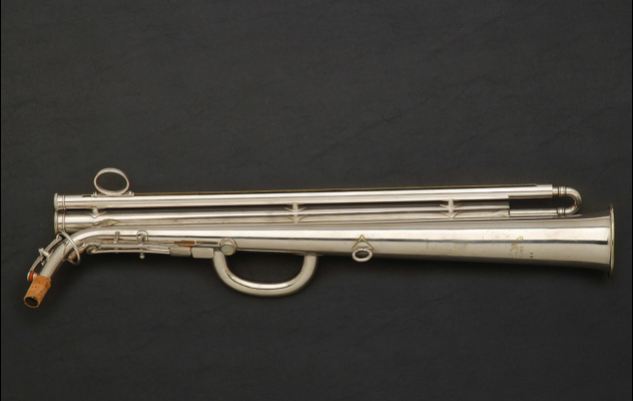 |
| Left: The Slide Saxophone: 19??
Another Slide Saxophone, this time silver-plated. This is a Soprano model, made by Reiffel and Hustead of Chicago. There is some info about them here.
You can hear a Slide Saxophone being played on YouTube. Randy Emerick is playing a Reiffel & Husted "Royal Slide Saxophone" in the key of C, made in Chicago in the 1920s.
|
THE AULOCHROME
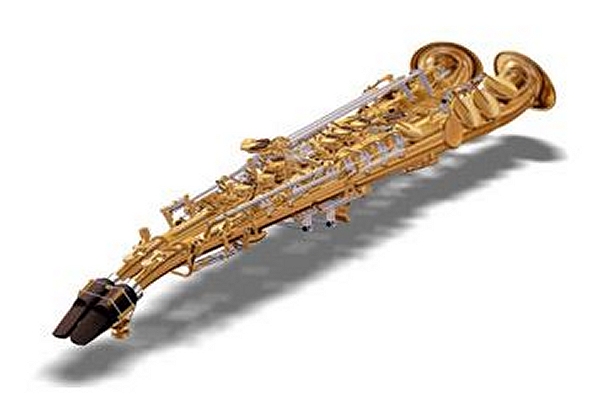 |
| Left: The Aulochrome: 1999
The Aulochrome is a sort of stereo soprano Saxophone, consisting of two Soprano Saxophones joined together at the mouthpiece end; it appears there are two separate reeds, but this is currently unconfirmed. The two sections can be played either separately or together. It was invented by Belgian François Louis and first prototyped in 1999.
From the Aulochrome website:
"It allows producing differential tones (a virtual bass note resulting from the difference of the frequencies of the two notes of one interval) as well as additional tones, extending the lower register far below the deepest note determined by the length of the pipes.
Also, a tiny "mistuning" of the unison generates beats; players can control the rhythm of the pulsations."
|
The Aulochrome has a brief Wikipedia page.
|
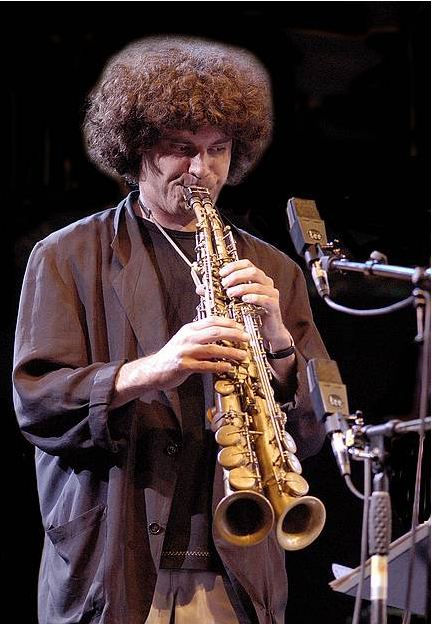 |
| Left: The Aulochrome played by Fabrizio Cassol: 2003
You can hear Fabrizio Cassol on YouTube playing the Aulochrome at the Midelheim Jazz Festival, on 4th August 2003
There is more info on Fabrizio Cassol here.
|
THE SOPRALTO BRAITHOPHONE
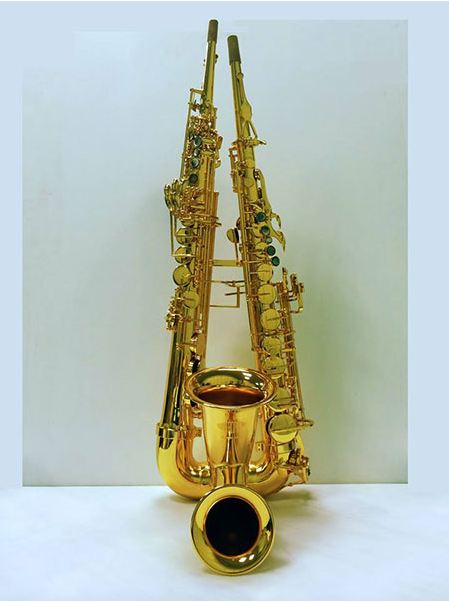 |
| Left: The Braithophone
The Sopralto Braithophone consists of Soprano and Alto Saxophones joined together, and meeting in a double bell. Each half has its own mouthpiece; they are placed close together so both can be used at once. The instrument is designed so that the fingering for simultaneous playing to produce intervals in unison, octaves, fourths, sixths etc, is possible. It is not currently known when the first one was made.
The Sopralto Braithophone was invented by jazz improviser and composer George Braith,
The Sopralto Braithophone has a website here. You can buy one for $6,999
|
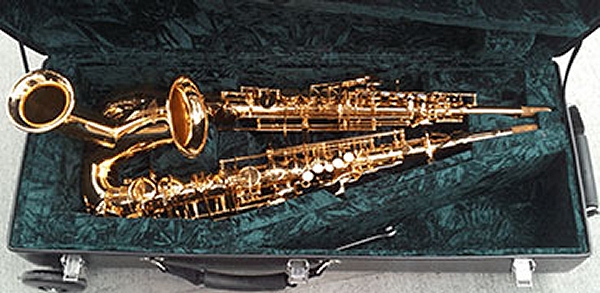 |
| Left: The Braithophone
The Sopralto Braithophone in its case.
You can hear a Braithophone on YouTube. It's quite a big instrument and the player is resting its lower end on a stool.
The Braithophone does not currently have a Wikipedia page.
|
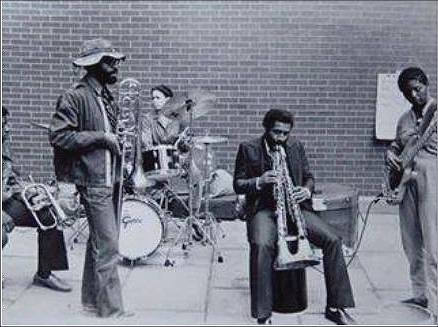 |
| Left: An early Braithophone
According to this page in Facebook, the Braithophone took more than 35 years to develop.
Here Braith plays an early version with a single bell for the two saxophones.
|
THE ROTHOPHONE
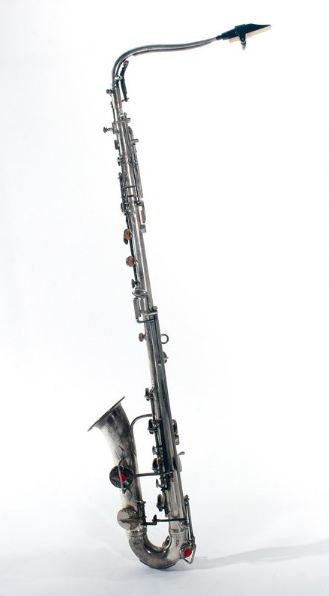 |
| Left: The Rothophone: 1908
The Rothophone (or Rothphone) was invented by Ferdinando Roth in 1908; it looks like an anorexic saxophone. It can be played using a single or double-reed, but was apparently intended to use a double-reed.
Like the Sarrusophone, it was intended to replace oboes and bassoons in military bands. It didn't. The Rothophone did see some use in Italian wind and military bands in the Twenties and Thirties, but it was almost unknown outside Italy.
The Rothophone has a Wikipedia page.
In this YouTube video you can hear a soprano Rothophone starting at 2:36. It is believed to be the only one in existence. It sounds rather like an oboe.
|
 |
| Left: Tenor Rothophone: around 1925
This Tenor Rothophone is in the Horniman Museum in London. The mouthpiece is missing.
There is also another Rothophone in the Horniman Museum in London. It has an odd-shaped perforated bulb at the end of the bell, which appears to have been an attempt to convert it into a Heckelphone.
|
 |
| Left: A Set of Rothophones: 1908
A set of Rothophones. Left to right: Alto in Eb, Tenor in Bb, Baritone in Eb, Bass in Bb.
There is a modified Rothophone in the Horniman Museum in London.
|
REED CONTRABASS
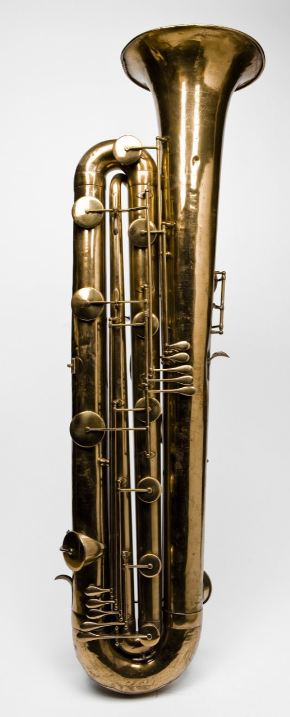 |
| Left: Reed Contrabass: 1856
The Reed Contrabass is a metal double-reed woodwind instrument in the bass-contrabass register, pitched in C. It has an unusually wide conical bore, the width allowing each note to be sounded by opening only one tone hole, which greatly simplifies the fingering. The lowest note is usually D1. (36.7 Hz)
It rather resembles the Contrabass Sarrusophone but they are different instruments. In French it is a Contrebasse a anche.
The instrument is generally obsolete, being replaced by the Contra-Bassoon, but is still played in Italy.
You can hear the Reed Contrabass on YouTube; it makes a grunting noise that the audience seems to find amusing.
The Reed Contrabass has a good Wikipedia page.
This specimen is in the University of Edinburgh Musical Instrument Museum, at St Cecilia's Hall; there is more info here
|
THE CONTRAFORTE
 |
| Left: The Contraforte: Now
The Contraforte (Kontraforte in German) is a redesigned Contra-Bassoon, produced by Benedikt Eppelsheim (1967 - 2023) and Guntram Wolf. (1935 – 2013) The Contraforte uses a wider bore than the Contra-Bassoon giving a distinctive timbre that is more consistent in strength and intonation across the ranges of notes.
The Contraforte has a written range from A1 to G5 (in Scientific Pitch Notation), sounding A0 to G4. (in SPN)
The Contraforte has a Wikipedia page.
You can hear Lewis Lipnick (Principal Contrabassoon in the National Symphony Orchestra of Washington DC, USA) playing the Contraforte on YouTube. I am no music-critic but I reckon it sounds definitely better thah a Bassoon.
|
THE LUPOPHON
 |
| Left: Bass Lupophon: Now
The Lupophon (or Lupophone) is a rethought bass oboe, developed by by Guntram Wolf of Kronach and Benedikt Eppelsheim of Munich. It is manufactured by Wolf's company, and you can see more details on the Wolf website.
The name is derived from 'lupo' which is Latin for Wolf.
The Lupophon has a Wikipedia page.
You can hear a Lupophon on YouTube here, and here.
|
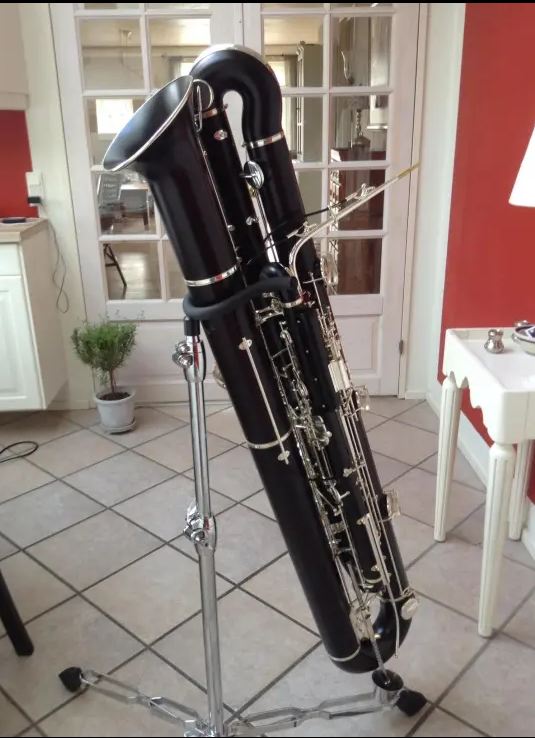 |
| Left: The Contra-Bass Lupophon: Now
This Lupophon (or Lupophone) is the contra-bass version. It was developed by by Guntram Wolf of Kronach and Benedikt Eppelsheim of Munich.
The Lupophon has a Wikipedia page.
You can hear a Contrabass Lupophon on YouTube.
There is more info at the website of Guntram Wolf.
|
THE SERPENT
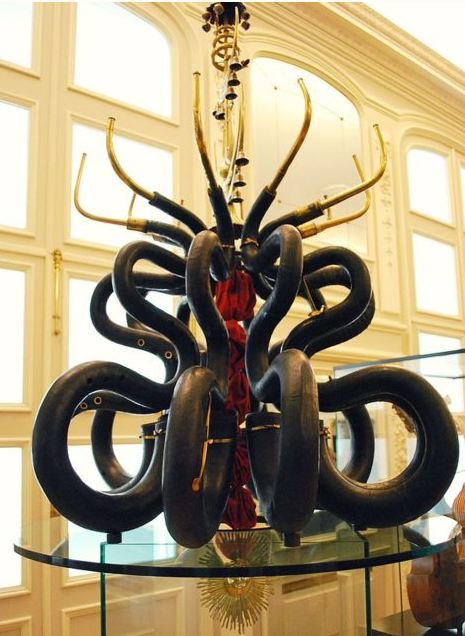 |
| Left: Serpent display in MIM
The Serpent is hybrid brass/woodwind instrument with a trombone-like mouthpiece, with tone holes and fingering like a woodwind instrument. The bore is bent in a serpentine shape so the tone holes are reachable. The Serpent is not very Unusual, but I could not resist this ingenious display of Serpents in MIM, Brussels.
The sound of the Serpent was considered unsatisfactory, and it was replaced, first by the Ophicleide, and finally by the Valved Tuba.
The Serpent has a Wikipedia page.
|
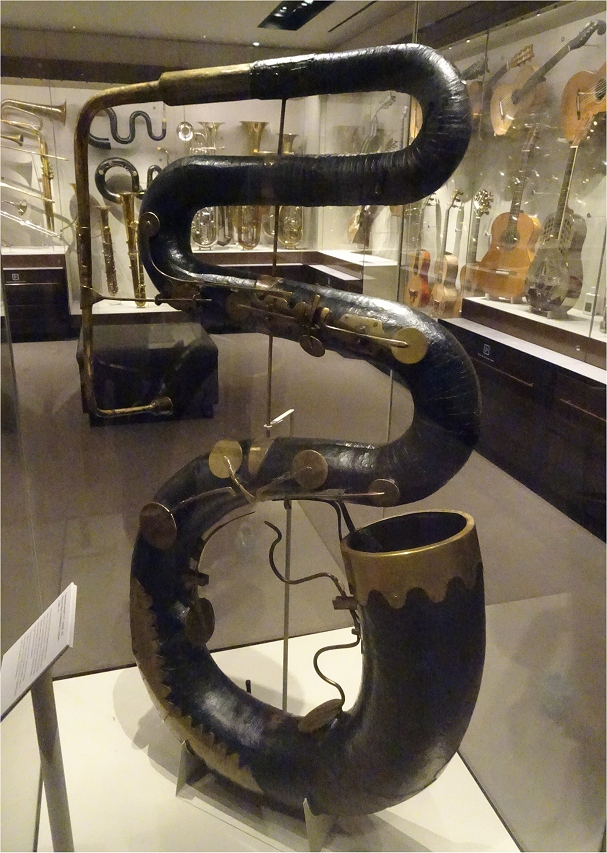 |
| Left: Contrabass Serpent: 1840
But this Serpent is unusual. It is probably the only historical example of a contrabass serpent; though a few have been made in modern times. It’s pitched in 16-ft C, (C1) an octave lower than a standard serpent. It was made by Joseph and Richard Wood of Huddersfield, Great Britain around 1840.
It was played by its makers in Almondbury Church, Huddersfield, and now and then in York Minster, to reinforce bass vocal parts.
But how do you play it? The mouthpiece can be seen middle left; you hold the serpent with the long axis horizontal.
It is familiarly known as The Edinburgh Anaconda.
There is more info on the Contrabass Serpent here, and you can hear what it sounds like. Something like a tiger purring.
Source: Instrument in St Cecilia's Music Museum, Edinburgh. Author's photograph: 15th Aug 2024
|
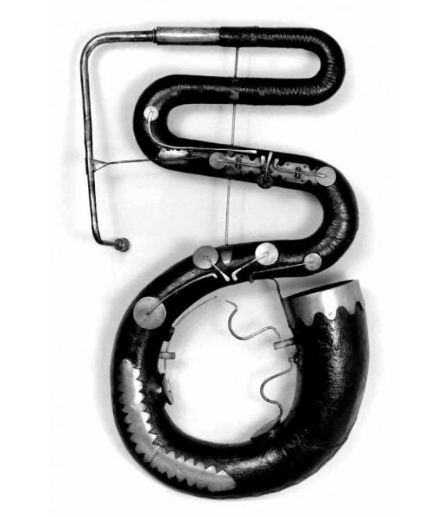 |
| Left: Contrabass Serpent: 1840
Another picture of the same instrument.
There is a page on Contrabass Serpents here, including six recent instruments.
You can make a viable serpent out of rectangular wooden sections; this is called a squarpent.
|
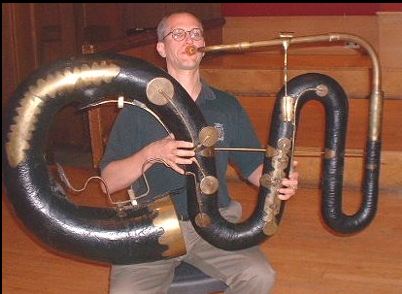 |
| Left: Contrabass Serpent: 1840
How you hold a Contrabass Serpent; you balance it on your lap. This is Doug Yeo of the Boston Symphony and Boston Pops Orchestras, playing the Edinburgh Anaconda.
|
THE VIOLONCEL-SERPENT
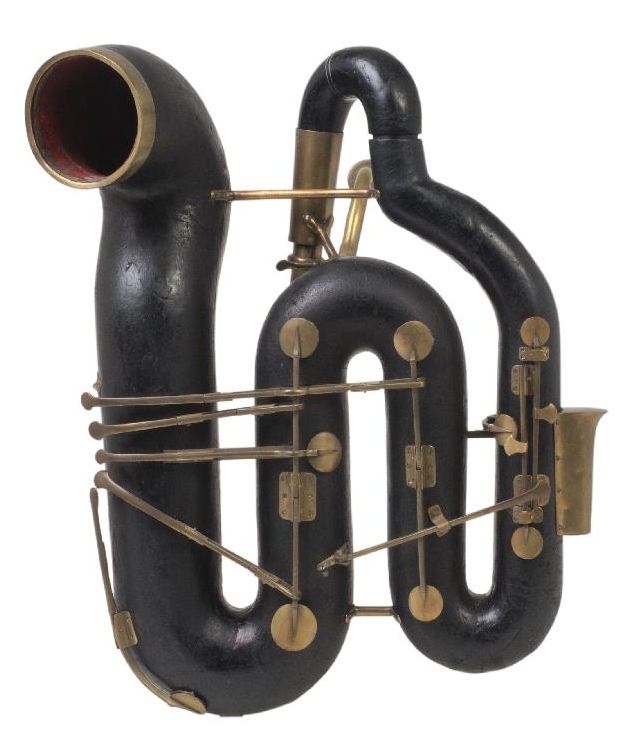 |
| Left: The Violoncel-Serpent: 1830
This downright frightening instrument was made by Ludwig Embach & Co in Holland between 1830 and 1835. Is it just me that finds this gaping mouth unsettling?
Ludwig Embach & Co also made conventional serpents and clarinets.
It appears that you hold it by one hand on the left below the mouth, and by the other on the tube section at the far right. To make this possible the keywork looks very odd, with some very long levers.
The Violoncel-Serpent design was registered for a patent on 28 October 1829 under the names "Serpent in D" and "Violoncel-Serpent". A Dutch technical commission judged the invention to be patentable and granted the applicant a ten-year manufacturing privilege on 7 January 1830.
Source: instrument in the Museum für Musikinstrumente der Universität Leipzig, Germany.
|
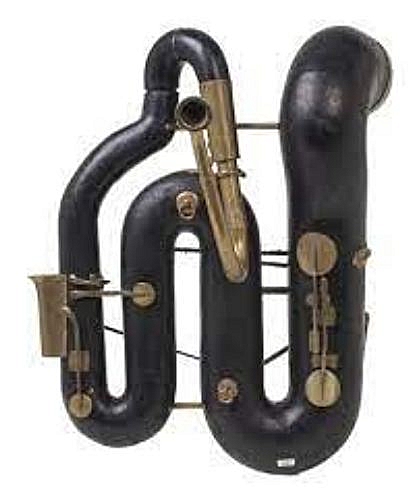 |
| Left: The Violoncel-Serpent: 1830
The first bend after the mouthpiece slides telescopically to allow tuning.
A ring can be seen at the top of the middle U-bend; this was for fastening a starp so you could hang the instrument around your neck.
Source: instrument in the Museum für Musikinstrumente der Universität Leipzig, Germany.
|
THE OPHICLEIDE FAMILY
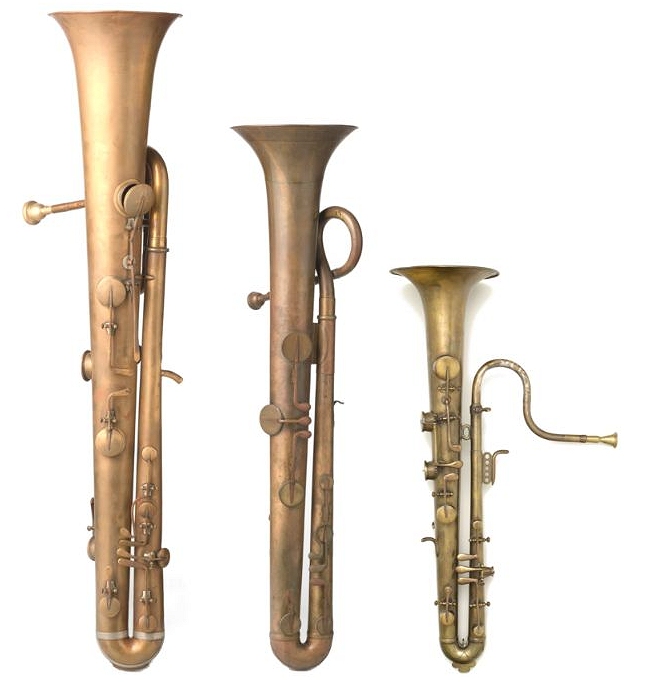 |
| Left: Bass, Alto and Soprano Ophicleides: 1821
I have been resisting adding the Ophicleide to this page because I didn't think it was particularly unusual; I have known it existed since I was a small child. However its time has now come.
The Ophicleide is a conical-bore keyed brass instrument; the bass version is the most common. It is played with a cup-shaped mouthpiece like that of a modern trombone or euphonium. It was patented in France in 1821 by the instrument maker Jean Hilaire Asté early 1800s to extend the range of the keyed bugle into the alto, bass and contrabass areas, and to replace the Serpent; the latter is why it is placed here rather than in the Brass section of this page.
The Ophicleide fell out of favour towards the end of the nineteenth century; the Bass Tuba or the Contrabass Trombone were used instead.
The Ophicleide has a very good Wikipedia page.
|
THE CONTRABASS OPHICLEIDE
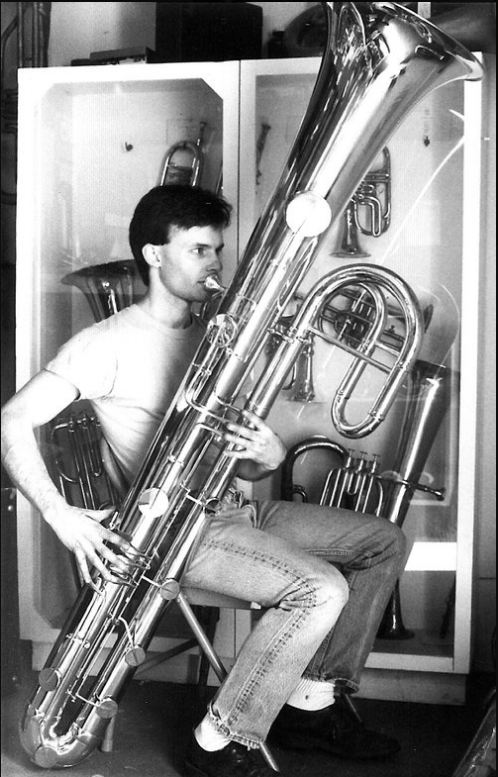 |
| Left: Contrabass Ophicleide: 1821
I'm sure you're wondering if there is such a thing as a Contrabass Ophicleide; the answer is of course yes. A Contrabass Ophicleide in 12-foot F or Eb, was commissioned in 1834 for Mendelssohn's oratorio Elijah; 1t was sometimes known as the monstre. According to Wikipedia, only three non-playable Contrabass Ophicleides survive in museums.
This is a modern and playable replica Contrabass Ophicleide in 12-foot Eb, built by Robb Stewart of Robb Stewart Brass Instruments. I assume that's Robb there getting to grips with the beast, but that is so far unconfirmed.
Apparently two new examples had been built by 2021.
You can hear one of them on YouTube.
Regrettably there has never been such a thing as a Subcontrabass Ophicleide. It would indeed be a monster.
|
BASSOONS
THE CONTRABASSOON
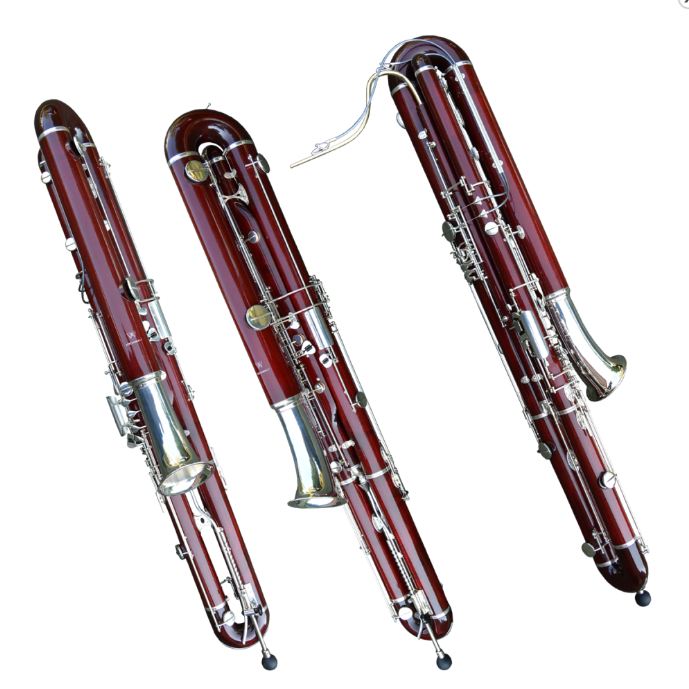 |
| Left: Wolf Contrabassoons
The Contrabassoon (AKA the Double Bassoon) sounds an octave lower than the ordinary Bassoon.
The picture shows Contrabassoons by Wolf. According to Wolf, one of them can be dismantled and carried onto an aeroplane as hand luggage. The one on the right seems to have a key right near the mouthpiece, operated by a Bowden cable; function currently unknown.
Contrabassoons usually go down to Bb0 (=29.1 Hz) or A0. (= 27.5 Hz)
The Contrabassoon has a Wikipedia page.
The Contrabassoon has a page on contrabass.com.
You can hear a Contrabassoon on YouTube.
|
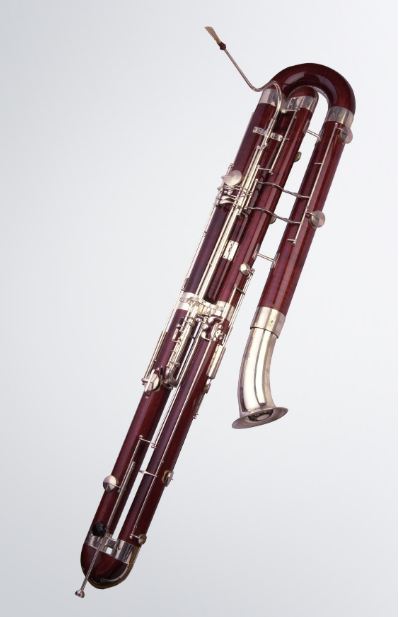 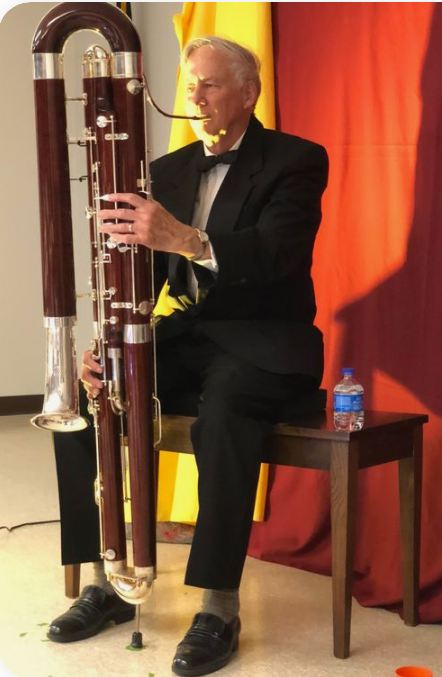 |
| Far left: Contrabassoon of unknown make.
Left: Dean Zook of the Great Falls Symphony Orchestra with his Contrabassoon
Using a strut to support the instrument is very necessary.
|
THE SUBCONTRABASSOON
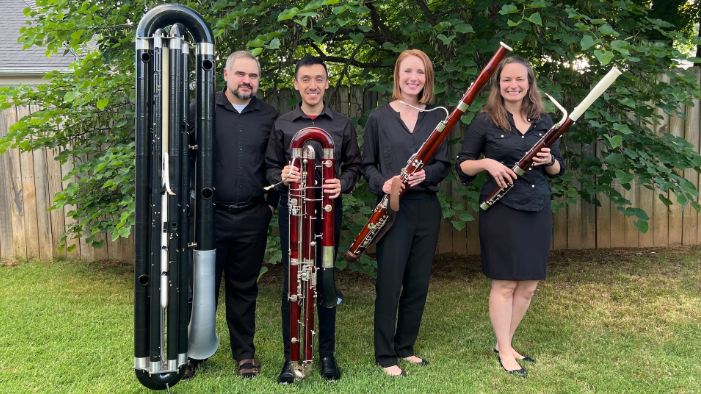 |
| Left: Richard Bobo at left with his Subcontrabassoon: 2021
If you've got a feel for how this Gallery works, you'll be asking yourself if there is a Subcontrabassoon. Of course there is.
A Subcontrabassoon has been designed and built by Richard Bobo. It plays a full octave below the Contrabassoon.
At left is Richard Bobo with his Subcontrabassoon. To his right is someone holding a Contrabassoon; further right a lady holds a normal Bassoon, and the instrument at far right is a Tenoroon, also called a Tenor Bassoon.
|
THE CONTRABASSOPHONE
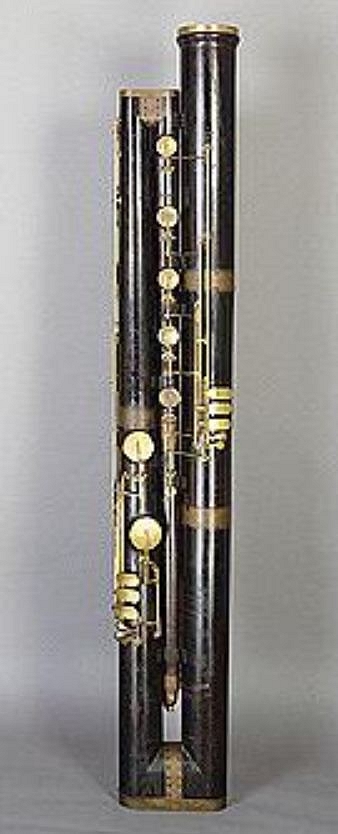 |
| Left: The Contrabassophone: 1850
The Contrabassophone was invented about 1850 by German bassoon maker Heinrich Haseneier, as an improvement on the Contrabassoon, which at that time was considered to give an excessively muffled sound. Haseneier seems to somewhat overshot the mark, as the Contrabassophone with its larger bore, and large tone holes covered by padded keys, was considered too powerful to fit in with an orchestra, and only a very few were made. His attempt to obtain a patent for it was refused.
Note the purposeful-looking 180-degree bends.
The lowest note of the Contrabassophone is C1, the lowest C on the piano or the contrabassoon, = 32.7 Hz.
The Contrabassophone greatly resembles the Contraforte.
The Contrabassophone has a page on contrabass.com.
https://en.wikipedia.org/wiki/Contrabassophone
Unfortunately no video of a Contrabassophone being properly played has so far been found by The Museum Staff. You can however see a video on the restoration of a Contrabassophone on YouTube, which has a few demonstration notes at the very end.
|
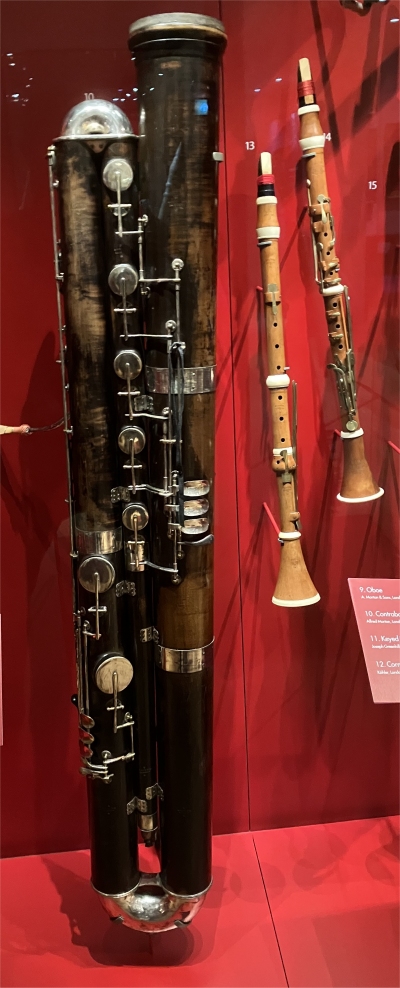 |
| Left: The Contrabassophone: 1850
Here is a better picture of a different Contrabassophone. This one is on display at the Royal College of Music Museum in London.
The display label says it was made by Alfred Morton of London in 1876. This is one of his copies of Haseneier's instrument. Note the bends are of rounded metal and are not square. From what can be seen of the keyworks it looks the same as on the original Contrabassophone.
There are some early clarinets in the background.
|
CLARINETS
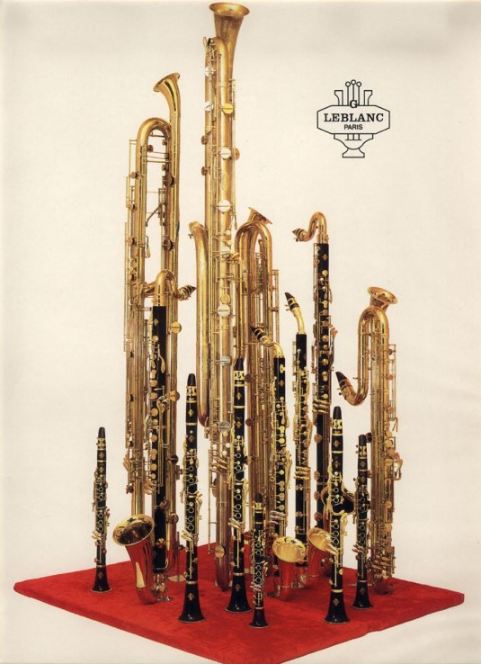 |
| Left: Clarinet collection
This is a collection of clarinets by LeBlanc, ranging from Eb soprano to Double BBb Contrabass. The distinguishing features of the clarinet are its single reed and an essentially cylindrical bore.
I'm not going to pretend I can identify all the instruments here, but I am sure that the Eb soprano is right at the front in the middle, and I think we can safely assume that the Double BBb Contrabass is the tallest instrument.
Clarinets in general have a Wikipedia page.
|
THE SOPRANO CLARINET
 |
| Left: A Soprano Clarinet:
The Soprano Clarinet is actually the 'standard' clarinet. It has a written range from the E below middle C (165 Hz) to about the C three octaves above middle C. (2093 Hz) The unqualified word clarinet usually refers to the Bb clarinet, which is by far the most common type to encounter.
The Soprano Clarinet has a rather short Wikipedia page.
|
THE ALTO CLARINET
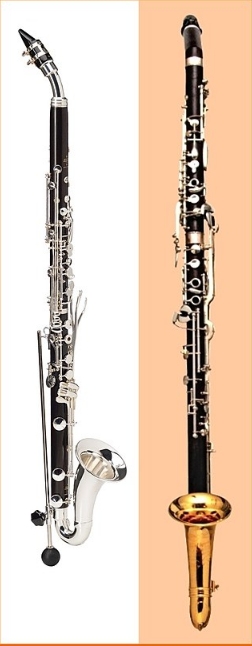 |
| Left: Alto Clarinets:
The Alto Clarinet is of an intermediate size between the standard clarinet (bottom note D3 = 146.83 Hz) and the Bass Clarinet. (bottom note D2 = 73.4 Hz) In appearance and range it resembles the Basset Horn.
It has not been much used in orchestral pieces; it is used mostly in concert bands and also plays an important part in clarinet choirs. There is a limited solo repertoire for the instrument.
The Alto Clarinet has a good Wikipedia page.
|
THE BASS CLARINET
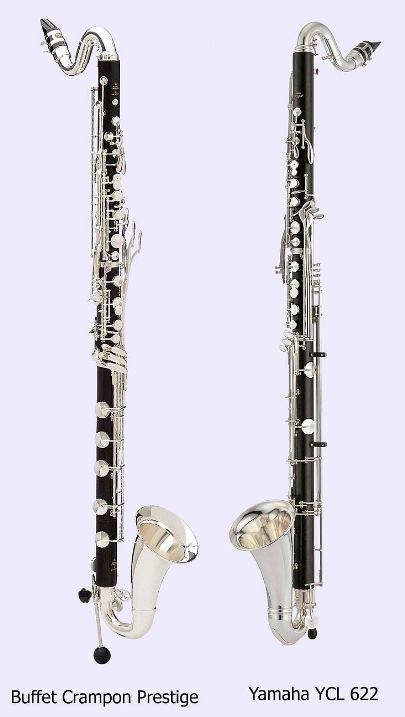 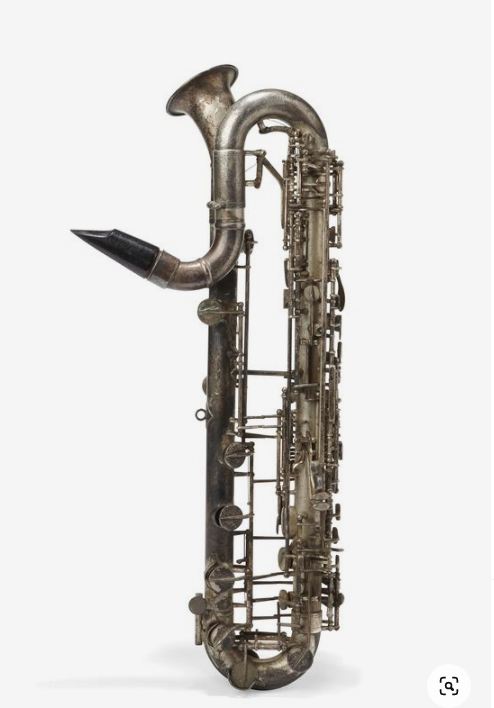 |
| Far Left: Conventional bass clarinets:
Left: Leblanc Bass Clarinet
The usual Bass Clarinet has its bore in one long straight tube, and it is rather too common to be called an Unusual Instrument. Note the foot-pegs for supporting the weight of the instrument.
The Bass Clarinet has a Wikipedia page.
|
  |
| Far Left: Bass clarinet with a loop in the tube to reduce the overall length:
Left: Leblanc Bass Clarinet
Source: Instrument in the Musical Instrument Museum, St Cecilias Hall, University of Edinburgh
|
THE CONTRA-ALTO CLARINET
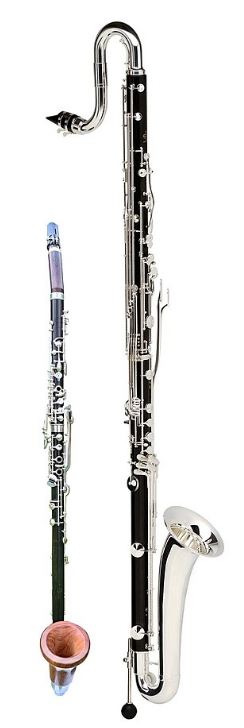 |
| Far left: Alto clarinet. Left: Contra-Alto Clarinet in Eb: contemporary
The Contra-Alto Clarinet is pitched a perfect fifth below the Bb Bass Clarinet, and is correspondingly longer. Note the greater tube length from the mouthpiece to the main bore, and the longer horn at the bottom. At far left is an Alto Clarinet for comparison; it is significantly shorter than the Bass Clarinet above.
The Contra-Alto Clarinet has a Wikipedia page.
|
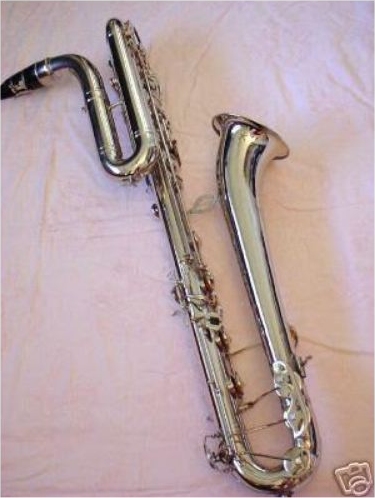 |
| Left: All-metal Contra-Alto Clarinet in Eb
This all-metal Contra-Alto Clarinet was made by Orsi for the Linton brand. Unusually it has saxophone fingering.
It also looks a bit like a saxophone, but the image shows the distinctive cylindrical bore of a clarinet.
|
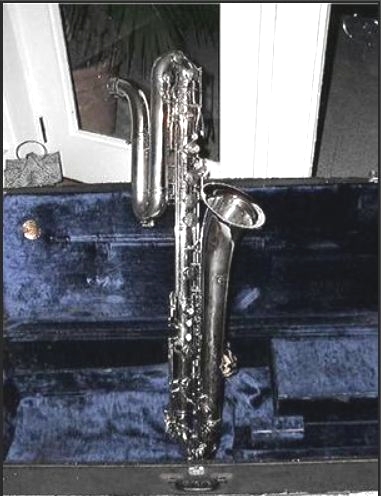 |
| Left: All-metal Contra-Alto Clarinet
Another picture of an all-metal Contra-Alto Clarinet. This is believed to be the same instrument as in the picture just above.
|
THE CONTRABASS CLARINET
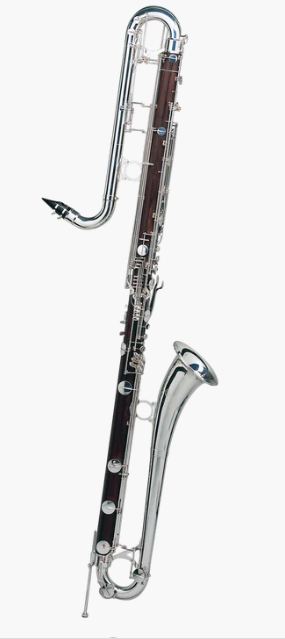 |
| Left: Contrabass Clarinet in Bb: contemporary
This contrabass clarinet is 2.31 meters long. Its range extends to an octave lower than the B-flat Bass Clarinet. It is made by Selmer, and will set you back a cool £29,268.73 each.
The Contrabass Clarinet has a Wikipedia page.
There is more info at contrabass.com.
|
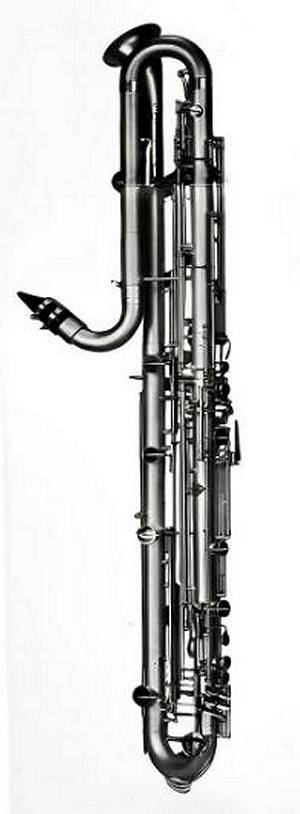 |
| Left: Contrabass Clarinet by Leblanc: date?
Since a Contrabass Clarinet built in a straight line is a rather unwieldy instrument, folded versions have been made.
This instrument by Leblanc has the tube running up from the mouthpiece, then down to the bottom, then up to the bell.
|
THE SUBCONTRABASS CLARINET
 |
| Left: Subcontrabass clarinet: 1935
Where advanced plumbing and music meet. The Subcontrabass or Octobass Clarinet is pitched an octave below the Contrabass Clarinet.
The bore goes down from the mouthpiece, up to the top, down to the bottom, and then up to the bell. If I understand correctly the lowest note was Bb0 (=29.1 Hz)
The Subcontrabass Clarinet has a page on contrabass.com.
There is more info on this instrument in a section of the Contrabass Clarinet Wikipedia page.
|
THE QUARTER-TONE DOUBLE CLARINET
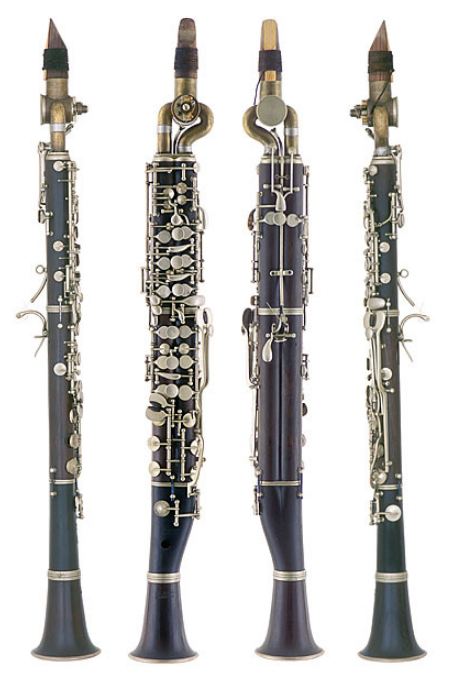 |
| Left: Quarter-Tone Double Clarinet: 1928
Some people think that quarter-tone music (24 notes per octave) is a good idea. It was proposed by 19th-century music theorists Heinrich Richter in 1823, and Mikhail Mishaqa around 1840.
Quarter tones can be played on a conventional clarinet, by using non-standard fingerings, but this is hard in rapid bits of music, and nominally identical clarinets give varying results. The instrument builder Fritz Schüller (1883-1977) took a radical approach to the problem in 1928 by building the double clarinet shown here.
There is a single mouthpiece connected to two parallel bores, one slightly longer than the other, giving effectively two clarinets tuned a quarter tone apart. A single set of keywork controlled the tone holes of both bores simultaneously, giving a very crowded look. A rotary valve just after the mouthpiece allowed rapid switching from one bore to the other, though it is not currently clear how this was actuated. The two bores join together at the bottom end to share one bell.
There is more info on this instrument Here.
There is a Wikipedia page for this instrument, but it is a copy of the content in the link above.
According to this link, quarter-tone cross fingerings are widespread, and apparently standard technique in French orchestral playing today.
This link gives details of a clarinet mouthpiece incorporating a hollow metal cylinder about 4 cm long and 1 cm across, containing a piston worked by a Bowden cable (like a bicycle brake cable) from a foot pedal. This can drop the pitch by up to a semitone, and sounds a good deal more practical than the Double Clarinet.
|
THE OCTAVIN
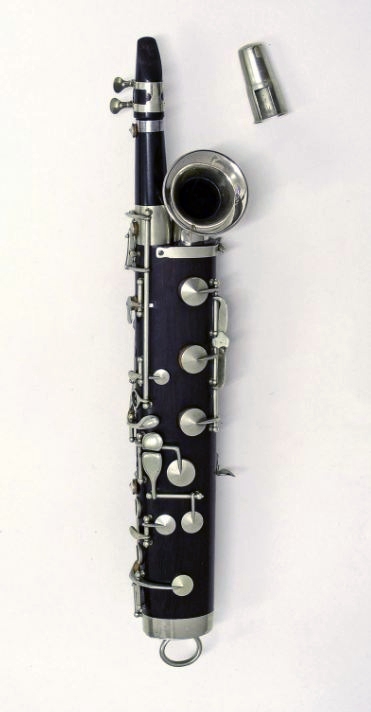 |
| Left: Octavin in F: 1881
The Octavin (or Oktavin) is a wooden-bodied single-reed instrument with a folded conical bore. It was invented in 1881 by Julius Jehring, a bassoon maker. It was not a commercial success.
The range range is similar to that of a soprano saxophone.
The Octavin has a short Wikipedia page.
|
 |
| Left: Another Octavin, this one in Bb: 1881
The keywork is almost identical to the instrument above. Note the protrusion out to the left, presumably so the left thumb could support the instrument,
Judging by the size of the mouthpiece, this could be quite a heavy instrument to hold up.
|
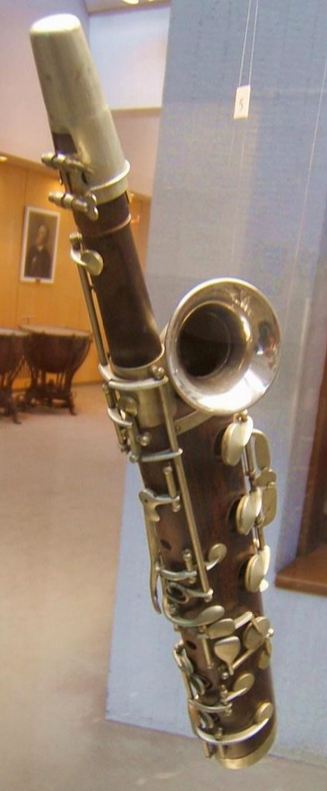 |
| Left: Another Octavin: 1881
The key of this instrument is unknown. It appears to be in a museum somewhere.
The photo gives a rather better view of the keywork, Note (ha!) that there is at least one, and probably two, plain holes stopped directly by the fingers.
Here the mouthpiece has been fitted at the wrong angle as the bell is supposed to point forward.
|
THE BASSET HORN
 |
| Left: Basset Horn in nominal pitch C: 1904
The Basset Horn is a member of the clarinet family, with a characteristic bend between the mouthpiece and the main body. The Basset Horn has additional keys that extend its range down to written C, sounding F, at the bottom of the bass stave.
The Basset Horn should not be confused with the Basset Clarinet, or the Clarinet d'Amore, but you probably will anyway. The Clarinet of Love? Something like the Walrus of Love?
The Basset Horn has a good Wikipedia page.
|
THE HECKELPHONE
 |  |
| Far left: Heckelphone in nominal pitch C: 1904
The Heckelphone is a double-reed nstrument similar to the oboe but (like the bass oboe) pitched an octave lower. It was invented by Wilhelm Heckel and his sons, on the suggestion of Richard Wagner. It has a significantly larger bore than an oboe, giving a heavier and more penetrating tone. It should not be confused with the Cor anglais, which is basically an alto oboe, and has a differently shaped bulge at the lower end.
Note that the Heckelphone has nothing to do with hurlng abuse at public meetings.
A distinguishing feature is the spherical bulge at the lower end. A Heckelphone is about 1.3 m (4ft 3in) long and is therefore rather heavy. It is usually rested on the floor, supported by a short metal rod attached to the underside of the bell
Only some 150 Heckelphones were been made, of which about 100 are believed to still exist.
There is an excellent Wikipedia page for the Heckelphone.
There is more info at contrabass.com.
You can hear a Heckelphone trio here. (Post #21)
.
Left: Heckelphone in St Cecilia's Museum, Edinburgh: 1907
Note that the keywork is different from the Heckelphone on the far left.
The museum label says: "Heckelphone, Heckel, Biebrich, Germany 1907".
Biebrich is a borough of the city of Wiesbaden, Germany.
To the right of the Heckelphone is a bass oboe, not a cor anglais.
|
FLUTES
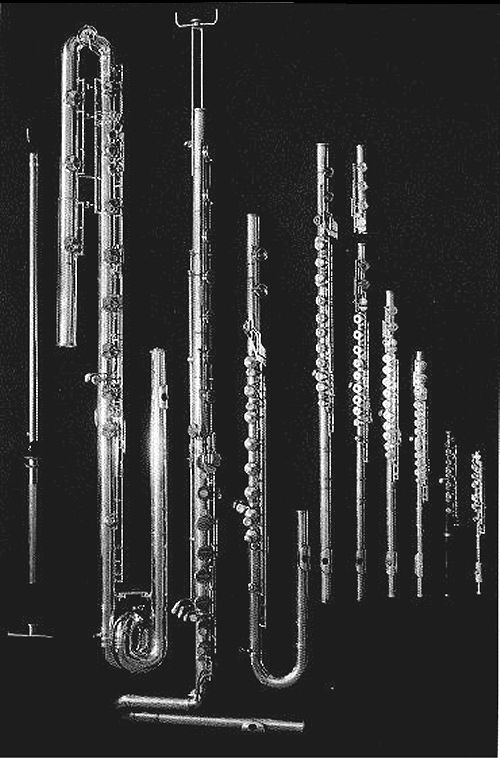 |
| Left: A diverse collection of Flutes
I am particulary intrigued by the flute second from left, which not only has a recurve at the bottom end, but also a recurve at the top (blowing) end, plus a complete 360-degree spiral. Probably a contrabass flute, but hard to be sure.
The third from right is also worthy of note. there is a U-bend at the blowing end, and an extended bracket at the other, presumably so you could rest the end on the floor without obstructing the open end of the bore. That is, I believe a bass flute. Bass flutes are often made in a J-shape. (recurve)
As to the thing on the extreme left, I have no idea what it is. Can anyone help?
Flutes have a good Wikipedia page.
|
 |
| Left: The International Superflutes Collective
The International Superflutes Collective is a flute-playing organisation with a core of 12 members that plays globally. Christine Beard (see below) is a member. The instrumentation covers everything from piccolo to contrabass flute.
I hesitate to try to identify the flutes, but there is a Contrabass Flute at bottom right, and at least four flutes with a recurve that are either Alto or Bass flutes.
There is more info here.
You can hear them on YouTube
|
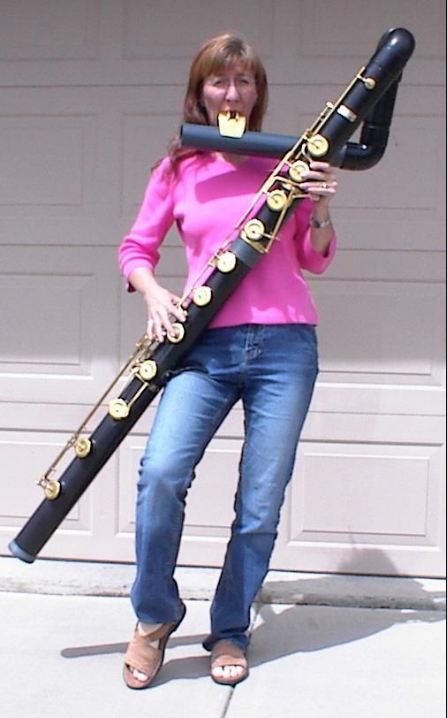 |
| Left: A Contrabass Flute
Contrabass Flute made from PVC drainpipe. So far this image has not been identified.
The making of Big Flutes is much simplified because the Flute has a cylindrical bore; this means you can make big flutes from sections of PVC drain-pipe. I have not heard of anyone attempting to make a conical-bore Oboe in this way.
This is a common shape for a Contrabass Flute.
The Contrabass Flute has a Wikipedia page.
|
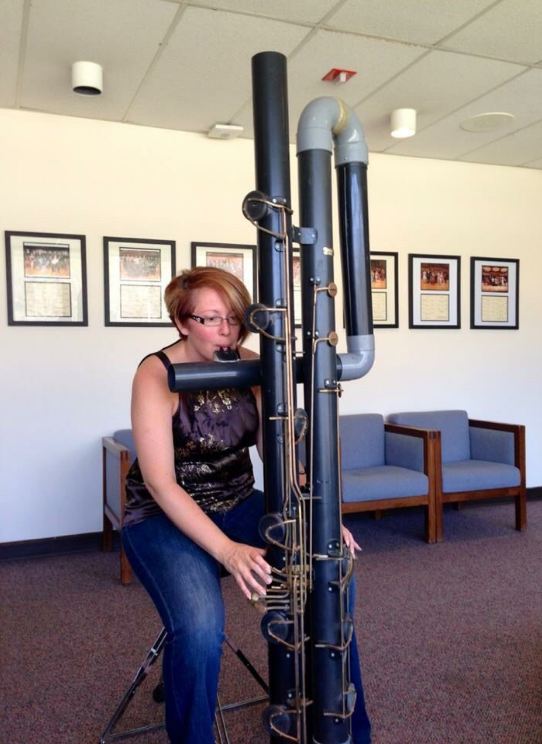 |
| Left: A Subcontrabass Flute
The Subcontrabass Flute is twice as long as the Contrabass Flute and accomodating of all the pipework starts to be a problem.
This drainpipe Subcontrabass Flute belongs to Christine Beard. This image is about on the Internet, captioned: "Trying to learn to play my subcontrabass flute!" which suggests playing it is not too easy.
The Subcontrabass Flute has a Wikipedia page.
|
UNUSUAL HARMONICAS
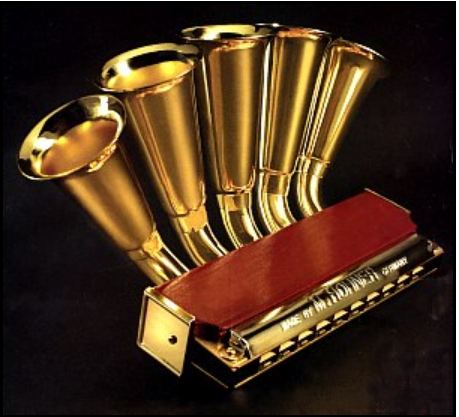 |
| Left: The Trumpet Harmonica
This is a Trumpet-Call Harmonica, made by Hohner between 1907-1930. A limited edition was produced recently in 2005-2008.
Rather disturbingly, I have found nothing on the Interwebs about the effect of the five horns on the sound; it might well alter the timbre, but I should have thought it a safe assumption that the volume would be much increased as the horns improved the coupling to the impedance of the air. The adverts I have seen only stress its arresting appearance on stage.
There is more info here on Reddit.
|
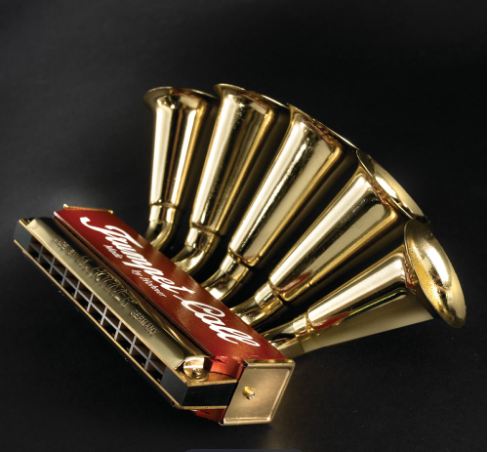 |
| Left: The Trumpet Harmonica
|
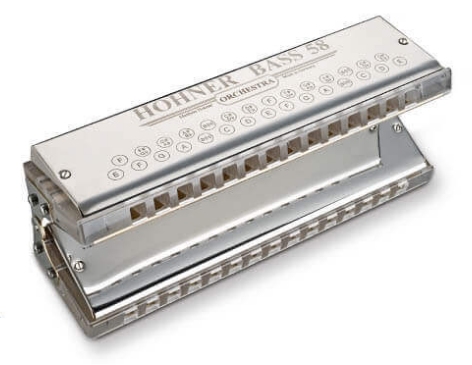 |
| Left: The Bass Harmonica: now
A Bass Harmonica is naturally one that produces lower notes. This is the Bass 58 by Hohner which has a chromatic range of E2 - E4 in SPN. (82 Hz - 329 Hz) It has 29 holes in the two combs, and each note is sounded by two reeds tuned an octave apart
There is more info on the Hohner website.
You can hear it being played on YouTube.
|
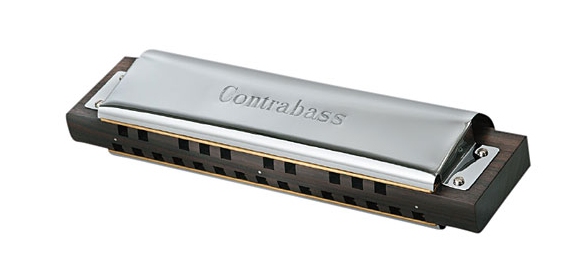 |
| Left: Contrabass Harmonica: now
But is there such a thing as a Contrabass Harmonica? Of course there is. This is a Tombo 1140R Contra Bass which has a chromatic octave range C0 to C1 in SPN. There are 25 tone holes which suggest two reeds are used for each note. The rosewood body is 30 cm long. The reeds are of the kind normally found in the bass section of an accordion. It costs £580.
There is more information here. Tombo is a Japanese company.
Regrettably there seems to be no such thing as a Subcontrabass harmonica. Could be gap in the market there...
|
 |
| Left: The Roll-monica: 1925
This bizarre gadget is a harmonica that reproduces the notes on a miniature pianola roll. Presumably you had to synchronise your blowing with the music; looks like it might be case for circular breathing. The case was made of Bakelite. It was more a toy than a serious instrument.
Usually harmonicas give different notes on blow and suck, which in this case would mean you had to breathe to suit the music. It seems more linely that the harmonics section was blow-only.
New tune rolls could be bought for 10 cents each.
Source: the book Clockwork Music by Arthur Ord-Hulme. Pub: George Allen & Unwin, 1973
|
 |
| Left: The Roll-monica and friends: 1925
A nice box of Roll-monicas, with their tune rolls.
The instrument on the left is a QRS PlayaSax and that on the right a QRS Clarola. These worked on the same pianola principle as the Roll-monica.
|
STRINGS
THE TEN-STRING GUITAR
 |
| Left: A Decacorde 10-string Guitar: 1826
This 10-string guitar has five fretted strings and five unfretted sympathetic strings. The latter can also be played but only one note is available per string.
Made by Rene LaCote of Paris, France, in 1826.
There is much more info here.
There is a Wikipedia page for 10-string guitars.
Source: Instrument in St Cecilia's Music Museum, Edinburgh. Author's photograph: 15th Aug 2024
|
There are also guitars with other numbers of strings:
There is a Wikipedia page for 7-string guitars. They are also called Russian Guitars or Gipsy guitars,
There is a Wikipedia page for 8-string guitars.
There is a Wikipedia page for 9-string guitars.
There is a Wikipedia page for 12-string guitars; in their normal form with six doubled strings they are not unusual.
There are also 11-string guitars, 13-string guitars, 14-string guitars, 16-string guitars, 17-string guitars, 18-string guitars, 20-string guitars, and 30-string guitars; none of these have Wikipedia pages, but info can be found via Google. This list is unlikely to be complete.
THE STROH VIOLIN AND OTHER STROH INSTRUMENTS
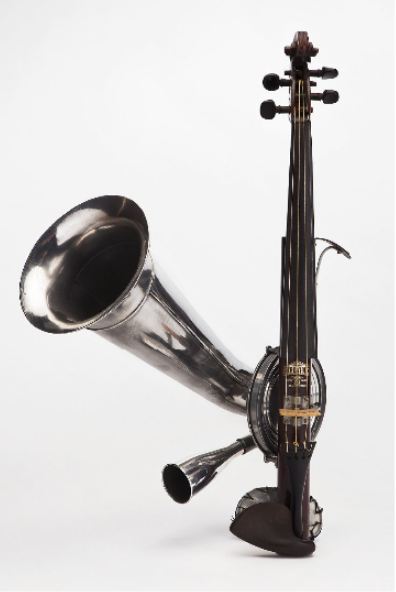 |
| Left: The Stroh Violin
This is a Stroh Violin. At the beginning of the 20th Century, German inventor Johann Matthias August Stroh (1828 - 1914) developed a variety of horn-amplified stringed instruments, including Stroh-Violins, Stroh-Cellos, Stroh-String Basses, Stroh-Mandolines and Stroh-Ukuleles.
The body is reduced to a skeleton, and the bridge is fixed to a metal diaphragm that drives the horns. There are two horns, the main one for projecting the sound, and the smaller one pointing at the player so he could hear what he was playing; a very early form of foldback. The motivation was to create enough volume for early recordings which were strictly acoustic. According to some: "Chances are, if you listen to a violin recording dating before 1925, you're hearing a Stroh violin."
There is more info here.
|
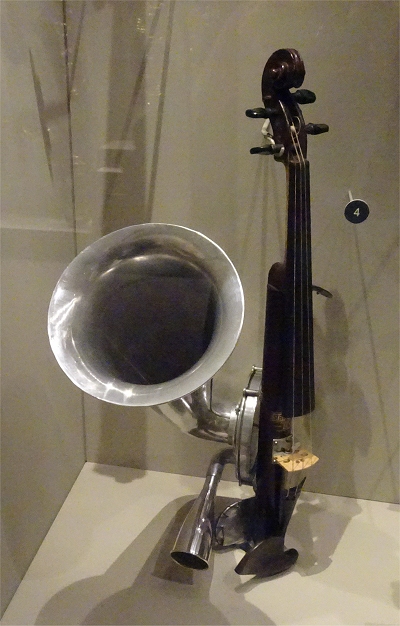 |
| Left: The Stroh Violin
Another Stroh Violin with foldback horn; actually this may be the same instrument as in the picture above.
The Stroh Violin has a Wikipedia page.
Source: Instrument in St Cecilia's Music Museum, Edinburgh. Author's photograph: 15th Aug 2024
|
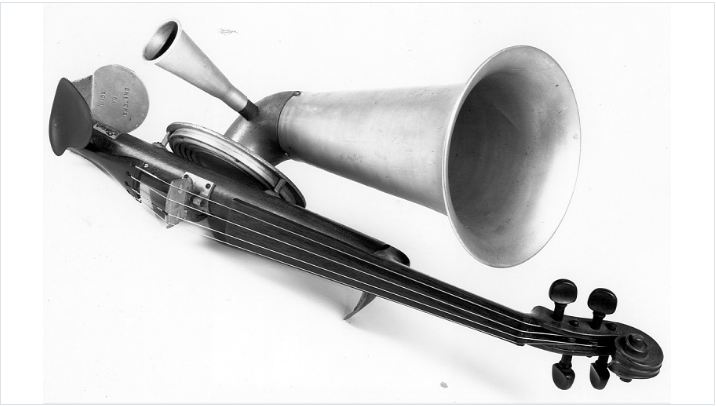 |
| Left: The Stroh Violin
Another Stroh Violin. In this case the foldback horn is tapped off the main horn, rather than having a separate drive from the diaphragm.
The Stroh Violin has a Wikipedia page.
|
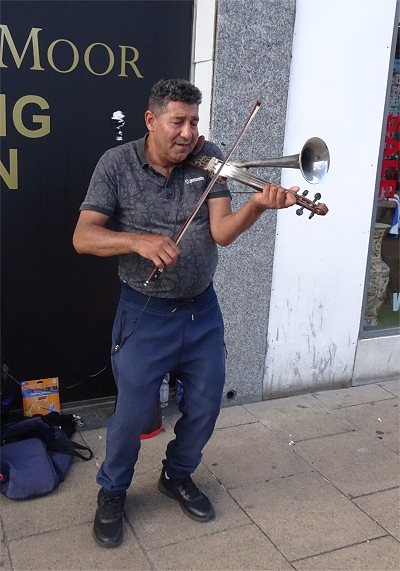 |
| Left: The Stroh Violin in action
Busker with Stroh violin seen in Princes Street, Edinburgh. It was really quite loud; the tone sounded alright to me but I am no expert on violins.
There is no foldback horn on this version.
Author's photograph: 10th Aug 2024
|
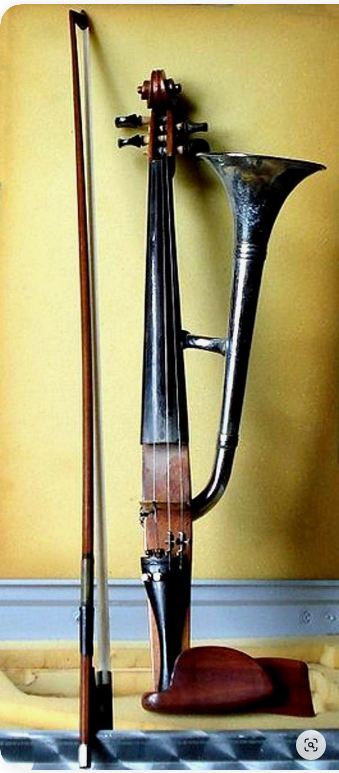 |
| Left: Romanian Horn-Violin
The Stroh Violin has pretty much disappeared in most places, but it lives on as the Romanian Horn-Violin.
But is it actually derived from the Stroh concept? There is no sign of a circular container for a diaphragm. Currently not clear how this works.
Note absence of any foldback horn.
The Romanian Horn-Violin has a section on the Stroh Wikipedia page.
|
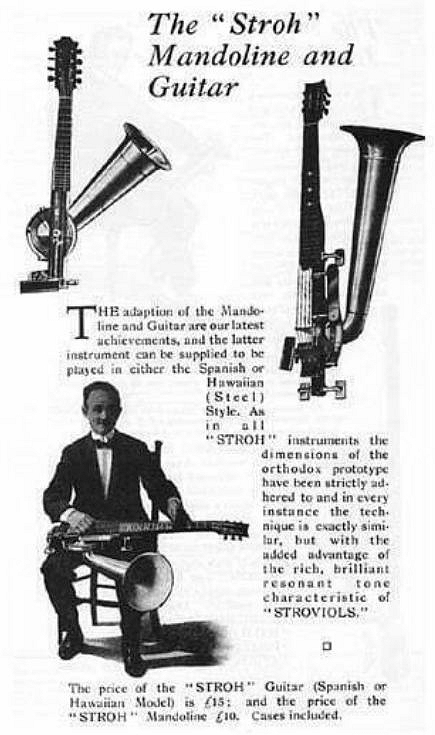 |
| Left: The Stroh Mandolin, Spanish and Hawaian Guitars
The Mandolin is clearly the instrument at top left, because it has eight tuning pegs. (four pairs of strings tuned in unison pairs) To the right is the Spanish Guitar and bottom left the Hawaiian Guitar.
No foldback horns here either.
There is more info Here.
|
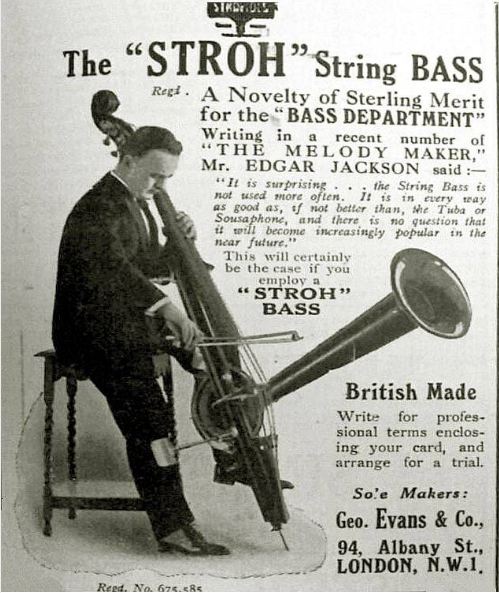 |
| Left: The Stroh String Bass
A String Bass with a quite serious horn attached.
Perhaps the most ineresting feature of this ad is the discreet weight attached to an arm to the left of the instrument; I suspect this was an attempt to balance the weight of the horn. Or is it a support pad resting on the player's right leg?
Come to that, why is the player perched on a table rather than sitting in a chair? Because a chair would be too low to allow the instrument to be playesd? And why is is left leg in the air?
You can hear a Stroh Double Bass, Cello and Violin on YouTube. To be honest, the instruments don't sound too good. The ensemble is playing in an anechoic chamber, which may be just as well. The bass player is standing up.
|
 |
| Left: The Stroh Ukulele
This rather disturbing instrument is a Stroh Ukulele. Note the hinged bridge that connects to a strut driving a diaphragm, which is in turn coupled to an essentially conical horn. There is no foldback horn.
There is more info here.
|
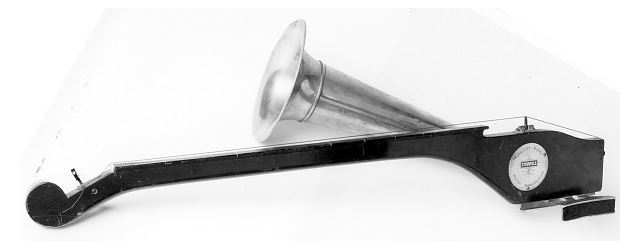 |
| Left: The Stroh Japanese fiddle
This Stroh instrument is known as the Japanese fiddle or One-String Jap fiddle. (no disrespect intended) Its production was probably stimulated by the Japan-British Exhibition held in London in 1910.
The Fiddle was produced in three models: “Home,” “Concert” and “Professional,” priced at 35s, £3 and £12 respectively.
There is more information Here.
|
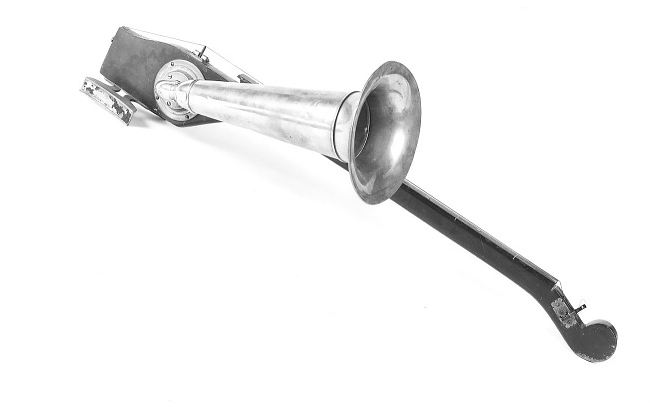 |
| Left: The Stroh Japanese fiddle
There is no foldback horn.
|

THE BASS BANJO
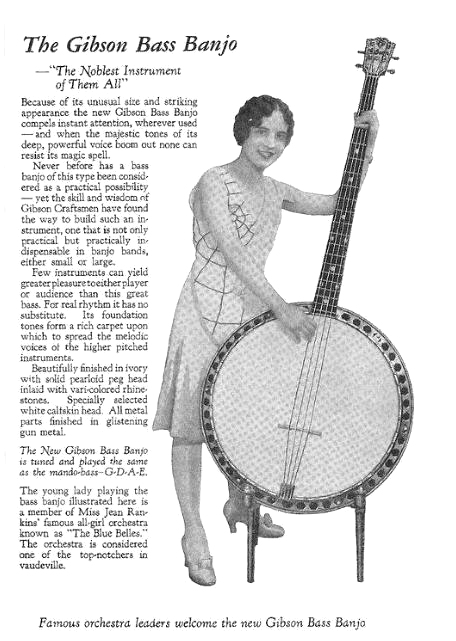 |
| Left: The Gibson Bass Banjo
This 4-string Bass Banjo is a hefty instrument. The blurb says it is tuned G-D-A-E, the same as a mando-bass. A what? More research urgently required.
The Bass Banjo has a Wikipedia page.
It is not clear if it has two, three, or four legs to support it. The young lady clearly only needs two.
|
THE CONTRABASS BANJO
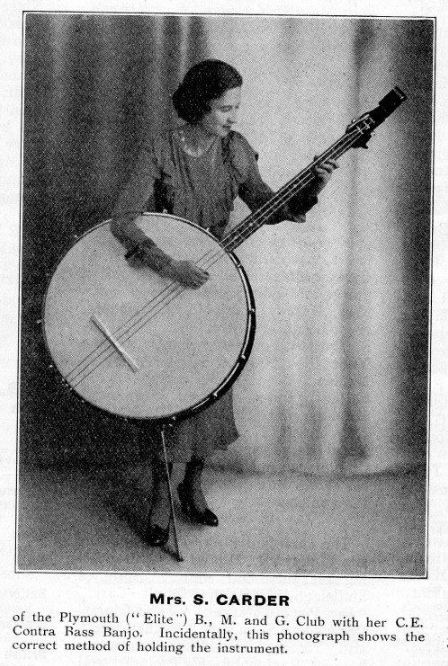 |
| Left: The C E Contrabass Banjo
Mrs Carder grapples with a 3-string Contrabass Banjo. The body looks even larger than the Bass Banjo illustrated just above.
I can't help wondering what is the incorrect method of holding the instrument. Sounds like it might be rude.
|
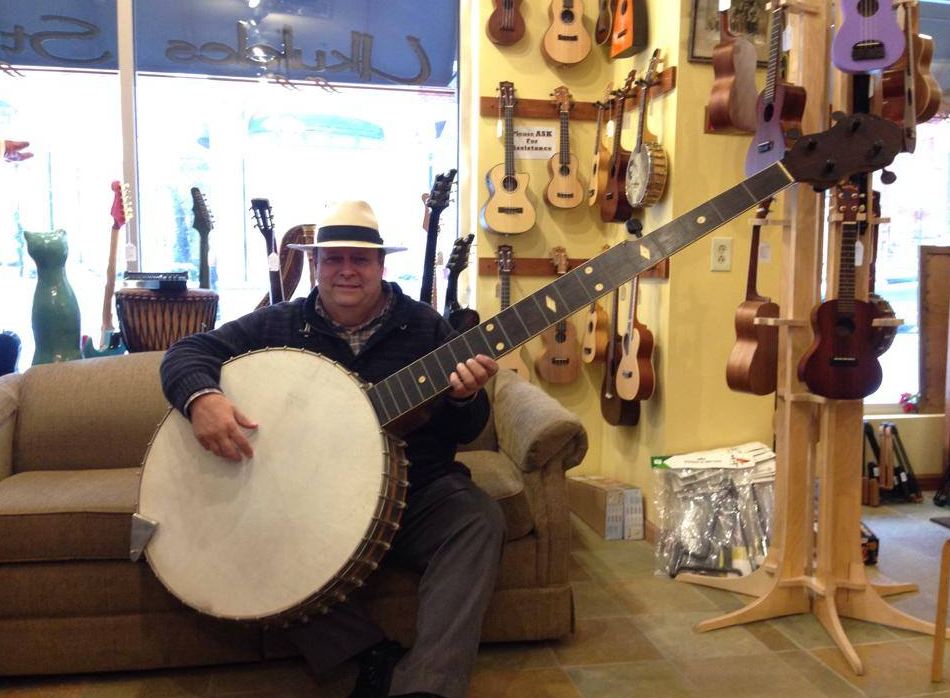 |
| Left: A Fairbanks Contrabass Banjo
This is an A C Fairbanks Contrabass Banjo, missing its five strings. (one only goes halfway up the neck) It was criticised because the upper frets were too far apart for practical use. It is 79.5 inches (6.7 feet) in overall length, with a 25.5 inch rim, and a 60 inch scale.
It is offered for sale at £16,370.91 + delivery. For that sort of money I think I'd insist on strings.
|
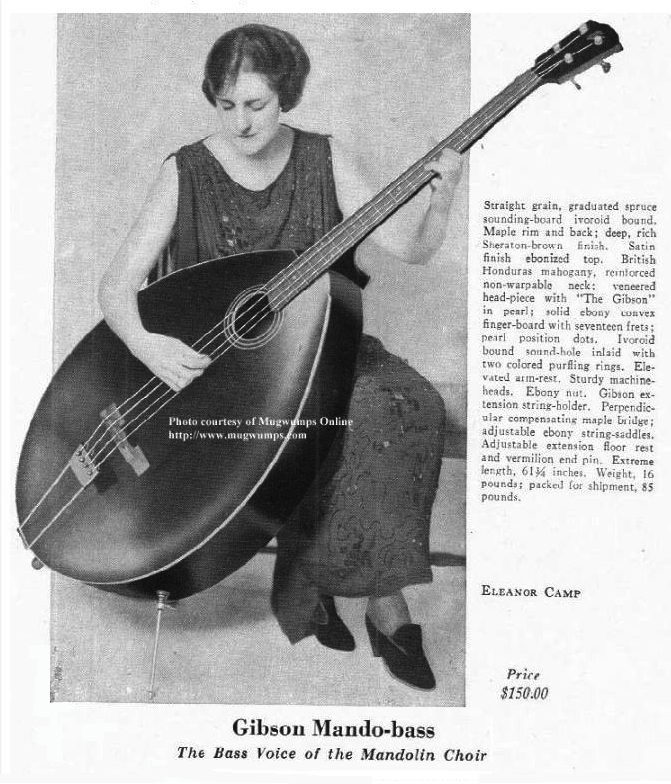 |
| Left: A Gibson Bass Mandolin
This instrument is often called a Mando-Bass. Note the spike at the bottom to support the instrument.
One admires the determination of Eleanor Camp in grappling with this machine. The rather odd name seemed vaguely familiar; then I thought of Ada Camp, who I have seen and is rather funny.
|
HARP-GUITARS
A Harp Guitar is mostly a guitar but has also unstopped strings that can be plucked like a harp.
 |
| Left: Two Harp Guitars: date unknown
This doughty couple clutch their harp guitars. The one on the right is presumably a bass or baritone version of the smaller one.
The smaller instrument has 11 harp strings, and the larger 15. Note both have two sound-holes and some sort of reinforcing strut for the harp section.
The larger harp guitar has a pointy thing stuck on at bottom left; this may have been a knee-rest to make the instrument easier to hold.
Harp guitars have a Wikipedia page.
|
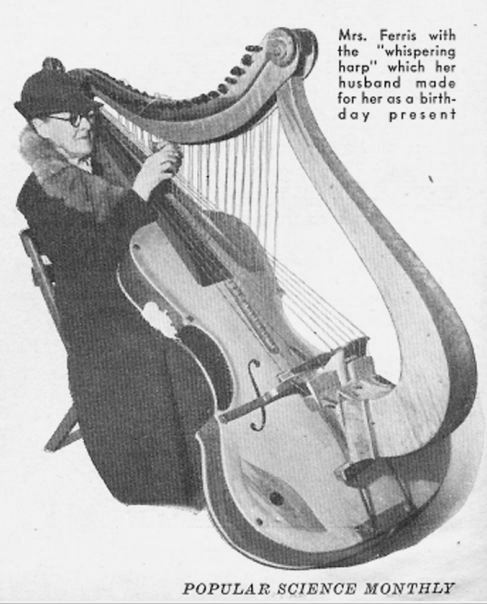 |
| Left: Ferris Harp Guitar: c 1938
Having started off with two (relatively) conventional harp guitars, we move on to unusual harp guitars.
This unnatural combination of a cello (or guitar?) and two harps was made by Arthur K Ferris, a landscape gardener of New Jersey, USA. One harp is obvious, being fixed vertically to the cello, while the second is made up of the unstopped strings on the far side of the cello.
You can read a Popular Science article (June 1938) on Arthur K Ferris here.
|
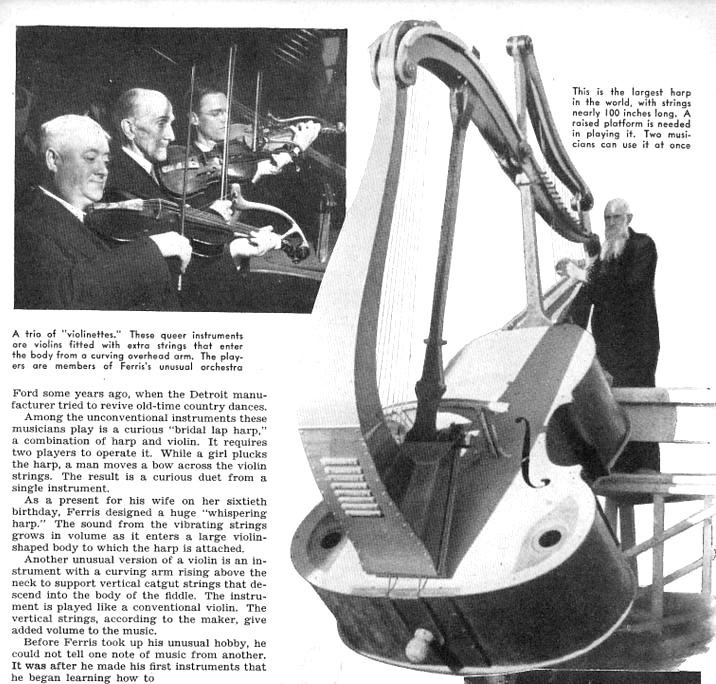 |
| Left: Ferris Harp Guitar: c 1938
Truly odd. This thing is essentially a harp with a huge double-bass body, with not much of a guitar about it.
Source: Popular Science June 1938, article on Arthur K Ferris here.
|
THE COMBOLIN
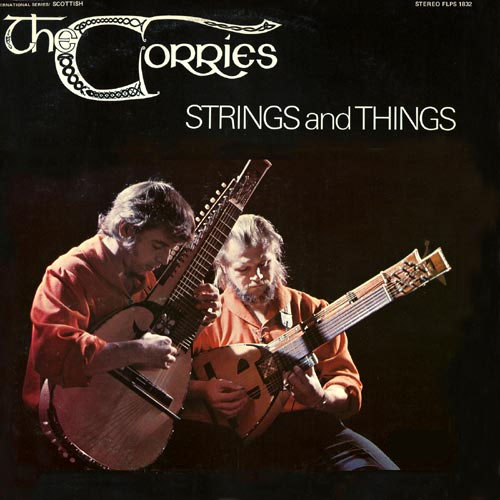 |
| Left: Two Combolins
The Combolin comcept was introduced by Roy Williamson of The Corries in 1969. The combolin on the left combines a guitar and a Spanish bandurria; it also has 13 sympathetic strings, as on a sitar, presumably tuned in semitones to cover an octave. These are presumably tuned by the row of pegs at the bottom of the instrument, but both the Comblins shown here have these bottom pegs. The situation is currently unclear.
The Combolin on the right combines a mandolin and a guitar, plus four bass strings operated with slides. I am by no means sure I have them the right way round. Any assistance would be welcome...
|
 |
| Left: Two Combolins
These appear to be the two Combolins pictured above.
|
KEYBOARDS
THE TERPODION
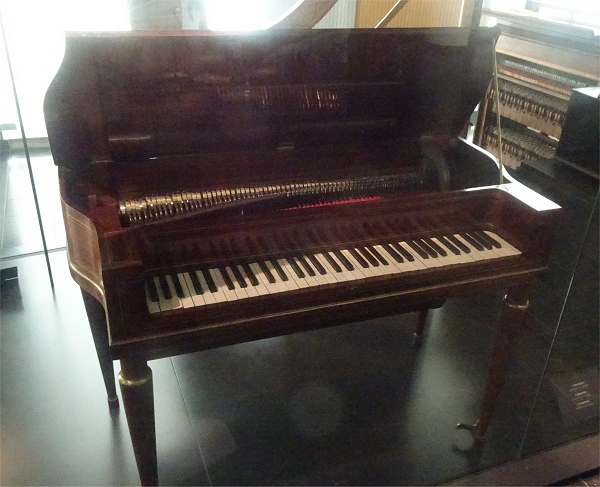 |
| Left: A Terpodion in Brussels
This is a Terpodion, on display at the Musical Instruments Museum in Brussels, Belgium; (MIM) I visited it in June 2025, and discovered any number of instruments I'd never heard of. The Terpodion was just the first. The keyboard pushes a wooden or metal arm against a rotating wood cylinder coated with a special high-friction compound, the arm vibrates and a note is produced. It was invented by Johann David Buschmann; his son sold a licence to the instrument builder David Loescham and cheesemonger (!) James Allwright. They only built one, the instrument shown here. Only 25 instruments were built in total.
The Terpodion apparently required little tuning, but quite a lot of other maintenance due to its frictional operation.
The label credits this instrument to Daniel Loescham and James Allright; London, 1840.
The Terpodion has a Wikipedia page, that includes a video of a Terpodian being layed, with the cylinder rotated by a foot treadle. It sounds pretty dreadful, and it is perhaps surprising that as many as 25 were made.
Author's photograph MIM June 2025
|
THE CLAVIHARPE
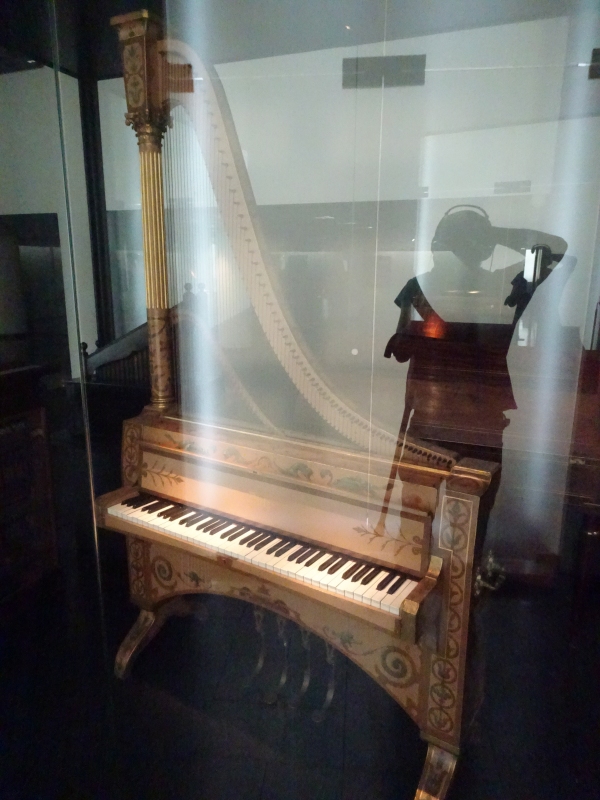 |
| Left: The Claviharpe: 1813
The Claviharpe was a harp played with a keyboard rather than being plucked manually. It was invented by Johann Christian Dietz in 1813, with the intention of eliminating some of the problems of the traditional harp, such as unstable tuning due to ambient conditions. The strings were plucked rather than being struck (as in a piano) and it was essentially an upright harpsichord.
This one is on display at the Musical Instruments Museum in Brussels, Belgium. (MIM) Apologies for poor picture quality but you can only do so much when everything is enclosed in vitrines. The museum lable credits it to Johann Christian Dietz in 1850.
Note the four pedals, currently of unknown function, though one was almost certainly a damper.
The Claviharpe has a Wikipedia page.
Author's photograph MIM June 2025
|
THE CLAVICYTHERIUM
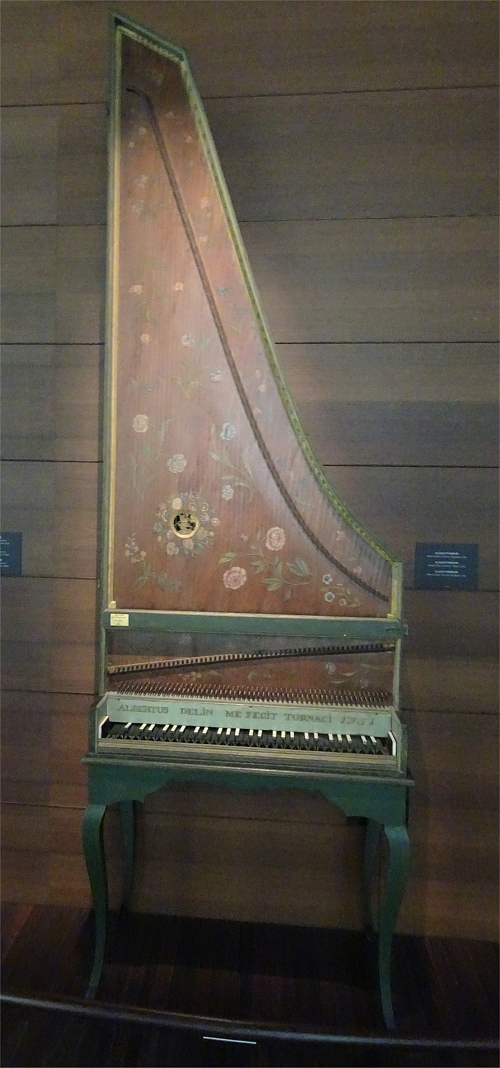 |
| Left: A Clavicytherium: 1751
The Clavicytherium, like the Claviharpe just above, is essentially a vertical harpsichord. This greatly reduced the floor space the instrument took up, but a serious snag was that the jacks that did the string-plucking moved horizontally rather vertically, so gravity did not restore them to the rest position when the key was released; some sort of spring was required. There seems to have been great difficulty in coming up with a satisfactory action.
This one is on display at the Musical Instruments Museum in Brussels, Belgium. (MIM)
The label attributes this instrument to Albert Delin of Tournai, Belgium, in 1751; he apparently did come up with a satisfactory action.
The Clavicytherium has a Wikipedia page.
Author's photograph MIM June 2025
|
THE LUTHEAL
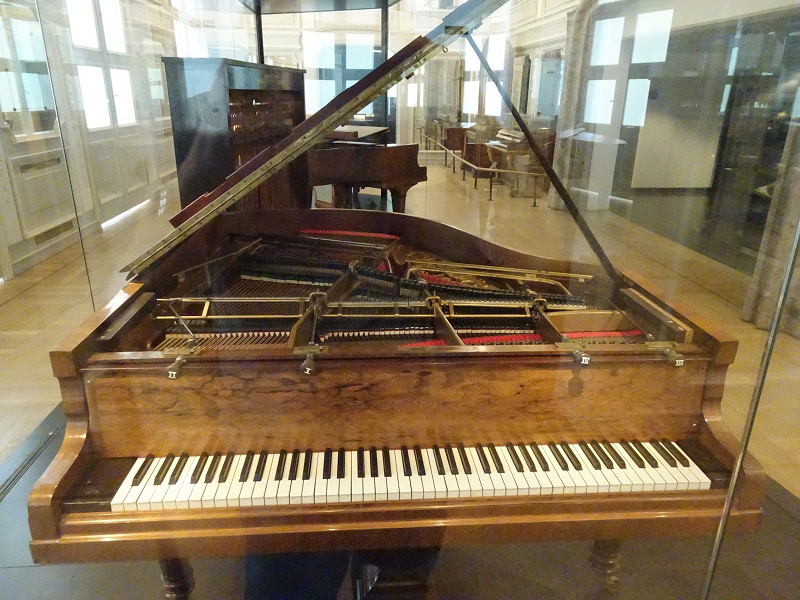 |
| Left: A Lutheal in Brussels: 1910
This is a Lutheal, an instrument I had never heard of before visiting the Musical Instruments Museum in Brussels. (MIM) It was invented by Georges Cloetens.
A Lutheal is essentially a piano, but with extra mechanisms added to produce alternative sounds like that of a harpsichord, harp, etc. It did not catch on, partly because the additional mechanisms required constant adjustment. This is the only remaining original luthéal in the world; it has been restored to its original condition. Well done everybody.
The accompanying label reads: Pleyell, Woolf, Lyon & Co/Georges Cloetens, France/Belgium 1887-1910.
On display at the Musical Instruments Museum in Brussels, Belgium. (MIM)
The Lutheal has a Wikipedia page.
Author's photograph MIM June 2025
|
THE PEDAL PIANO
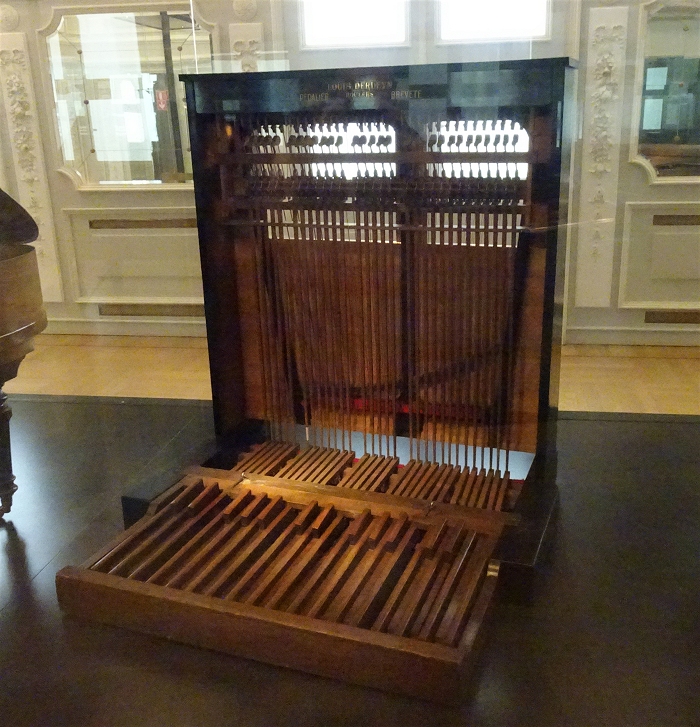 |
| Left: A Pedal Piano in Brussels: 1910
Here is another instrument I had never heard of before visiting the Musical Instruments Museum in Brussels. (MIM)
A pedal piano adds extra notes in the deep bass to a conventional piano. This is a vertical model, that presumably had the conventional piano fixed in front of it. Horizontal versions, that would fit under a grand piano were also made. The Museum label credits it to Louis Derdeyn. around 1885-1910.
The most common use of a pedal piano is to enable organists to practice at home.
The Pedal Piano has a Wikipedia page.
Author's photograph MIM June 2025
|
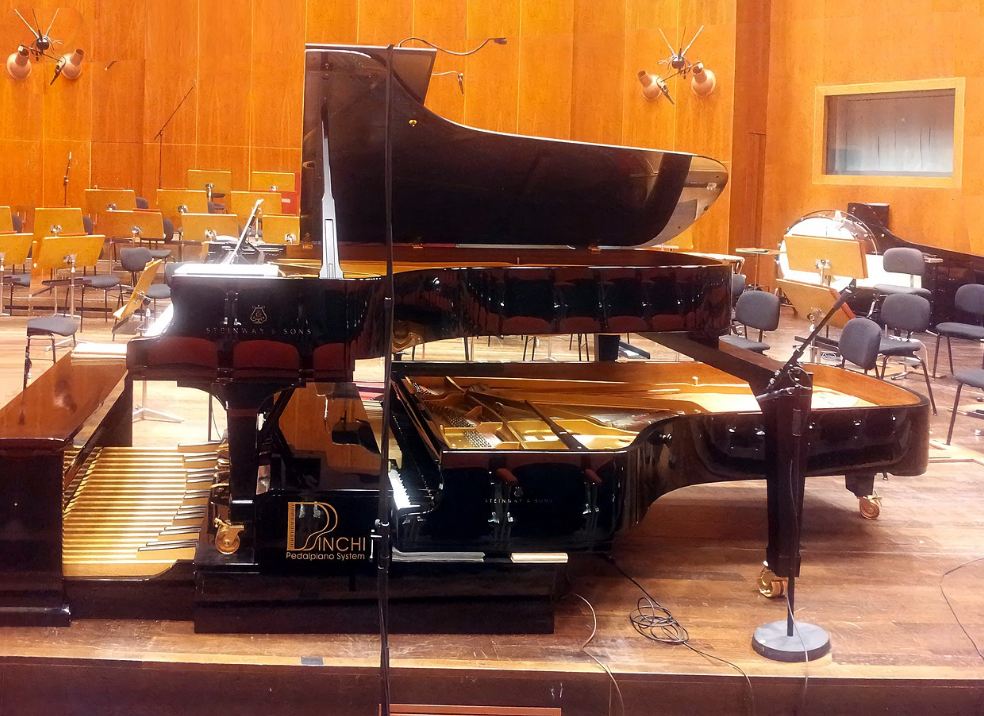 |
| Left: A Pinchi System Pedal Piano
This shows a horizontal pedal piano. The unnatural coupling is composed of two grand pianos, the lower being the pedal piano. I think the Pinchi logo is very cool.
There is some more info here.
|
THE PRACTISE CARILLON
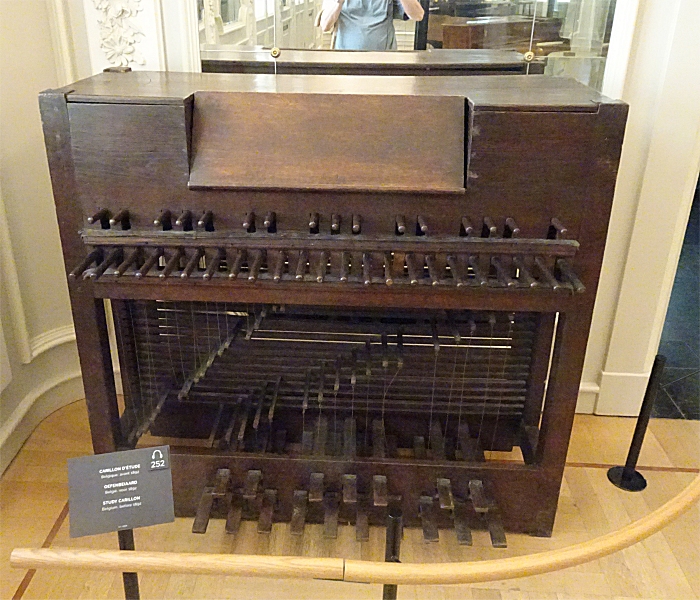 |
| Left: A Practise Carillon
A Carillon is a set of bells on which you can play tunes, either by pushing levers or operating pedals. Usually they consist of large bells hung in a high tower, so the music rings out over the town. This raises the question of how to practise before being loosed on the public, and the Practise Carillon (also called the Study Carillon) is the answer. Usually metal tone bars or metal tubes are used to make the sound rather than conventional bells. The museum label says only that it is Belgian and was built before 1892.
Carillons with 23 to 27 bells and 35 to 39 bells are classified as two-octave and three-octave Carillons, respectively. The two largest Carillons in the world both have 77 bells.
There is a video of a Practise Carillon being played on YouTube. Rather clattery and unimpressive.
For a home-made Practise Carillon with details of the works see YouTube. Also clattery...
The Carillon has a very comprehensive Wikipedia page, and I really don't think I'm going to be able to improve on it here.
Author's photograph MIM June 2025
|
THE TUBAPHONE
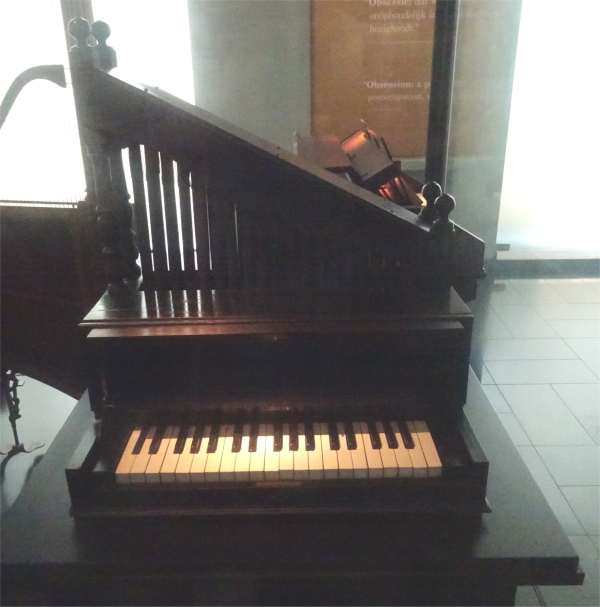 |
| Left: A Tubaphone: 1850
A Tubaphone sounds as though it ought to be a big brass instrument, but in fact it is a set of tubular bells; here they are played by a keyboard, though Tubaphones laid flat and played with hammers like a xylophone are more common.
A 'Tubaphone' sometimes refers to a kind of banjo made by the Vega company, modified to give a more powerful and louder sound. They spelled it Tub-A-Phone. There is more info here.
The MIM label just says 'Anonymous circa 1850'.
You can hear a flat tubaphone and a glockenspiel on YouTube. They sound very similar.
The Tubaphone has a very short Wikipedia page.
Author's photograph MIM June 2025
|
THE PIANO-VIOLA
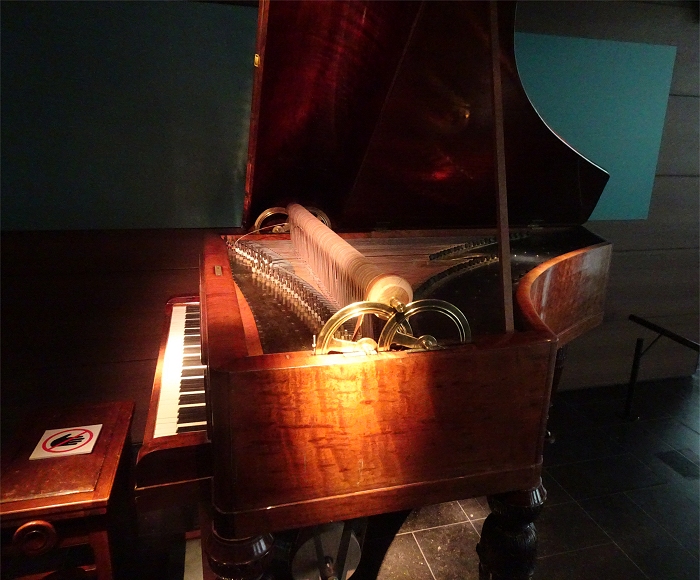 |
| Left: A Piano-Viola: circa 1835
Behold the Piano-Viola, or Viola Organista, as it is sometimes known. When a key is pressed a frictional belt rubs on a string. The roller carrying the belts is placed above the strings, and rests on four big brass wheels to reduce friction, as this is one place where you don't want it. At bottom centre a flat belt can just be seen; this connected a hand crank to the roller. This was operated by an assistant.
The Viola Organista has a good Wikipedia page.
The MIM label says it was built by Herman Lichtenthal of Brussels, circa 1835.
Author's photograph MIM June 2025
|
THE ISOMORPHIC KEYBOARD
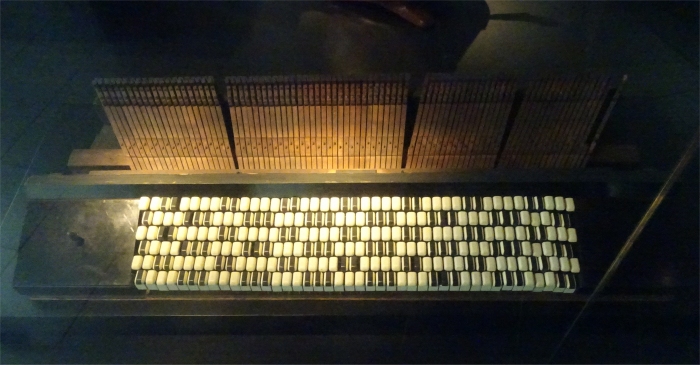 |
| Left: An Isomorphic Keyboard: circa 1900
An isomorphic keyboard is one laid out so that any given sequence and/or combination of musical intervals has the "same shape" on the keyboard wherever it occurs– within a key, across keys, across octaves, and across tunings. Isomorphic keyboards have a Wikipedia page, which explains it very well. Many different layouts are possible.
The museuam label says this one was made by Paul von Janko in Berlin, circa 1900.
Author's photograph MIM June 2025
|
THE BANDONEON
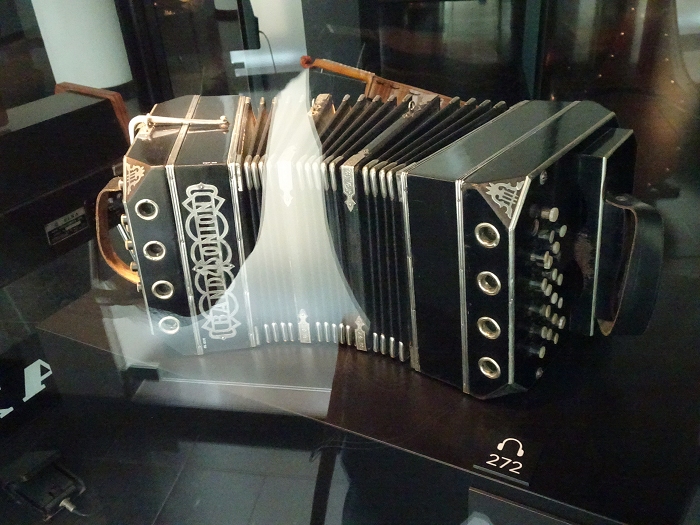 |
| Left: An Isomorphic Keyboard: circa 1900
This is not a concertina as such; it is a development of it called the Bandoneon. It is much associated with the Tango dance. The Bandoneon is usually Bisonoric, (a word I have never encountered before) which means you get different notes when you push or pull the bellows; this makes it hard to learn. Some Badoneons are monosonoric, as is the piano-accordian. Many tango players play almost entirely while pulling the bellows; on pushing them shut an air release button allows rapid closing.
The Bandoneon was invented by Heinrich Band. Looks like another case of Nominative Determinism.
The museuam label says this one was made by Alfred Arnold in Chemnitz, Germany, circa 1920.
Author's photograph MIM June 2025. Sorry about the reflection, but what can you do? I know, use a polarising filter. But my compact camera has no provision for filters.
|
THE DOUBLE PIANO
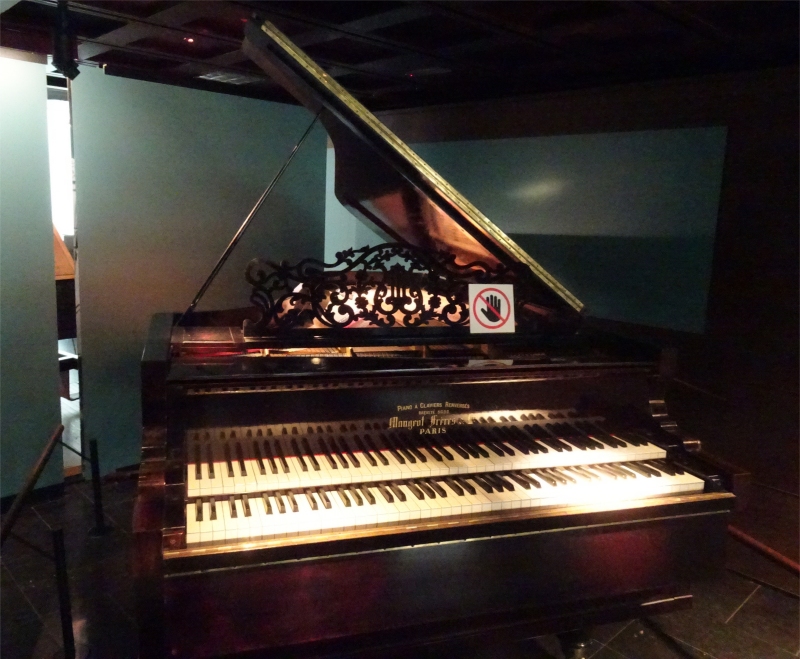 |
| Left: Double Grand Piano: 1879
This is a Double Piano. It has two keyboards, but only one set of strings. The upper keyboard sounds an octave higher than the lower by using mechanical linkages. This allows complex chords and large intervals to be played that are difficult or impossible on one keyboard; With just one hand the player can cover an interval of two octaves
There is more info on the Met Museum site.
The museum label says: "Double Grand Piano with mirrored keyboards: Mangeot Freres et Cie, Paris, 1879"
Author's photograph MIM June 2025
|















































































































































































































